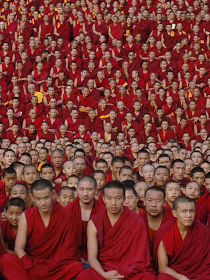- Home
- FPMT Homepage
Foundation for the Preservation of the Mahayana Tradition
The FPMT is an organization devoted to preserving and spreading Mahayana Buddhism worldwide by creating opportunities to listen, reflect, meditate, practice and actualize the unmistaken teachings of the Buddha and based on that experience spreading the Dharma to sentient beings. We provide integrated education through which people’s minds and hearts can be transformed into their highest potential for the benefit of others, inspired by an attitude of universal responsibility and service. We are committed to creating harmonious environments and helping all beings develop their full potential of infinite wisdom and compassion. Our organization is based on the Buddhist tradition of Lama Tsongkhapa of Tibet as taught to us by our founders Lama Thubten Yeshe and Lama Thubten Zopa Rinpoche.
- Willkommen
Die Stiftung zur Erhaltung der Mahayana Tradition (FPMT) ist eine Organisation, die sich weltweit für die Erhaltung und Verbreitung des Mahayana-Buddhismus einsetzt, indem sie Möglichkeiten schafft, den makellosen Lehren des Buddha zuzuhören, über sie zur reflektieren und zu meditieren und auf der Grundlage dieser Erfahrung das Dharma unter den Lebewesen zu verbreiten.
Wir bieten integrierte Schulungswege an, durch denen der Geist und das Herz der Menschen in ihr höchstes Potential verwandelt werden zum Wohl der anderen – inspiriert durch eine Haltung der universellen Verantwortung und dem Wunsch zu dienen. Wir haben uns verpflichtet, harmonische Umgebungen zu schaffen und allen Wesen zu helfen, ihr volles Potenzial unendlicher Weisheit und grenzenlosen Mitgefühls zu verwirklichen.
Unsere Organisation basiert auf der buddhistischen Tradition von Lama Tsongkhapa von Tibet, so wie sie uns von unseren Gründern Lama Thubten Yeshe und Lama Thubten Zopa Rinpoche gelehrt wird.
- Bienvenidos
La Fundación para la preservación de la tradición Mahayana (FPMT) es una organización que se dedica a preservar y difundir el budismo Mahayana en todo el mundo, creando oportunidades para escuchar, reflexionar, meditar, practicar y actualizar las enseñanzas inconfundibles de Buda y en base a esa experiencia difundir el Dharma a los seres.
Proporcionamos una educación integrada a través de la cual las mentes y los corazones de las personas se pueden transformar en su mayor potencial para el beneficio de los demás, inspirados por una actitud de responsabilidad y servicio universales. Estamos comprometidos a crear ambientes armoniosos y ayudar a todos los seres a desarrollar todo su potencial de infinita sabiduría y compasión.
Nuestra organización se basa en la tradición budista de Lama Tsongkhapa del Tíbet como nos lo enseñaron nuestros fundadores Lama Thubten Yeshe y Lama Zopa Rinpoche.
A continuación puede ver una lista de los centros y sus páginas web en su lengua preferida.
- Bienvenue
L’organisation de la FPMT a pour vocation la préservation et la diffusion du bouddhisme du mahayana dans le monde entier. Elle offre l’opportunité d’écouter, de réfléchir, de méditer, de pratiquer et de réaliser les enseignements excellents du Bouddha, pour ensuite transmettre le Dharma à tous les êtres. Nous proposons une formation intégrée grâce à laquelle le cœur et l’esprit de chacun peuvent accomplir leur potentiel le plus élevé pour le bien d’autrui, inspirés par le sens du service et une responsabilité universelle. Nous nous engageons à créer un environnement harmonieux et à aider tous les êtres à épanouir leur potentiel illimité de compassion et de sagesse. Notre organisation s’appuie sur la tradition guéloukpa de Lama Tsongkhapa du Tibet, telle qu’elle a été enseignée par nos fondateurs Lama Thoubtèn Yéshé et Lama Zopa Rinpoché.
Visitez le site de notre Editions Mahayana pour les traductions, conseils et nouvelles du Bureau international en français.
Voici une liste de centres et de leurs sites dans votre langue préférée
- Benvenuto
L’FPMT è un organizzazione il cui scopo è preservare e diffondere il Buddhismo Mahayana nel mondo, creando occasioni di ascolto, riflessione, meditazione e pratica dei perfetti insegnamenti del Buddha, al fine di attualizzare e diffondere il Dharma fra tutti gli esseri senzienti.
Offriamo un’educazione integrata, che può trasformare la mente e i cuori delle persone nel loro massimo potenziale, per il beneficio di tutti gli esseri, ispirati da un’attitudine di responsabilità universale e di servizio.
Il nostro obiettivo è quello di creare contesti armoniosi e aiutare tutti gli esseri a sviluppare in modo completo le proprie potenzialità di infinita saggezza e compassione.
La nostra organizzazione si basa sulla tradizione buddhista di Lama Tsongkhapa del Tibet, così come ci è stata insegnata dai nostri fondatori Lama Thubten Yeshe e Lama Zopa Rinpoche.
Di seguito potete trovare un elenco dei centri e dei loro siti nella lingua da voi prescelta.
- 欢迎 / 歡迎
简体中文
“护持大乘法脉基金会”( 英文简称:FPMT。全名:Foundation for the Preservation of the Mahayana Tradition) 是一个致力于护持和弘扬大乘佛法的国际佛教组织。我们提供听闻,思维,禅修,修行和实证佛陀无误教法的机会,以便让一切众生都能够享受佛法的指引和滋润。
我们全力创造和谐融洽的环境, 为人们提供解行并重的完整佛法教育,以便启发内在的环宇悲心及责任心,并开发内心所蕴藏的巨大潜能 — 无限的智慧与悲心 — 以便利益和服务一切有情。
FPMT的创办人是图腾耶喜喇嘛和喇嘛梭巴仁波切。我们所修习的是由两位上师所教导的,西藏喀巴大师的佛法传承。
繁體中文
護持大乘法脈基金會”( 英文簡稱:FPMT。全名:Found
ation for the Preservation of the Mahayana Tradition ) 是一個致力於護持和弘揚大乘佛法的國際佛教組織。我們提供聽聞, 思維,禪修,修行和實證佛陀無誤教法的機會,以便讓一切眾生都能 夠享受佛法的指引和滋潤。 我們全力創造和諧融洽的環境,
為人們提供解行並重的完整佛法教育,以便啟發內在的環宇悲心及責 任心,並開發內心所蘊藏的巨大潛能 — 無限的智慧與悲心 – – 以便利益和服務一切有情。 FPMT的創辦人是圖騰耶喜喇嘛和喇嘛梭巴仁波切。
我們所修習的是由兩位上師所教導的,西藏喀巴大師的佛法傳承。 察看道场信息:
- FPMT Homepage
- News/Media
-
- Study & Practice
-
-
- About FPMT Education Services
- Latest News
- Programs
- New to Buddhism?
- Buddhist Mind Science: Activating Your Potential
- Heart Advice for Death and Dying
- Discovering Buddhism
- Living in the Path
- Exploring Buddhism
- FPMT Basic Program
- FPMT Masters Program
- FPMT In-Depth Meditation Training
- Maitripa College
- Lotsawa Rinchen Zangpo Translator Program
- Universal Education for Compassion & Wisdom
- Online Learning Center
-
- Prayers & Practice Materials
- Overview of Prayers & Practices
- Full Catalogue of Prayers & Practice Materials
- Explore Popular Topics
- Benefiting Animals
- Chenrezig Resources
- Death & Dying Resources
- Lama Chopa (Guru Puja)
- Lama Zopa Rinpoche: Compendium of Precious Instructions
- Lama Zopa Rinpoche: Life Practice Advice
- Lama Zopa Rinpoche Practice Series
- Lamrim Resources
- Mantras
- Prayer Book Updates
- Purification Practices
- Sutras
- Thought Transformation (Lojong)
- Audio Materials
- Dharma Dates - Tibetan Calendar
- Translation Services
- Publishing Services
- Ways to Offer Support
- Prayers & Practice Materials
-
- Teachings and Advice
- Find Teachings and Advice
- Lama Zopa Rinpoche Advice Page
- Lama Zopa Rinpoche: Compendium of Precious Instructions
- Lama Zopa Rinpoche Video Teachings
- ༧སྐྱབས་རྗེ་བཟོད་པ་རིན་པོ་ཆེ་མཆོག་ནས་སྩལ་བའི་བཀའ་སློབ་བརྙན་འཕྲིན།
- Podcasts
- Lama Yeshe Wisdom Archive
- Buddhism FAQ
- Dharma for Young People
- Resources on Holy Objects
- Teachings and Advice
-
-
*If a menu item has a submenu clicking once will expand the menu clicking twice will open the page.
-
-
- Centers
-
- Teachers
-
- Projects
-
-
-
-
*If a menu item has a submenu clicking once will expand the menu clicking twice will open the page.
-
-
- FPMT
-
-
-
-
-
Superficial observation of the sense world might lead you to believe that people’s problems are different, but if you check more deeply, you will see that fundamentally, they are the same. What makes people’s problems appear unique is their different interpretation of their experiences.
Lama Thubten Yeshe
-
-
-
- Shop
-
-
-
The Foundation Store is FPMT’s online shop and features a vast selection of Buddhist study and practice materials written or recommended by our lineage gurus. These items include homestudy programs, prayers and practices in PDF or eBook format, materials for children, and other resources to support practitioners.
Items displayed in the shop are made available for Dharma practice and educational purposes, and never for the purpose of profiting from their sale. Please read FPMT Foundation Store Policy Regarding Dharma Items for more information.
-
-
Obituaries
27
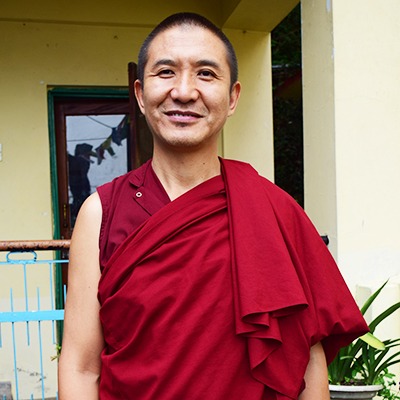
Geshe Tenzin Wangdak at LRZTP, 2015.
Geshe Tenzin Wangdak passed away from cancer on September 8, 2025 in Dharamshala, India.
Lotsawa Rinchen Zangpo Translator Program (LRZTP)’s dear teacher, Geshe Tenzin Wangdak touched the hearts of so many students and all who knew him. Dr. Filip Majkowski, Heidi Minx, and Julia Wilson shared a moving obituary and testament to Geshe-la’s many wonderful qualities:
It is with deep sadness that we share news of the passing of LRZTP’s beloved teacher Geshe Tenzin Wangdak (1972-2025) after a long and courageous battle with cancer. Geshe-la left this life on September 8, 2025 surrounded by friends and students while being cared for in Delek Hospital Dharamshala. His friendly guidance will be sorely missed by all of us at LRZTP and all others who were close to him.
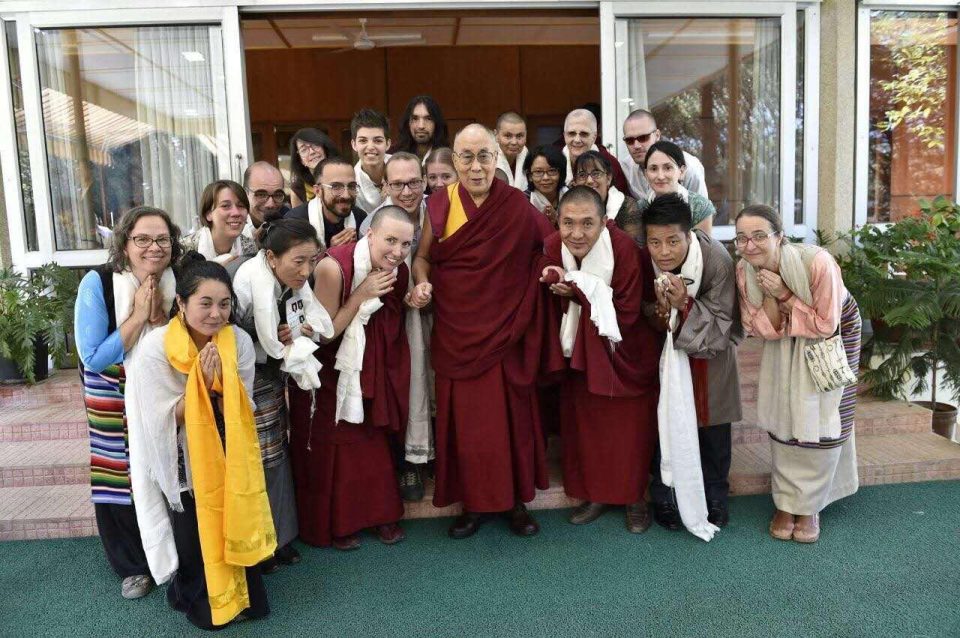
LRZTP 7 cohort audience with His Holiness the Dalai Lama, 2017 (Geshe Tenzin Wangdak is just right of HHDL).
Geshe Wangdak joined LRZTP in 2013 and eventually became one of the main Tibetan language and dharma teachers at LRZTP. Over the years he tirelessly worked creating new materials and updating the content and structure of the LRZTP two-year program of studies. His main concern was creating a friendly and learning-conducive environment for non-Tibetans to quickly learn colloquial Tibetan language and essential Dharma terminology, and in this he made himself ever available to eager students – even his lunch breaks would somehow morph into an impromptu Tibetan language lesson.
In more recent years he was heavily involved with refurbishing the school after the Covid pandemic and managing the two-year intensive program. During the last year and even up to the final month of his life he still remained involved with school through offering regular guidance to the program coordinator and helping appoint other geshe teachers to fill his positions.
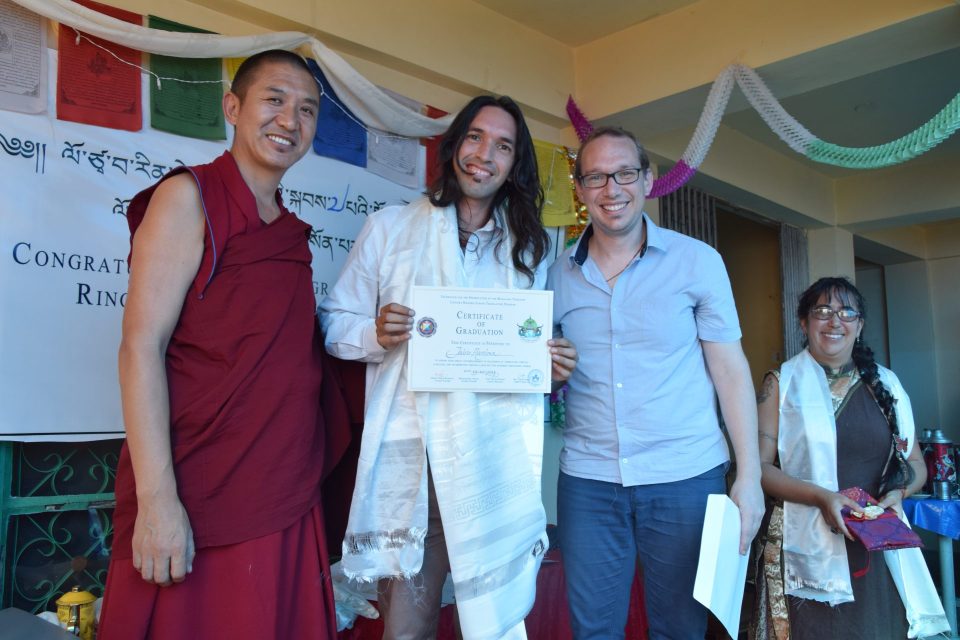
Geshe Wangdak in 2017 with Jairo, Yaron, and Martha during the LRZTP 7 graduation ceremony.
We would also like to share a couple memories of Geshe-la from Dr Filip Majkowski (a colleague from LRZTP) and from Heidi Minx (one of Geshe Wangdak’s early English language teachers and longtime friend).
Memories of Geshe Wangdak from Dr Filip Majkowski
I have known Geshe Tenzin Wangdak since 2017, when I first started working at LRZTP. From day one Geshe-la was very helpful and open minded about everything. He was always ready to reach out and help, he always had ideas and was a problems solver. He did everything with compassion and humor. By then he had already devoted so much of his time to LRZTP and the students. He had passion for his work and a big heart to all students. Much later, during the pandemic, he put the same heart and passion into teaching Tibetan online. He taught until his declining health allowed him to continue. In that he was a true inspiration to teachers and students alike.
The period of his sickness was a very sad time for LRZTP and everyone who knew him. After several months of fighting the disease in 2022 he was healthy again and it seemed he was winning. Then, in early 2024 suddenly things got worse. It was really sad to watch him lose energy and not be able to do what he loved. He could not teach, nor was he able to do house repairs, which was also his passion – in LRZTP he always had his kit with drills, hammers, screwdrivers etc. He loved that. But he still loved meeting people and give advice as much as possible.
I saw him last at the end of June, before I left for Europe. When he passed, I was back in Dharamsala, quite nearby, but unfortunately not able to see him. I regret that. I feel blessed I had this wonderful opportunity to meet Geshe-la in my life. I know we will meet again in some other life. Until then, may the blessings of all Buddhas and Bodhisattvas be with you, Geshe-la. We miss you.
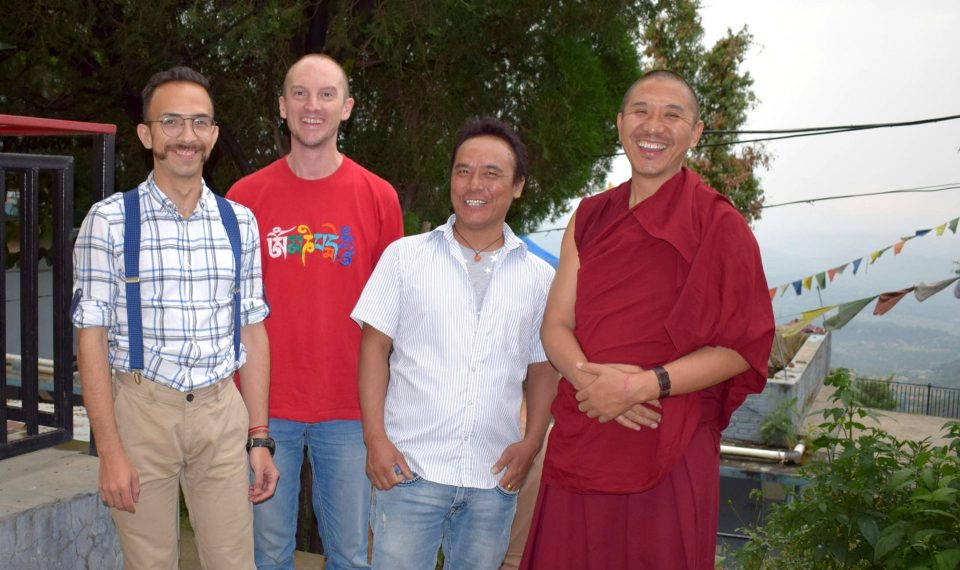
Geshe Wangdak (far right) in 2018 with (from left) Alex, Filip and Thupten of LRZTP.
Memories of Geshe Wangdak from Heidi Minx
In 2009, a program was started by the Dalai Lama Trust for a select group of geshes – a foreign language program so that when His Holiness’s office received requests for Dharma teachers, students from this group could teach in either English or Chinese. Geshe Wangdak was one of two students in the advanced English class. Geshe-la understood the nuances of learning – that it wasn’t just a written exercise based on books, but also discovering and experiencing cultural nuances. The abundance, or lack of direct translations of many words would lead us to interesting debates. The Tibetan word for weasel, neuli, led us to the western scientific naming system for rodents, and then into evolution, back to dinosaurs. Gently debating became a regular theme – and I remember his earnest surprise that there were not “single words” in English for words used commonly in debate — “the book is on the table, so the table supports the book, and the book supports the table – what is the single word for each of these items?” Our classes weaved through traditional vocabulary and writing to the methods of how to teach western students.
One assignment centered on teaching the Four Noble Truths; and as they began to teach, I asked, “What is karma?” Geshe-la’s face lit up, first in confusion that his English teacher didn’t know what karma was, to then a look of disbelief that a concept so deeply understood in his studies and culture might need to be explained more deeply. He grasped that moment – and I believe it is just one example of what made him an excellent teacher, the wisdom to understand that even the smallest concepts needed to be taught and explained with the same importance as deeper concepts. We discussed the differences and similarities between Buddhism as a science, philosophy and religion and how that intersected with western science, philosophy and religion.
Geshe Wangdak was a deeply committed friend as well. His dedication to our friendship was evidenced in so many ways – whether waking up early to stand in line at Yeshe Dhondup’s office when I was sick to make sure I got an early appointment so I could return to class quickly — making sure I had a seat saved with him at His Holiness’s teachings, bringing me to his aunt and uncle’s for huge family meals, seeing me happy after feeding puppies at lunch then coming to love and care for dogs for many years. He loved being a teacher, and in our free time after classes took it upon himself to begin to teach me Tibetan — buying children’s primer books and getting me my first fountain pen that he cut the tip off of for best letter structure. He said, “You will learn letters first, like I did.” Several years later Geshe-la and I worked together on a program to teach the students of a local Thangka school (ITTA) English with the intention that they be able to talk about and share their art with others outside the Tibetan community. Geshe-la was an excellent friend. When my cat died, when I lost my job, when it was my “obstacle year” – Geshe-la would say prayers, and have his khangtsen say prayers. His smile and sense of humor made him an excellent friend and teacher as well. The day his class graduated the teacher translation program at IBD, we had a private audience with His Holiness. At the end of the audience, we all walked out to the steps for the celebratory photo with His Holiness. His Holiness was looking at my tattoos and talking with me as we were walking. As we got to the steps, His Holiness noticed the sengye tattoos on my arm, he clasped my arm and began clapping his hand against it laughing, “yah bobdhuk!” The students all looked up a bit in shock. As we walked slowly to Dharamkot for a pizza party, Geshe-la said, “We thought you were getting scolded – but how do you say? You got beat up by the Dalai Lama, very good blessing!” making us both laugh more as I explained the nuance of the phrase “beat up.”
Geshe-la truly embodied the intent of His Holiness’s program, going on to support Julia with her interpreting at the Tibetan Library, and later with the LRZTP program teaching Tibetan language and Buddhism to western students, planting innumerable seeds of karma that will ripen and unfurl in all corners of the world for generations. In his last week, I witnessed the deep devotion of his students, calling and visiting – imparting to him the deep care that they have for him, as he had for them. His quick and bright smile, his nurturing and genuine care for others, his warm yet direct nature, his powerful yet gentle voice and his deep but unassuming knowledge will be deeply missed by so many who were lucky to have had the karma to know him in this lifetime.
With grateful thanks to Dr. Filip Majkowski, Heidi Minx, and Julia Wilson for this moving tribute.
Please pray that Geshe Wangdak may never ever be reborn in the lower realms, may he be immediately born in a pure land where he can be enlightened or to receive a perfect human body, meet the Mahayana teachings and meet a perfectly qualified guru and by only pleasing the guru’s mind, achieve enlightenment as quickly as possible. More advice from Lama Zopa Rinpoche on death and dying is available, see Death and Dying: Practices and Resources (fpmt.org/death/).
To read more obituaries from the international FPMT mandala, and to find information on submission guidelines, please visit our new Obituaries page (fpmt.org/media/obituaries/).
- Tagged: obituaries, obituary
7

Brian Rae at Dorje Chang Institute, New Zealand, at end of year potluck lunch, December 13, 2020.
Brian Rae passed away suddenly of a heart attack on September 12, 2025 in Taupo, New Zealand.
The following words celebrating Brian’s qualities, interests, and years of service in the FPMT mandala were prepared by Simon Harrison, a FPMT-registered teacher, with input from Brian’s sister Susan, his wife Paula, and Ven. Gyalten Wangmo, the spiritual program coordinator of Dorje Chang Institute.
Brian can be best summed up with 3Hs: hats, hugs, and happiness. He was a big-hearted, big-chested, big-smiling man, for whom nothing was too much trouble. He filled many roles around Dharma centers in New Zealand. He served on the board of Mahamudra Centre and was a trustee of Dorje Chang Institute from 2021 until he passed away on Friday, September 12, 2025, with no warning signs, shortly after completing his morning prayers.
Brian first connected with Dorje Chang Institute (DCI) around 2009, when His Holiness the Dalai Lama visited New Zealand and has been a constant support for both DCI and Mahamudra Centre ever since.
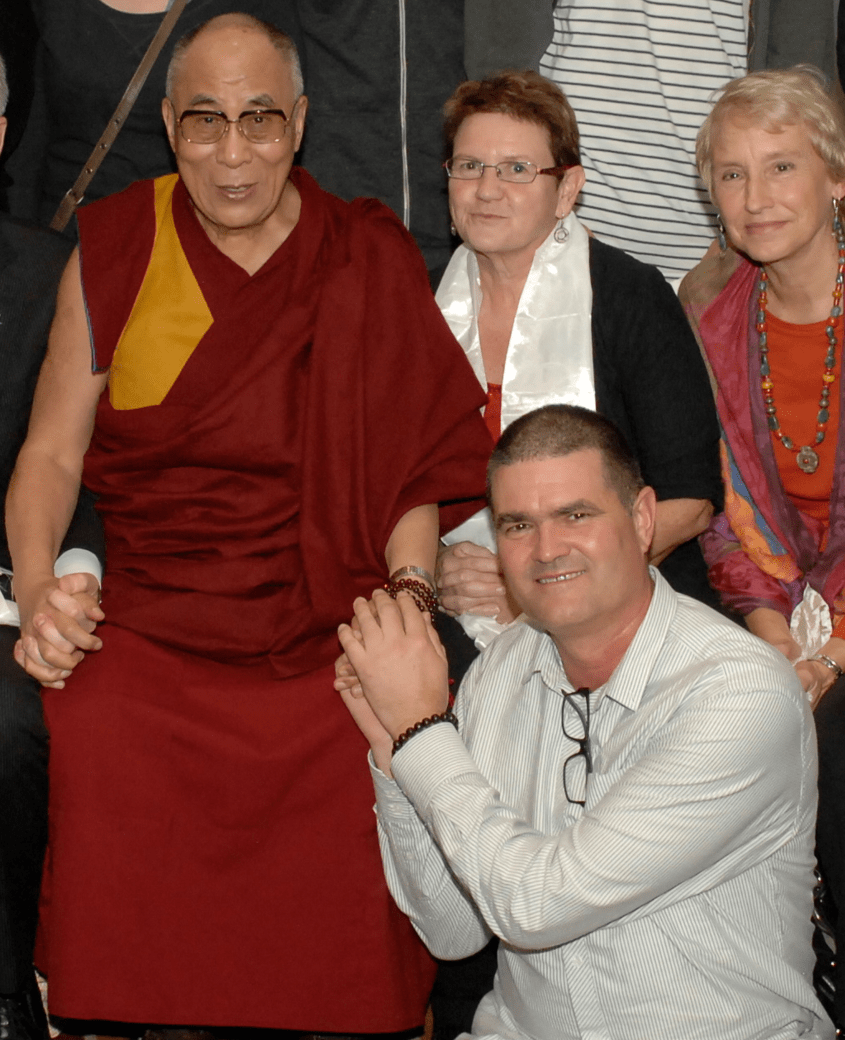
Brian Rae with His Holiness the Dalai Lama, New Zealand, 2013.
He took on the role of national coordinator for FPMT New Zealand in 2014 to coordinate the visit by Kyabje Lama Zopa Rinpoche the following year. He continued in the role until after His Eminence Ling Rinpoche visited in 2020, after which Covid kept us all in our own little bubbles.
Brian loved his family: his wife Paula; three daughters, Ella, Lucy (husband Jake) and Georgia (husband Oliver); and three grandchildren, Luca, Fleur and Leah. There were many times the family would gather with Brian at the heart of it, building Legos with the kids and regaling the rest with extensive stories of the latest “new” thing. He and Paula had just completed building their retirement retreat overlooking Lake Taupo, close to the grandchildren, when he was so suddenly taken from us.
His Dharma journey was infectious. Joined by his sister, Susan, together they would appear for teachings or to offer service at Mahamudra Centre or Dorje Chang Institute. Always humble, his passion for the centers and his devotion to his teacher defined him.
At DCI, he recently oversaw the refurbishment of the stupa. He expressed his love of trees as groundsman supervisor. His memory stays with us in the trees and other greenery around the property, as well as being the star of the training videos for groundskeeping equipment.
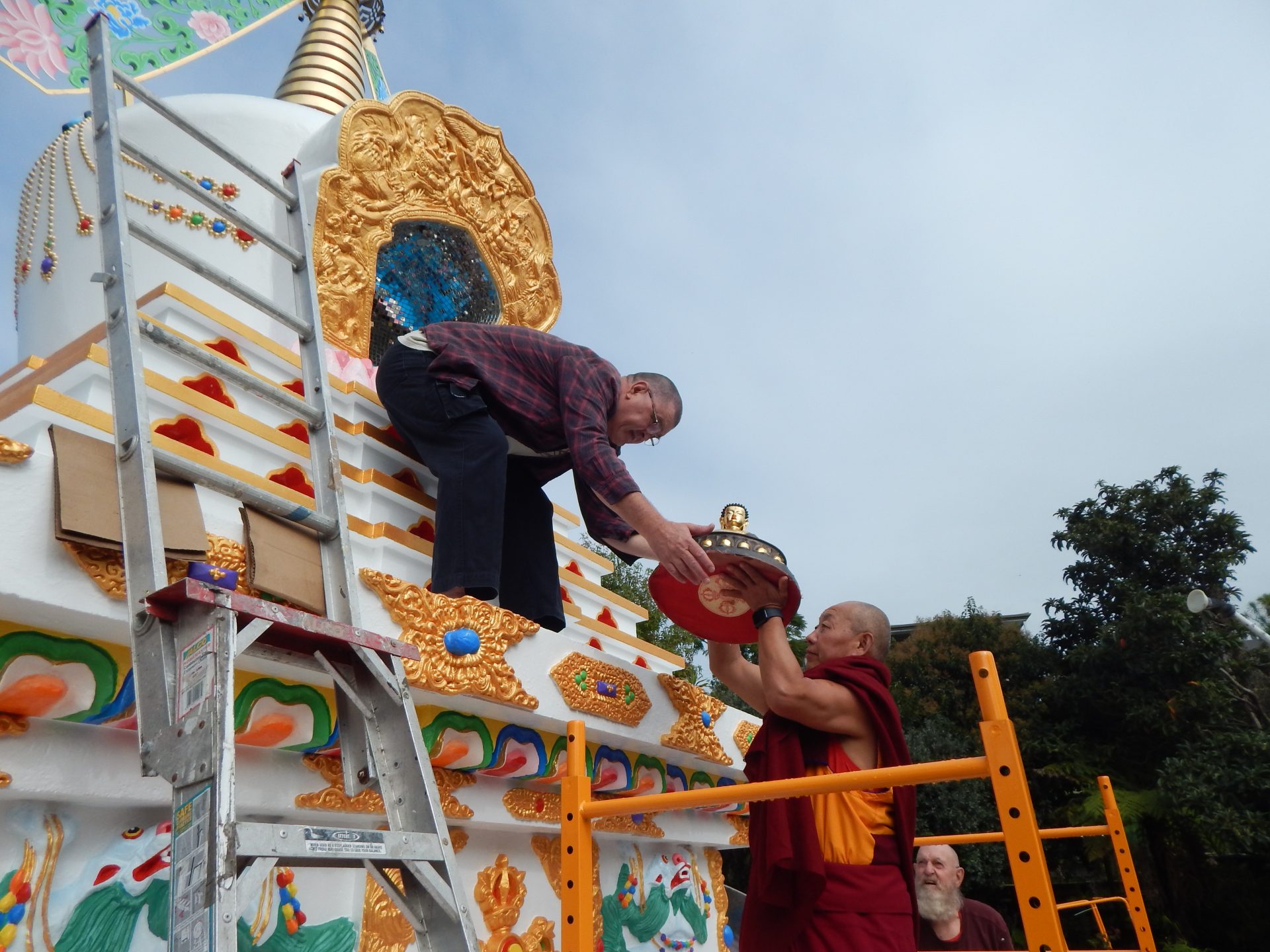
DCI Stupa Refurbishment Project, with Brian Rae assisting Geshe Wangchen, April 6, 2024.
While managing the house build, fulfilling a demanding job with Auckland Airport, sharing his loves for family and trees, and serving on DCI’s board, Brian managed to complete a full round of the FPMT Basic Program with Geshe Thupten Wangchen at DCI.
His final lesson to us all is the fragility and impermanence of this precious rebirth, and the manner of making it happy and useful.
We pray that all of his merit through service, study, practice, and warm-heartedness will serve him well into the future up to his enlightenment.
Please pray that Brian may never ever be reborn in the lower realms, may he be immediately born in a pure land where he can be enlightened or to receive a perfect human body, meet the Mahayana teachings and meet a perfectly qualified guru and by only pleasing the guru’s mind, achieve enlightenment as quickly as possible. More advice from Lama Zopa Rinpoche on death and dying is available, see Death and Dying: Practices and Resources (fpmt.org/death/).
To read more obituaries from the international FPMT mandala, and to find information on submission guidelines, please visit our new Obituaries page (fpmt.org/media/obituaries/).
- Tagged: obituaries, obituary
13
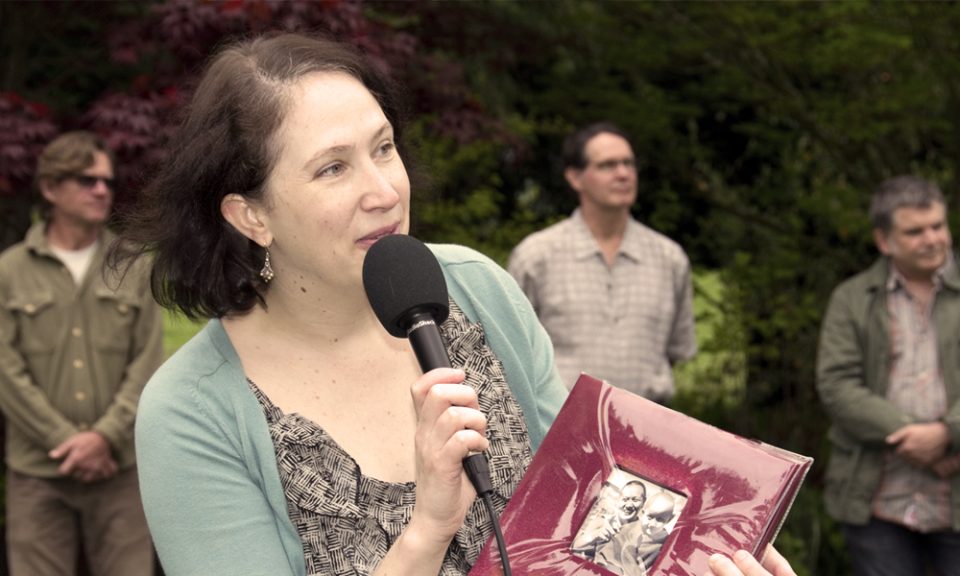
Sara Ritter during the 2012 Maitripa Spring Celebration. Photo courtesy of Maitripa College.
Sara Ritter passed away at the age of 51 on February 6, 2025, from complications from pneumonia.
By Carina Rumrill
As the person who puts together obituaries for fpmt.org and our community news blog, there are inevitably times when I have to organize life remembrances for those I also consider very dear heart friends. Sara Ritter was undoubtedly such a friend.
In 2008, when Sara was publisher of Mandala magazine and one of the editors, she hired me as the new managing editor. The moment I first heard her voice during a phone interview for the position, I thought: “Oh, it’s you!” I had never met her in this life, but I knew immediately that our connection was deep. We did the interview for maybe fifteen minutes before launching into any and every personal detail about ourselves. It was like catching up with an old friend. We both had small boys close to the exact same age; their last names were oddly similar (Bloom and Blumenthal); and we shared so many similar interests, points of view, aspirations, and concerns about the world. And most importantly—we shared a very unconventional sense of humor! As I would learn, many people had this experience with Sara. She knew how to really connect with others.
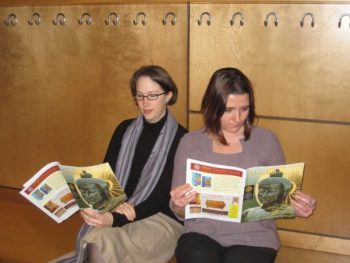
Sara Ritter and Carina Rumrill, 2009. Photo courtesy of Mandala magazine.
On my first day at the job, she scurried into my office with the excitement of a pre-teen girl having her first sleepover with a friend. She wasted no time making sure I was entirely at home and comfortable. She took me and then associate editor, Michael Jolliffe, out to lunch and she was just bursting with ideas and energy about the future of the magazine and a potential membership program to help fund it (which eventually turned into the Friends of FPMT program). Sara was always so full of ideas. She was a big, brave thinker. I marveled at how she conducted herself in staff and management meetings, always so open, fair, courteous, and diplomatic.
I found Sara to be laser-sharp, hilarious, kind, open, deeply emotional, humble, and full of surprises. She was always so present during our interactions: she made me feel like I was the only person alive on the planet when we spent time together. When she was no longer working for FPMT International Office, she was always just a quick trip downstairs at Maitripa College. I continued to run things by her as I found my way managing and publishing the magazine. Her feedback and engagement was always so valuable and thoughtful.
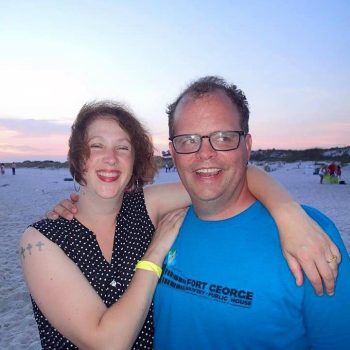
Sara and Tripp Ritter. Photo thanks to Tripp Ritter.
During this time, I was not only working for Mandala and International Office, but I was also a small business owner. Sara supported the upstart of my food truck every single step of the way. She brought her family to eat there regularly and was never shy with constructive feedback or gratuitous praise. She never missed a single community event we organized to support the business and community. She participated in our marketing video when we expanded. She even brought her wedding party and out-of-town family to the truck as part of her post-wedding festivities! She used every opportunity to support others; this was such a central quality of hers.
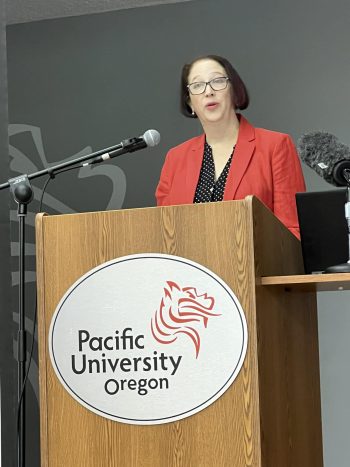
Sara Ritter presenting her final MFA work, 2024. Photo courtesy of Tripp Ritter.
She and her husband, Tripp, and their four kids eventually moved from Portland to Seattle several years ago, and shortly after, I moved with my family to Vermont. We kept in touch through social media, with occasional longer messages updating each other about our busy and complicated lives. Sara had recently completed her Master of Fine Arts in Poetry at Pacific University. Sara was, in her heart, always first, a poet. I am so very pleased that she actualized this core aspect of her identity before she passed.
Her husband, Tripp, opened his obituary for her in the following way:
“The poet Sara Kristen Ritter passed away at the age of 51 ….” The poet Sara. That she was.
Tripp also shared:
“One of her greatest professional and spiritual accomplishments was playing a key role in organizing the three-day environmental summit with His Holiness the Dalai Lama in conversation with spiritual, environmental, and political leaders in the Pacific Northwest hosted by Maitripa College in Portland, Oregon. When she cared about something she gave it her all and ensuring His Holiness had a fulfilling and impactful visit was incredibly important to her. Fortunately, the event was a resounding success.

Sara Ritter greeting His Holiness the Dalai Lama during the environmental summit hosted by Maitripa College, 2013. Photo courtesy of Maitripa College.
“In her professional work and in her personal life, what stands out about Sara is the care she gave to others. So many shared that when she was talking to them, it was like no one else existed. She loved life and love and wanted others to find their own joy. Among her favorite things were being a mom and step-mom, a wife, playing games, listening to music, working together on a crossword, watching a cooking show, and visiting the Oregon and Washington coasts.”
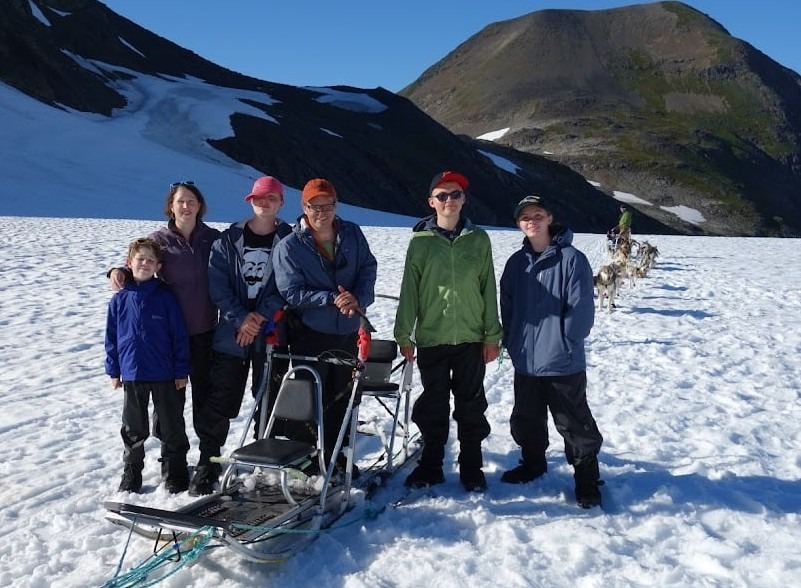
Sara and Tripp Ritter with their children. Photo courtesy of Tripp Ritter.
On February 7, a guru puja was organized for Sara at Maitripa College. Over forty participants joined online and in person. During the puja, Yangsi Rinpoche, President of Maitripa College, said this about Sara:
“Most of us here have a connection with Sara. Particularly myself—at the beginning, when I first came to Portland, Sara was my host. And then she was involved in the establishment of Maitripa very intensely. She played a very important role in student services. She was a really wonderful person and a sincere practitioner, and she served all of us. Sara is very close to our hearts, very dear to our hearts. Today we make prayers and dedicate for her journey, for her future, and for her to have perfect conditions to meet her spiritual path, the path that leads to benefiting sentient beings. And then also for Ben [her son], who we have known his entire life, who is also a part of our family. And for all of her community and relatives and friends who are going through difficulty now, that this difficulty can be part of a spiritual transformation.”
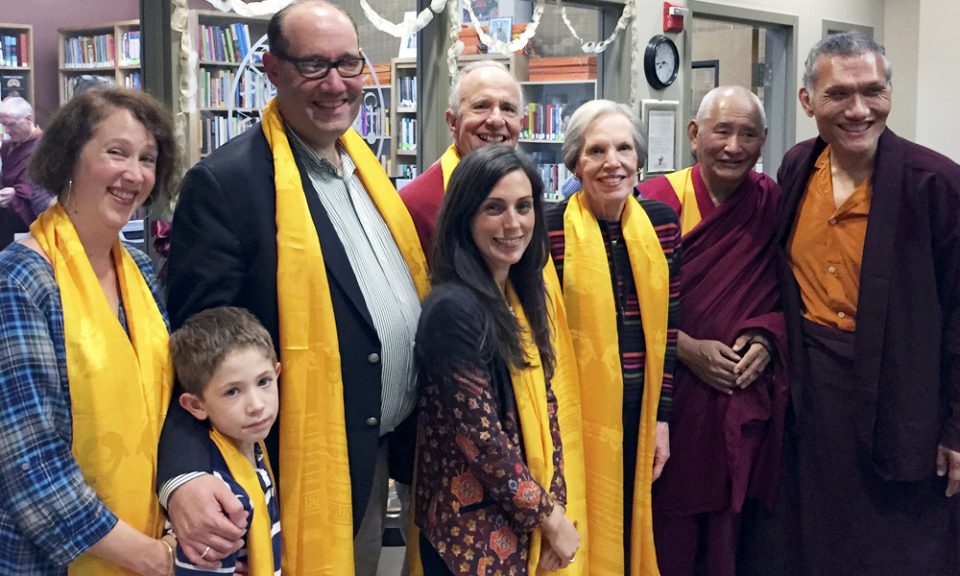
Sara, her son Ben Blumenthal, Tom Blumenthal, Tiffany Blumenthal Patrella, Jack Blumenthal, Susan Blumenthal, Geshe Tenzin Dorjé, Yangsi Rinpoche – at the dedication and opening of the James A. Blumenthal Library at Maitripa College, October, 2015. Photo courtesy of Maitripa College.
Namdrol Miranda Adams, Dean of Education at Maitripa College, and Leigh Miller, faculty member and Director of the Master of Divinity Degree and Chaplaincy Program recalled this about Sara:
“Since the announcement to the Maitripa College community that Sara had passed, many messages have flooded in with a common, cherished remembrance—that of Sara’s unfaltering kindness towards everyone. Many also recall her heart for service, be it towards students, or teaching meditation to prison inmates, or hosting opportunities for rejoicing in the community and life celebrations of others. As a mother, she glowed with love and pride for her son, and kept his drawings and photos by her desk. She was fun-loving, with an uninhibited laugh, putting others at ease and bringing smiles to all.
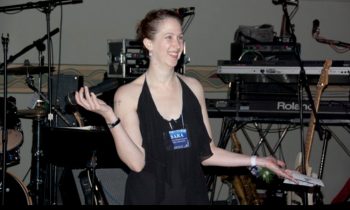
Sara during the 2008 winter “prom” at Maitripa College. Photo courtesy of Maitripa College.
“Those of us who worked closely with Sara in the Maitripa College office saw many additional good qualities. While she started here as a student, she soon selflessly put her own coursework aside to facilitate the educational experience of other students, becoming the Director of Student Services. In this role, she was a warm, welcoming presence to all, helping them obtain housing, visas, scholarships, referrals to Buddhist-friendly therapists, and more. She invented and, for several years, brought to fruition the Portland City Sit, a day of meditation for all in Portland’s Pioneer Courthouse Square. And when Maitripa College faced an existentially threatening gap in leadership in 2012, Sara bravely and tirelessly stepped up to tremendous responsibility and management of people, communications, and strategic planning, without complaint or expectation of reward. Following that crisis, she again worked incredibly hard—with tremendous vision, love, and generosity—on the planning committee for the 2013 visit of His Holiness the Dalai Lama to Portland and Maitripa College. She was appointed the staff lead in planning the interfaith event, with spiritual leaders representing Indigenous, Jewish, and Christian communities, as well as incorporating a youth choir, Native drummers, and a flower offering by children to His Holiness. Throughout those endlessly long work days over many months, she kept foremost the benefit to thousands of people, and to Maitripa College, of receiving His Holiness, and even when our bodies were tired, her mind was uplifted and encouraging.
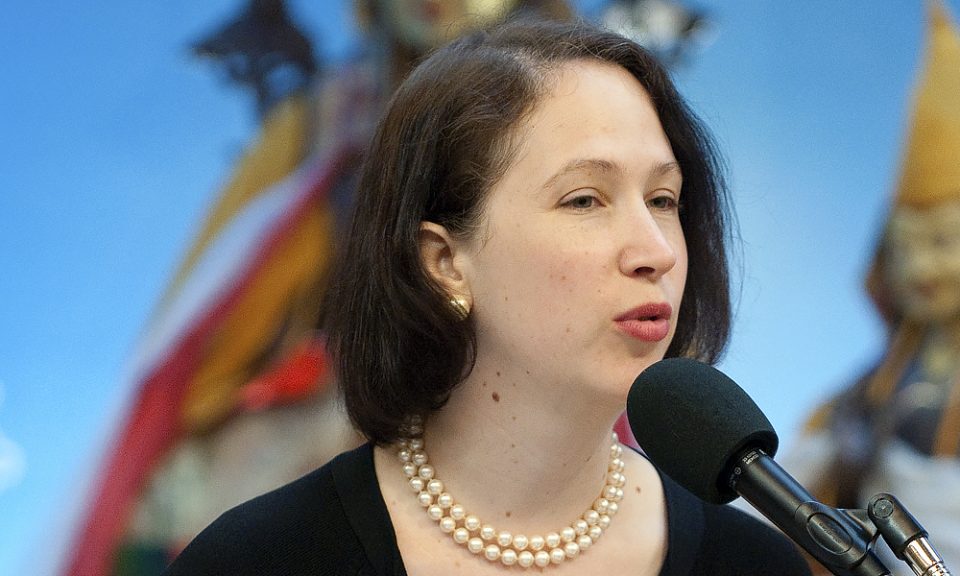
Sara speaking during the 2011 Maitripa College graduation. Photo courtesy of Maitripa College.
“She modeled how to be a bright, caring, professional woman. She skillfully aligned her work responsibilities with our commonly held organizational values and spiritual motivations, achieving not only proficiency and accountability, but also fostering loving care for all in the community. When she departed from employment at Maitripa College, we were saddened but also rejoiced in her new opportunities, marriage, and thereafter, relocation to Seattle. Sara remained a friend, visiting on important College occasions, and staying in touch. She is so lovingly remembered. We are grateful for all the blessings she brought us in touching our lives.”
Louise Light, Maitripa College Graphic Designer and Webmaster, reflected:
“Sara loved a good party—not only working to envision themes and help make the annual celebrations happen, but enjoying them fully. As I recall, the Maitripa College ‘City Sit,’ which brought meditation instruction to downtown Portland, was also a project dear to her heart.
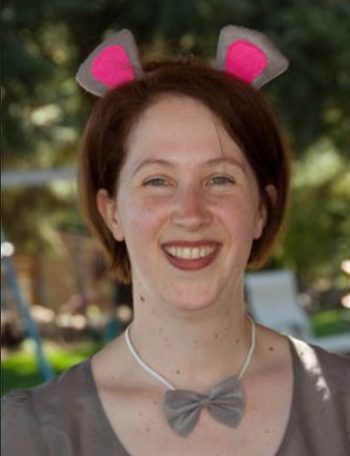
Sara during Maitripa College’s Mad Hatter’s Tea Party Spring Extravaganza, 2009. Photo courtesy of Maitripa College.
“On a personal note, Sara’s presence during my daughter Namdrol’s health crisis over many months in 2011 and 2012, was priceless. Yangsi Rinpoche talks about how she was critical support in the office in Namdrol’s absence, but to me, she also was a personal support. She arranged for community members to pick me up at the airport when I arrived from the East Coast, care for me, and drive me to the hospital, and then, as if by magic, for days, someone would arrive at the hospital to drive me to the house for showers and a change of clothes. Sara also communicated to my larger family and Namdrol’s vast network of global friends by filtering updates Namdrol’s treatment and prognosis through one e-list that she coordinated with me and Rinpoche. I’ll never forget Sara’s kindness that year.”
Former associate editor of Mandala, and alum of Maitripa College, Michael Jolliffe observed:
“When I think about Sara, I remember someone possessing a special blend of curiosity, playfulness, devotion, warmth, gentleness, and groundedness. I appreciated her professionalism and positive attitude while serving in her various roles at the FPMT International Office and Maitripa College. I don’t remember her ever complaining about anyone; in my memory, she was consummately diplomatic at all times.
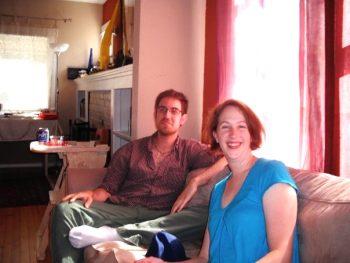
Sara with Michael Jolliffe, 2009. Photo by Molly Stepanski.
“Sara included me in her life as much as she could, and I deeply appreciated the parties she threw in her Portland homes, invitations to game groups at the Lucky Lab pub, and lively conversation at the Horse Brass with her then-new boyfriend Tripp.
“She changed the trajectory of my professional and spiritual life by actively encouraging me to volunteer for Mandala, which eventually transformed into a happy career with FPMT International Office. I have Sara–and her characteristic thoughtfulness and generosity–to thank for the many wonderful experiences I had while working at International Office. She was a truly special person in my life; I’ll really miss her.”
She is survived by husband Tripp Ritter; child Benjamin Blumenthal; step-children Simon Ritter, Bruce Ritter, and Graham Ritter; sister Amy Winkelman; and mother Sheri Winkelman. She is preceded in death by her father, James Winkelman, and Ben’s father, her ex-husband, James Blumenthal.
Compiled by Carina Rumrill with input and care provided by Tripp Ritter, Namdrol Miranda Adams, Leigh Miller, Louise Light, and Michael Jolliffe.
Please pray that Sara may never ever be reborn in the lower realms, may she be immediately born in a pure land where she can be enlightened or receive a perfect human body, meet the Mahayana teachings and meet a perfectly qualified guru and by only pleasing the guru’s mind, achieve enlightenment as quickly as possible.
More advice from Lama Zopa Rinpoche on death and dying is available, see Death and Dying: Practices and Resources (fpmt.org/death/).
To read more obituaries from the international FPMT mandala, and to find information on submission guidelines, please visit our new Obituaries page (fpmt.org/media/obituaries/).
- Tagged: obituaries, obituary
6
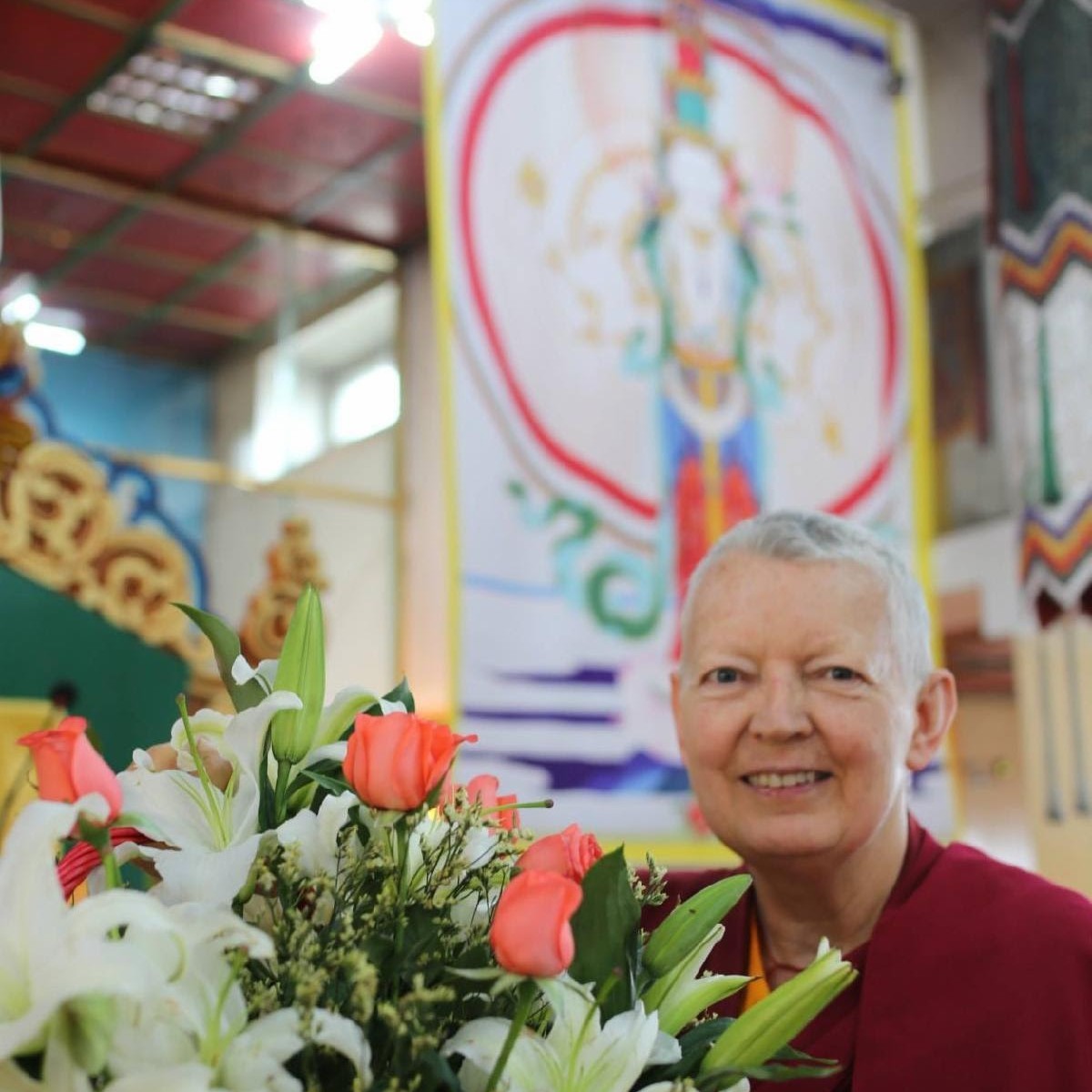
Ven. Ingrid Thubten Nordzin. Photo courtesy Ocean of Compassion Facebook page.
Ven. Ingrid (Thubten Nordzin) passed away after a short period of illness on February 17, 2025 at Tara Home, Soquel, California.
Venerable Ingrid was a beloved and devoted practitioner within the FPMT community for many decades. She received her novice monastic vows in 1988 with Lama Zopa Rinpoche and received full ordination in 1994.
Below longtime friends share some memories, thanks, and wishes for Ven. Ingrid, and tell of the activities being held for her beneficial transition during the 49-day period after her death. We also warmly share below a slideshow by Vajrapani Institute, and an article by Ven. Ingrid, “My First Retreat”, published in the April 1989 issue of Mandala Magazine, with her vivid account of her first meditation retreat in Lawudo, Nepal.
Reflections, Rejoicing and Practices Being Offered
Dear friend to Ven. Ingrid, Thubten Wongmo shares:
“Our dear vajra sister, Ingrid, left this body on February 17 at 4 p.m. I first met her at Kopan before she was a nun, around 1985 and right away we became friends. Since we both have been living in the US, we’ve met at many of Lama Zopa Rinpoche’s courses, both here and in Mexico.
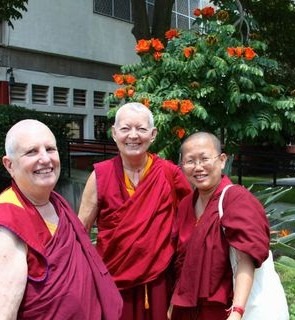
Ven. Wongmo, Ven. Ingrid, and Ven. Tsomo in Mexico, 2014.
“Ingrid was known as the flower lady as she had a talent for creating the most beautiful flower arrangements to place in front of Rinpoche’s throne and on tables next to him. She was very devoted to Rinpoche and would manage to attend as many of his teaching events as possible.
“She had a great sense of humor, and whenever we ended up sitting next to each other, there were lots of laughs. Another talent that most impressed me was her ability to hold pure view. Her closest Dharma friend suddenly stopped all communication with her, thinking that poor Ingrid was the cause of all her problems. This went on for years and even though Ingrid had lost her best friend, she never once criticized her old friend, but insisted that she was Tara incarnate and only acting in such a way as a teaching. Wow wow.
“May our beloved Ingrid be immediately born in a pure land, or be born in a loving Buddhist family, meet the holy Dharma at a young age, find qualified Mahayana gurus, study and practice the path, gain realizations and then benefit many living beings.”
Dear friend, Julie Caldwell remembers:
“In addition to being a nun, Venerable Ingrid was also a teacher. I know this as she was my teacher (along with Lama Zopa Rinpoche) for 22 years. She once told me she had five students. We met in 2001 at The Great Medicine Buddha Retreat and traveled together every year attending Rinpoche’s one month retreat somewhere around the globe. Venerable Nordzin spoke five languages fluently (German, English, French, Spanish, and Greek). In addition to attending Rinpoche’s teachings we would also go to Deer Park in Wisconsin to study with Geshe Lundrub, Sopa.
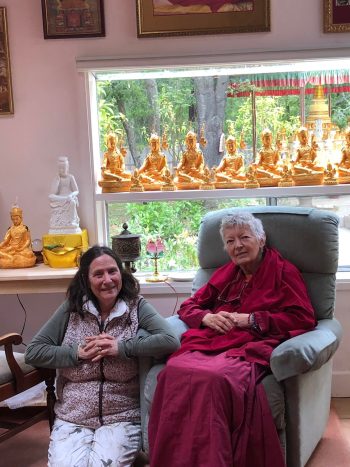
Ven. Ingrid and Julie Caldwell at Lama Zopa Rinpoche’s house, March 2013. Photo courtesy of Julie Caldwell.
“In addition to flower arrangements, Venerable Ingrid was a great artist. She assisted our study group in Elko, Nevada, in designing and building a Universal Prayer Wheel. It won the National Endowment Award for best Park Landscape design. This adventure resulted in her coming to Elko, Nevada many times over seven years, including helping me transform our home into a pure land so Lama Zopa Rinpoche could visit in 2007, and perform the land blessing. This ritual was also attended by members of the Western Band of Shoshone Native Americans. Ven. Ingrid became close with the tribe’s leaders. She also was the artist who drew the hand mudras published in the Vajrayogini Self-Initiation practice.
“Lama Zopa’s Rinpoche also acknowledged her as my teacher on multiple occasions. Perhaps the most profound was during COVID when I did not travel. So I wrote a question for Rinpoche on paper, “Any advice for my husband’s cancer?” And tuned in at 1 a.m. my time to a Zoom teaching he was giving to the students in Singapore. He looked up and said, “The person with the question about her friend with cancer….you know the nun… follow her advice.” Venerable Ingrid was that nun and was known to heal many people with cancer. My husband followed all of her advice and he also is now cured.”
Ven. Angie Muir, on the practices for Ven. Ingrid’s transition: Ven. Ingrid was at Tara Home for her last three days until she passed, which again would have been very comforting for her since this was her wish to pass away there. Many friends as well as the hospice volunteers offered prayers for her there, as well as Ven. Jangchub, who was doing prayers at her bedside as she passed. Fortunately, Yangsi Rinpoche had been nearby teaching at Vajrapani Institute and came to offer prayers for her the day before she passed. She opened her eyes during the prayers and looked at Rinpoche directly for a moment, very aware he was there. It was surely very moving for her.
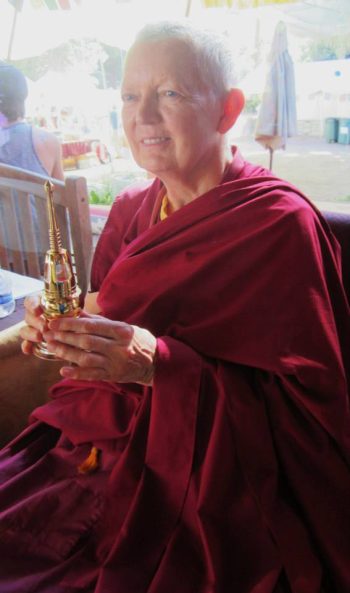
Ven. Ingrid, photo courtesy of Thubten Wongmo.
We held a memorial puja for her on Saturday, March 1, at Land of Medicine Buddha. It was attended by around 50 people, in person and online. We chanted the Medicine Buddha Puja and recited the King of Prayers. This was followed by some heartwarming storytelling of her life and qualities by some of her close friends and Dharma family. At the conclusion, we all enjoyed chai and some of the cakes we offered during the puja, two of her favorites, princess cake and blueberry cheesecake. Land of Medicine Buddha also arranged a beautiful assortment of bouquets which she would’ve enjoyed, being a lover of flowers, especially since there were some of the delightful, sweet-scented spring varieties.
There will be a weekly puja for her up until the 49 day period ends, which will be led by various sangha members in the Bay Area of California. The details for the times and days of the pujas are on the Land of Medicine Buddha website.
We were very fortunate to be able to check with Geshe Ngawang Dakpa, long-term resident teacher of Tse Chen Ling, who advised the time and which direction to move the body. He also advised to make a Shakyamuni Buddha statue on her behalf, which has been completed and will be offered on her behalf to His Holiness the Dalai Lama. Together with Medicine Buddha Practice and the King of Prayers, Geshe Dakpa also asks us to recite the Vajra Cutter Sutra as much as possible during the 49 days.
From the International Mahayana Institute Sangha: From the bottom of our hearts we thank Venerable for all the Dharma and good works for others she has done. For all the beautiful offerings she created, the flowers and holy objects. For her devotion to Lama Zopa RInpoche and all her lamas, for being their hands. We rejoice in her wonderful merit and beneficial life.
Vajrapani Institute prepared a slideshow of Ven. Ingrid’s life for her memorial service
Please read “My First Retreat” by Ven. Ingrid Nordzin, published in Mandala magazine, April 1989.
Please pray that Ven. Ingrid may never ever be reborn in the lower realms, may she be immediately born in a pure land where she can be enlightened or to receive a perfect human body, meet the Mahayana teachings and meet a perfectly qualified guru and by only pleasing the guru’s mind, achieve enlightenment as quickly as possible. More advice from Lama Zopa Rinpoche on death and dying is available, see Death and Dying: Practices and Resources (fpmt.org/death/).
To read more obituaries from the international FPMT mandala, and to find information on submission guidelines, please visit our new Obituaries page (fpmt.org/media/obituaries/).
- Tagged: obituaries, obituary
19

Margot and Jan Paul Kool at Maitreya Instituut, the Netherlands. Photo courtesy of Jan Paul Kool collection.
Jan Paul Kool passed away from cancer on November 29, 2024 in Apeldoorn, the Netherlands, aged 78.
Obituary by Paula de Wys with thanks to Ven. Yangdzom (Koosje vd Kolk)
On December 9, 2024, a memorial service was held at Maitreya Instituut in Loenen, the Netherlands, for Jan Paul Kool, one of the founders and driving forces of Maitreya Instituut. Jan Paul passed away some days before after a long period of illness. During the service, which he had planned himself, several of us recollected his amazing accomplishments and dedication through the years and the men’s choir in which he sang for years brought him a beautiful and moving vocal tribute.
Jan Paul met the Dharma in 1976 at the second lamrim course taught by Marcel Bertels in the Netherlands. A few months after the course, Jan Paul met Margot and it clicked right away between them. Soon after he brought her to one of the lamrim afternoons we organized in the winter to show her off to us and also introduce her to the Dharma—and that clicked too.
The following summer they went to Manjushri Institute in England, where Lama Thubten Yeshe, always our great inspiration, married and blessed them. Their honeymoon took them for months to Nepal and India where they lived in a cave in Rewalsar (Tso Pema) and had lots of adventures. They came back totally inspired.
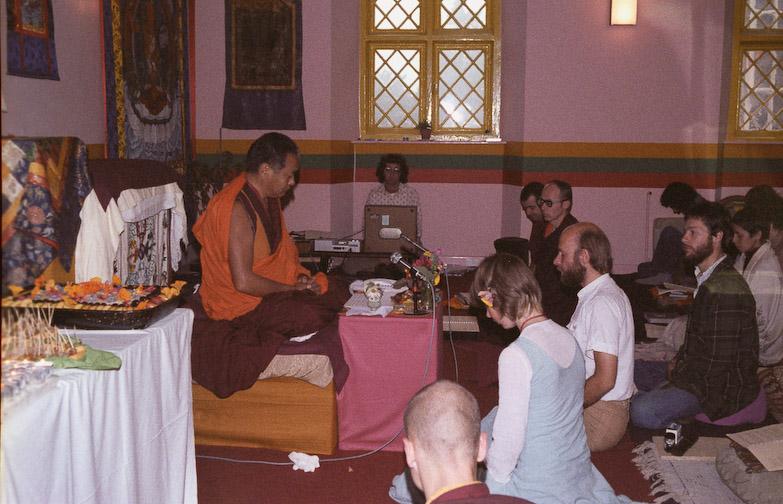
Lama Yeshe marrying Jan Paul and Margot at Manjushri Instituut, photo thanks to Jan Paul Kool collection.
Soon after they returned to the Netherlands, they sailed past my houseboat with a friend and I shouted, “Lama Yeshe and Lama Zopa are coming! Will you help?” They were overjoyed. The Lamas’ visit became the beginning of Maitreya Instituut and also Maitreya Magazine, because Lama Yeshe gave us (including Truus Phiipsen) the advice to organize a monthly program and also to publish something in Dutch, so that the Dharma could become accessible to people here in their own language.
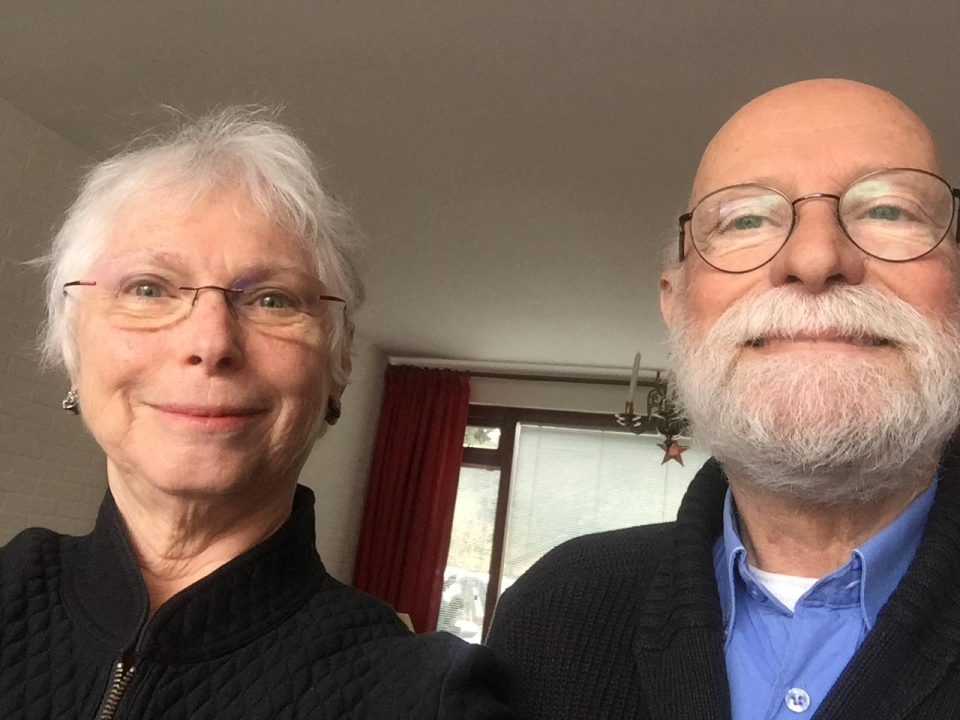
Jan Paul and Paula in 2019 at the fortieth anniversary of Maitreya Instituut.
Jan Paul edited Maitreya Magazine for decades and it also became the beginning of the Maitreya Uitgeverij (publishing house). Over the years both Jan Paul and Margot worked with great enthusiasm and skill on translating and editing many books and commentaries of the Lamas, His Holiness the Dalai Lama, resident and visiting teachers, and several other great masters.
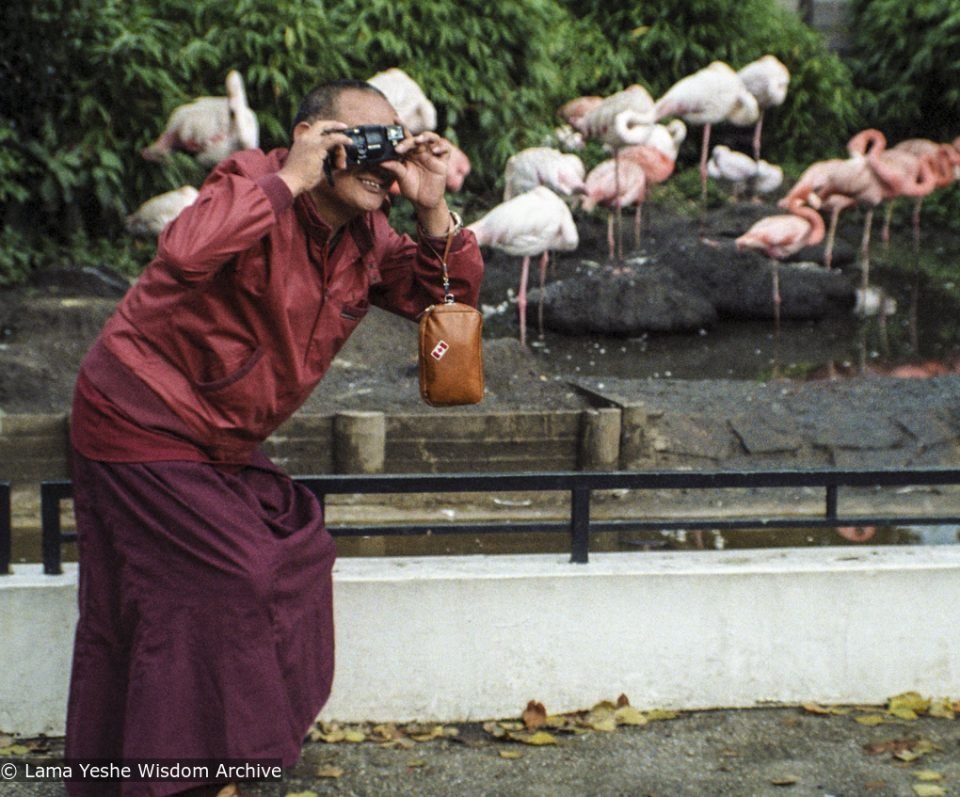
Lama Yeshe taking photos of people taking photos at the zoo in Amsterdam, 1980. Photo by Jan-Paul Kool; courtesy of Lama Yeshe Wisdom Archive.
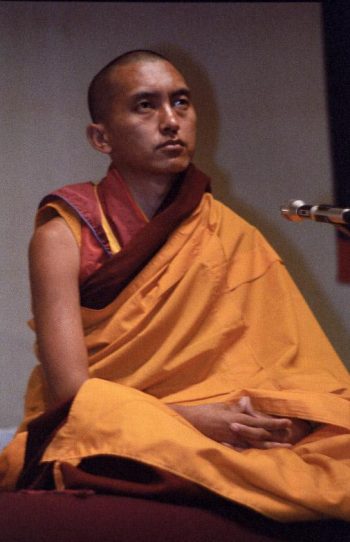
Portrait of Lama Zopa Rinpoche by Jan Paul Kool, 1979.
Meanwhile, Jan Paul had, as a first, invited an amchi (a traditional Tibetan healer) to this country. Ama Lobsang Dolma was a well-known female amchi and came to Europe for the first time to lecture and treat people. The success of that visit was so great that Jan Paul and a few others founded the NSTG (Dutch Foundation for Tibetan Medicine), which then grew into a clinic in Amsterdam and helped over a thousand people in the years that followed.
To talk about Jan Paul and say nothing about his photography would not do him justice. He loved photography and did it very well. The photo collection of his travels, visits of high lamas to Maitreya Instituut and abroad is impressive. Fortunately, several years ago he donated this extensive collection to LYWA where it can remain well preserved and yet useful.
The passing away of his beloved wife Margot in 2012 was a great blow and he missed her until the end. When asked whether he was afraid of dying, he said matter-of-factly, “Not at all, I have the Dharma.” He died very peacefully surrounded by photos of His Holiness the Dalai Lama, Lama Yeshe, and Lama Zopa Rinpoche and a mandala given to him by his great friend Andy Weber. The Weber family, Ven. Yangdzom, and some close friends who loved and cared for him in the last months were his Dharma family, and very important to him.
Jan Paul was quite an outspoken character who enjoyed being a pioneer and accomplishing things in his own way. In remembering him it is his truly exceptional energy and devotion to our Lamas that stands out and there is no doubt that he is someone who will be remembered by Maitreya Instituut with great appreciation and gratitude.
Please enjoy a photo gallery of Jan Paul and some of his incredible photography, thanks to the Lama Yeshe Wisdom Archive.
Please pray that Jan Paul may never ever be reborn in the lower realms, may he be immediately born in a pure land where he can be enlightened or to receive a perfect human body, meet the Mahayana teachings and meet a perfectly qualified guru and by only pleasing the guru’s mind, achieve enlightenment as quickly as possible. More advice from Lama Zopa Rinpoche on death and dying is available, see Death and Dying: Practices and Resources (fpmt.org/death/).
To read more obituaries from the international FPMT mandala, and to find information on submission guidelines, please visit our new Obituaries page (fpmt.org/media/obituaries/).
- Tagged: obituaries, obituary
10
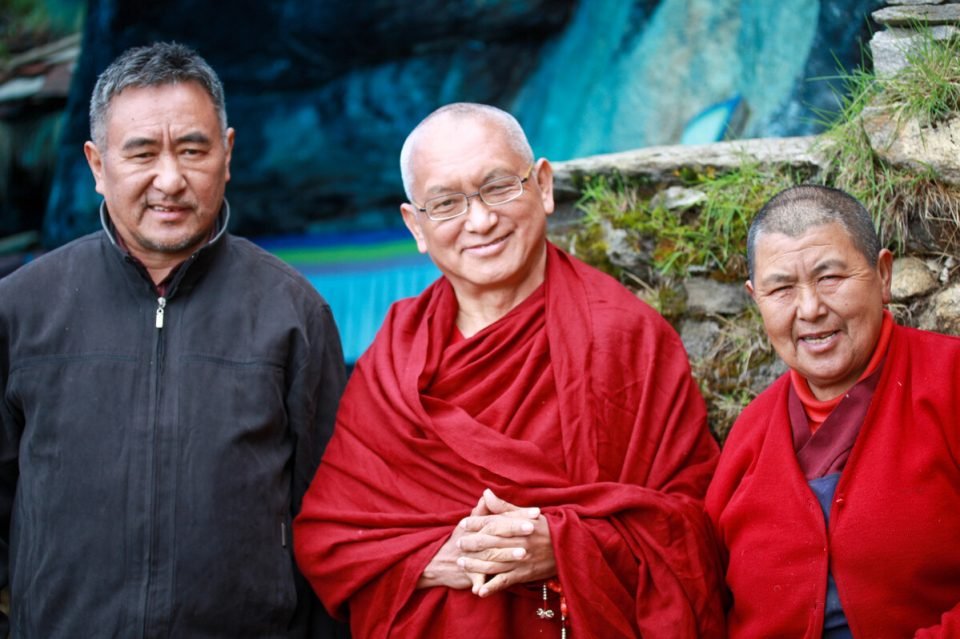
Lama Zopa Rinpoche with brother Sangay Sherpa (left), and sister Ani Samten (right), Lawudo, Nepal, June 2008. Photo by Ven. Thubten Kunsang.
Sangay Sherpa, the brother of Lama Zopa Rinpoche, passed away on December 8, 2024 after an admittance to HAMS hospital in Kathmandu for various health issues. Sangay offered a lifetime of service to Lama Zopa Rinpoche, His Holiness the Dalai Lama, and the Lawudo Retreat Center. The cremation will take place on December 11 at Ramadoli Teku in Kathmandu.
In 2022, Frances Howland wrote a moving biography of Sangay, and we invite you to read it now. Please rejoice in Sangay’s beneficial life, recall his kindness, and to also pray for him to never be reborn in the lower realms, to be born in a pure land where he can be enlightened, or to receive a perfect human body, meet the Mahayana teachings, and meet a perfectly qualified guru, and by only pleasing the guru’s mind, to achieve enlightenment as quickly as possible. It is also requested that those who are able to please recite at least one mala of OM MANI PADME HUM and/or The King of Prayers for Sangay at this very important time.

Lama Zopa Rinpoche and his brother Sangay Sherpa and Sangye’s wife, Nyima. March 2021, Kathmanu, Nepal. Photo by Ven. Roger Kunsang.
Rejoicing in the Achievements of Sangay Sherpa
By Frances Howland, written in 2022
Sangay is the younger brother of Kyabje Lama Zopa Rinpoche and his sister Ven. Ngawang Samten. He was born in 1948 in the village of Thame in Solu Khumbu, one month after their father died. They were a poor Sherpa family, and the early years were filled with many hardships due to their father’s untimely death.
In 2008 Lama Zopa Rinpoche requested Sangay to become the director of Lawudo Retreat Centre and for the next 13 years he worked hard raising money and maintaining and developing Lawudo Retreat Centre in accordance with the wishes of Lama Zopa Rinpoche.
The immediate advice from Rinpoche was to tear down the old monastery and build a new, larger gompa that could accommodate 500 monks. Built in 1968 it was in an extremely poor condition and at risk of collapse at any time. The building was sinking into the ground, the front pillars were crooked, and the walls were visibly leaning outwards. However, the senior Lama from Thame monastery, Lama Zopa’s uncle Ashang Yonden, and other Lamas recommended that the old gompa should be preserved as a pilgrimage site because Lama Zopa and Lama Yeshe themselves had supervised and planned the construction and carried some of the stones used in the building. Following this input, Sangay decided to reinforce the foundations with concrete while adding concrete beams and pillars in strategic places, while keeping the original building.
The difficulties of building in the Khumbu region cannot be stressed enough. In 1976 the Khumbu region became the Sagarmatha National Park and was declared a World Heritage Site. Everything must be carried or flown into the area. Even wood used for building cannot be cut from local trees. Sangay had to organize cargo helicopters to carry all the materials he used for all the projects he undertook. This also increased the cost substantially with each helicopter costing around 3,000 US dollars plus the porter charges to carry the goods from the Syangboche airstrip to Lawudo. Despite these challenges, new guest rooms, a new kitchen, major renovations and extensions to the existing buildings plus the construction of a library with a balcony overlooking the valley were all completed. The logistics of all of these projects are mind-boggling.
In late March 2015 a group of us accompanied Rinpoche to Lawudo. Sangay and Ven. Ngawang Samten hosted everyone and there was a big opening ceremony for the new library building, with a procession of monks from a nearby monastery. On April 25th, Lama Zopa Rinpoche had just left Lawudo to return to Kathmandu when a major earthquake measuring 7.6 shook Nepal. No one in Lawudo or the surrounding villages died but most buildings and many stupas on the trails were damaged. At Lawudo the impact was severe. There were cracks in the gompa, the dining room roof fell down, the toilets collapsed, the stone walls of every building cracked open, and the new library where we had just had the opening ceremony was cracked with many stones fallen. Sangay immediately organized an Earthquake Relief for Damage at Lawudo to help fund the repairs.
Another task that Lama Zopa gave his brother was to install a 22 feet-high Padmasambhava statue in the gompa at Lawudo. In the standing aspect of Sampa Lhundrup, it was to face eastwards and be surrounded by seven life sized manifestations, all cast in copper with gold finishing. Sangay commissioned the statues from the skilled Sakya artisans of Patan down in the Kathmandu valley. On 27 June 2016 the statues were helicoptered into Mende, the hamlet closest to Lawudo. Thirty-five Sherpas were needed simply to carry the main statue up the steep mountainside to Lawudo.
In May 2021 a pilgrimage to Lawudo was organized for Lama Zopa and a group of students. Sangay and Ven. Nyima Tashi spent months in Lawudo making sure all the building work was completed and the statues were ready to be consecrated. By then the COVID pandemic was in its second year, and by May the Delta variant was claiming lives in Nepal and India. Once again Nepal went into a total lockdown and the visit to Lawudo was cancelled. Nevertheless Sangay and his team continued undaunted with their extensive program of repairs and upgrades. These included introducing a damp course for the Lawudo cave, building a support wall behind the monastery building, and installing safer steps and walkways for the increasingly elderly Lawudo family.
Another extraordinary achievement from Sangay’s time as Lawudo director was to bring fresh running water to Lawudo and 38 other households in the valley. Anyone who has been to Lawudo will know what an extraordinary feat of engineering would be necessary for such a project. The water is piped at 1.7 litres per second from a height of 4500m through a pipe clamped to the vertical rock faces above. The pipeline was inaugurated in November 2019 and is making an incalculable contribution to the health and well-being of the local population and its livestock. The budget was millions of rupees, much of which was fundraised by Sangay.
Before dedicating his time to Lawudo, Sangay was a successful businessman, and was also involved in the trekking and tourism business. He lives in Chabhil not far from the Boudha stupa with his wife Nyima, his airline pilot son Pemba, and his daughter-in-law Sarita Chhetri and two grandchildren. His other three children are married and live in the UK and US.
Written by Frances Howland, December 2022.
Please pray that Sangay Sherpa may never ever be reborn in the lower realms, may he be immediately born in a pure land where he can be enlightened or to receive a perfect human body, meet the Mahayana teachings and meet a perfectly qualified guru and by only pleasing the guru’s mind, achieve enlightenment as quickly as possible. More advice from Lama Zopa Rinpoche on death and dying is available, see Death and Dying: Practices and Resources (fpmt.org/death/).
To read more obituaries from the international FPMT mandala, and to find information on submission guidelines, please visit our new Obituaries page (fpmt.org/media/obituaries/).
- Tagged: obituaries, obituary, sangye sherpa
25
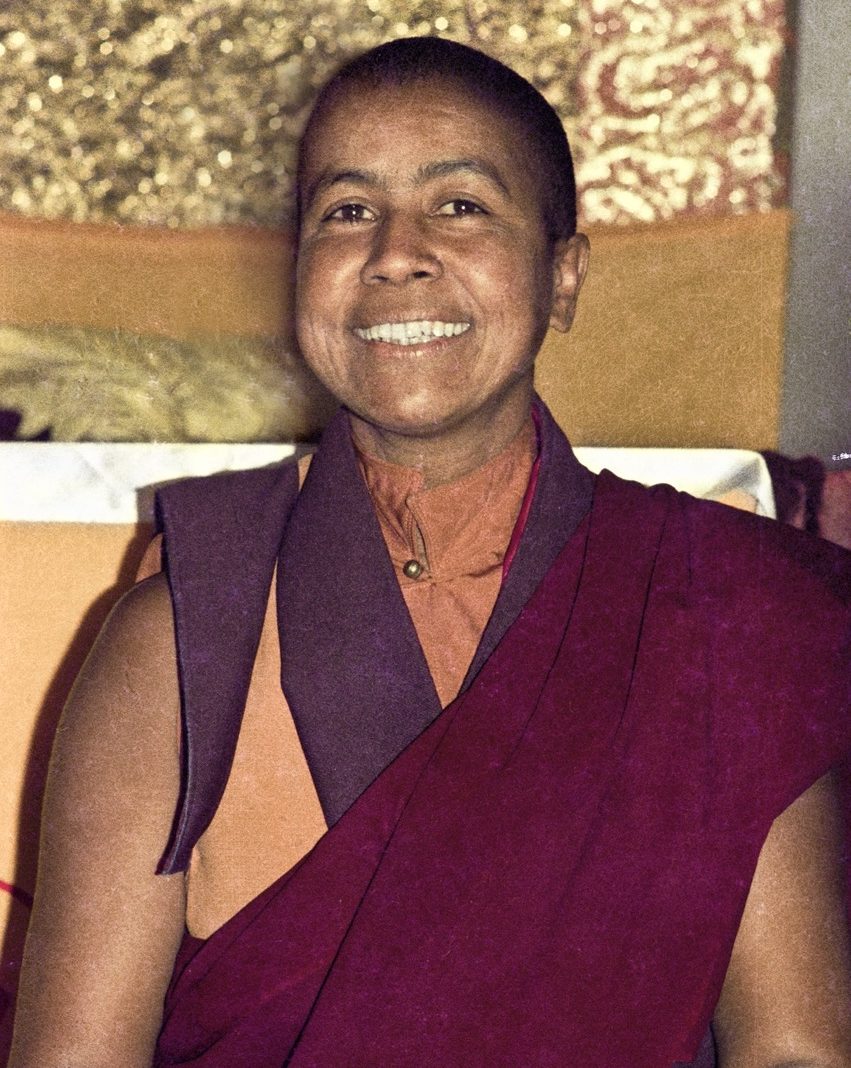
Sister Max giving a talk during the month-long course at Chenrezig Institute, Australia, 1975. Photo courtesy of LYWA collection.
The entire FPMT community shared the loss of one of FPMT’s precious pioneers, when “Mummy” Max Mathews (also known as Sister Max), passed away on February 16, 2024. Mummy Max contributed greatly and financially assisted Lama Yeshe and Lama Zopa Rinpoche in establishing Kopan Monastery and the FPMT organization.
Max lived a fascinating life, full of many adventures. Please enjoy this collection of stories, shared from various perspectives, about and from Mummy Max, and rejoice in a full and generous life in service to others, most notably, Lama Yeshe and Lama Zopa Rinpoche.
Mummy Max explains in Volume One of Big Love: The Life and Teachings of Lama Yeshe: “I felt I had come home and that Lama Yeshe was my guru. He just opened me up completely. I felt balanced and whole, like I was walking on air. I also felt committed. There was no going back.”
“These boys need a mother,” Lama Yeshe told Max [Mathews], when they arrived at Kopan. “You are their Mummy Max.” From Big Love
Chapters
Remembering the Most Amazing Sister Mummy Max | A Very Brief Look at Max’s Many Contributions |
The Car that Saved Mount Everest Centre | Words of Thanks and Reverence for Max Mathews |
The Final Days: A Peaceful Transition
Remembering the Most Amazing Sister Mummy Max
By Peter Kedge, friend of Max’s and another early student and pioneer of FPMT
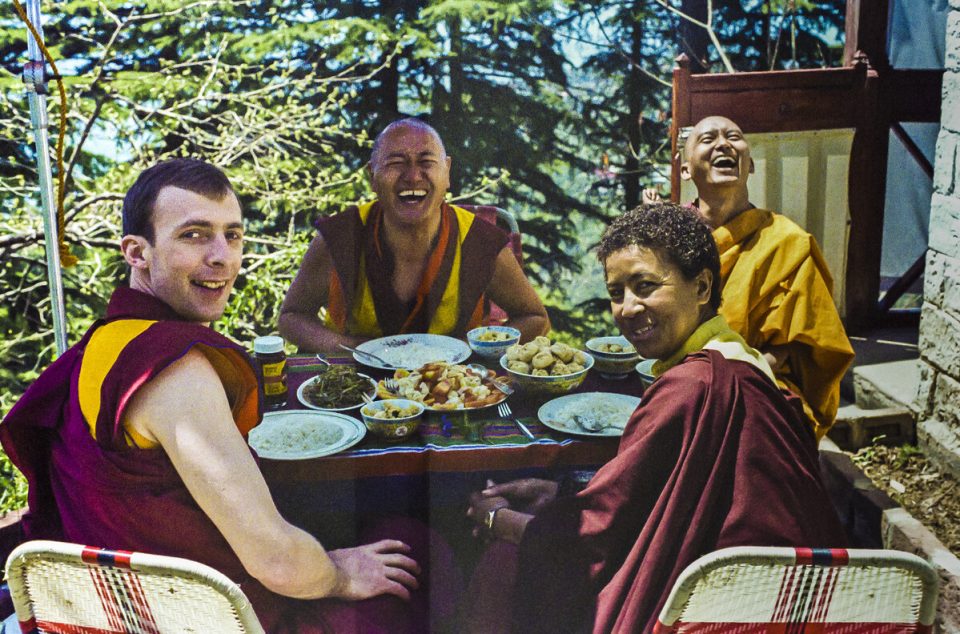
Lama Yeshe, Max Mathews, Peter Kedge, Lama Zopa Rinpoche, First Enlightened Experience, Tushita Meditation Centre, India, 1982. Photo courtesy of LYWA collection.
Born in England, I went to school and University, and in 1966, met up with future FPMT students Harvey Horrocks and Philip Elliott when we worked at the Rolls Royce Aero Engine Division in Derby. We had many adventures together, the highlight of which was probably driving from England to Kathmandu with a plan of eventually reaching Australia.
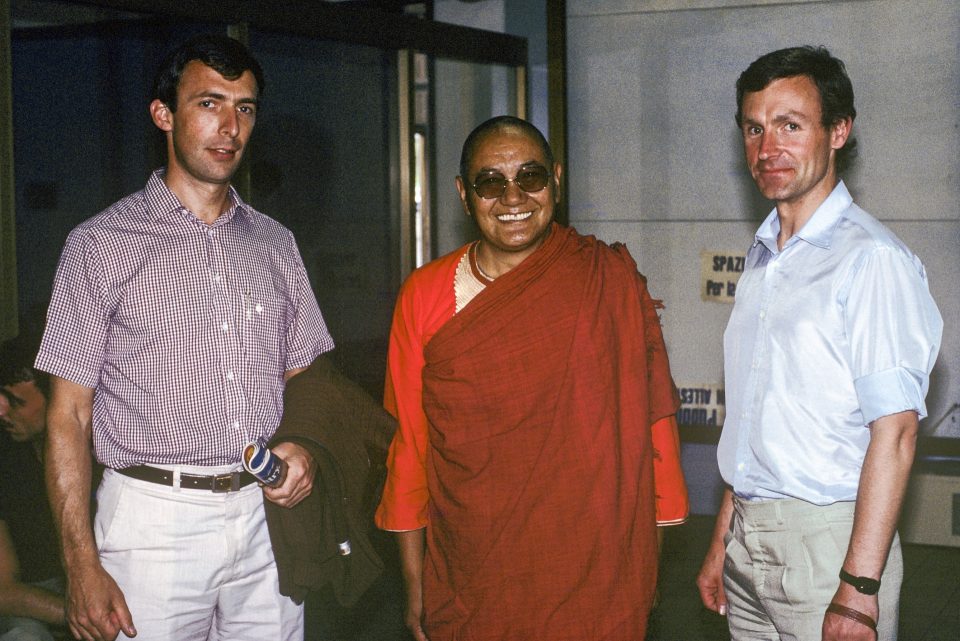
Peter Kedge and Harvey Horrocks with Lama Yeshe at the Pisa airport, Italy, 1983.
Tired of driving, camping on beaches, and exploring the countries we traveled through, we spent six months volunteering with a Christian mission in Pokhara, Western Nepal. We climbed Tent peak in the Annapurna Sanctuary—an experience from which we barely escaped with our lives. We were clearly not mountaineers, and we were clearly not missionary material and so left our hosts to return to Kathmandu.
Harvey and I trekked to Everest Base Camp and another peak, Kala Pattar. On the way we stayed in Namche Bazaar, where I tried meditating for the first time by following instructions from the hippie Bible, Be Here Now by Ram Dass, which one of our female companions was carrying.
On return to Kathmandu days later, I heard there was a Buddhist monastery outside Kathmandu with a Canadian nun, and they were offering a meditation course in English.
Harvey and Philip continued on to Australia. I stayed, and in March 1972, showed up for the second Kopan Course with about 10 others led by Canadian nun Ann McNeil, Canadian monk Jampa Shaneman, and taught by Lama Zopa Rinpoche.
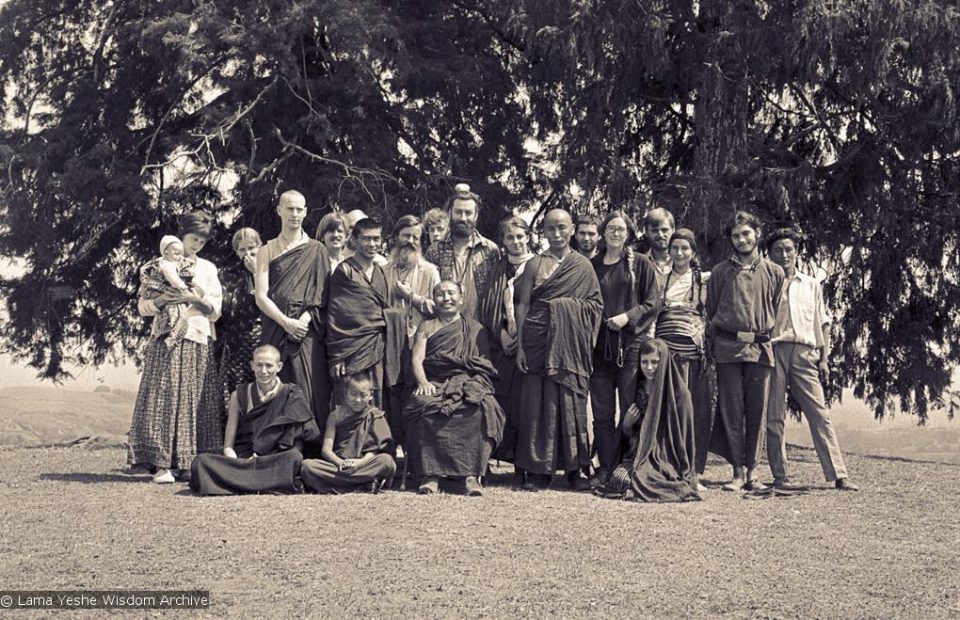
Second Kopan Meditation Course, spring of 1972. Included in the photo from the left are Ann McNeil (Anila Ann), Mark Shaneman (Jhampa Zangpo), Steve Malasky, Gen Wangyal, Age Delbanco (Babaji), Peter Kedge, Geshe Thubten Tashi (seated), Losang Nyima. Photo courtesy of the Lama Yeshe Wisdom Archive.
During the break times, I heard there was also an American nun associated with Kopan who visited from Kathmandu where she was a teacher at the U.S. International Lincoln School.
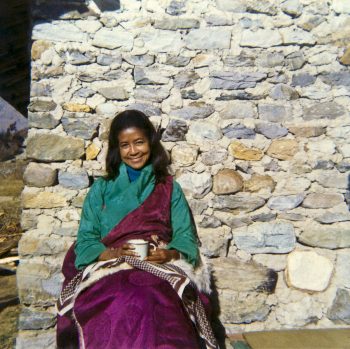
The first trek to Lawudo Retreat Center in Nepal, spring of 1969. Photo courtesy of LYWA collection.
I didn’t see another nun, or at least I didn’t see anyone looking like a nun, until one evening, a black lady in a purple trouser suit drove up and I learned that was Max Mathews the American nun, and the main benefactor of Kopan at that time.
Max heard something about my background, and on introducing herself to me said, “Honey, can you fix cars?” I spent the next three months living in the Rana house Max rented in Tinchuli just outside Boada, and repairing her 1932 Hudson that Max had bought from the King’s palace (see story about Max’s Hudson below).
That was the beginning of 50+ years of close friendship that sadly ended when Max passed earlier this year.
There are two things I remember Max for.
One is the extraordinary karma by which Max’s life brought the foundations of Kopan together.
The other is Max’s unreserved generosity.
Max was born into abject poverty in Redford, Virginia, on October 11, 1933.
After her parents died, social services placed Max with a local family which Max didn’t get on with, so she upped and left for New York to stay with her older sister until social services caught up and placed her with a wealthy family of lawyers in Washington D.C.
Suddenly, Max was circulating in, and learning how to be part of, high society. Later with her Columbia University Master’s degree, government job, diplomatic passport, and postings to Germany, Greece, and Moscow, Max was living life with the elite of the world.
During teaching breaks in Athens, Greece, Max holidayed on the island of Mykonos where she met Ann McNeil (later Anila Ann). Max met Zina Rachevsky (who would become Lama Yeshe and Lama Zopa Rinpoche’s first Western student) in Athens and took Ann to meet Zina. When Max moved on from Athens to Moscow, they each took different paths for the next three years.
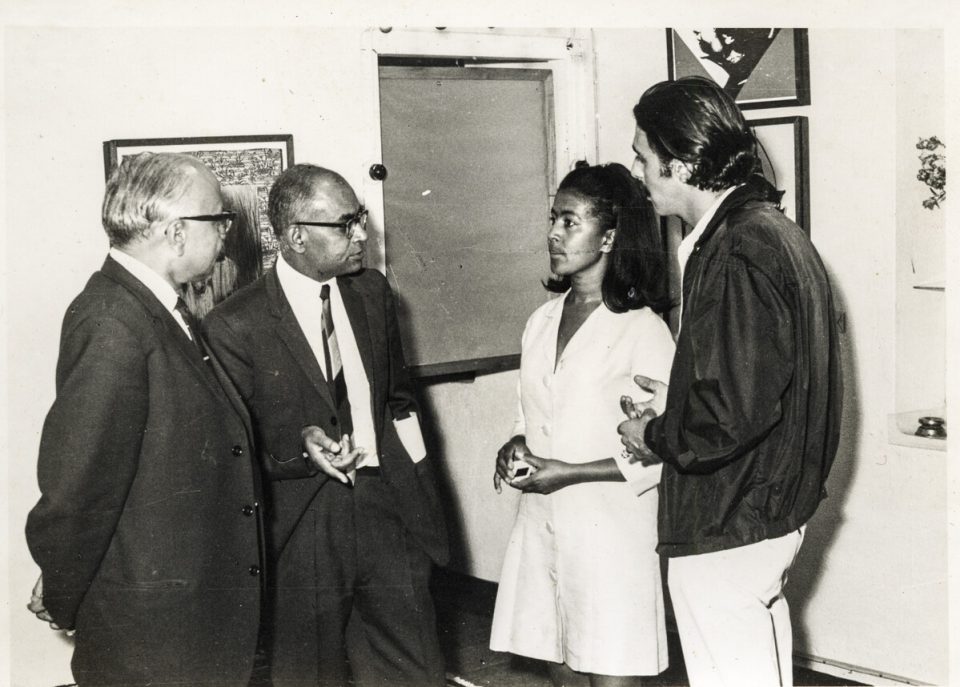
Max Mathews hosting an event at her art gallery in Kathmandu, Nepal, 1969. Photo courtesy of LYWA collection.
Then during Max’s posting to Lincoln School in Kathmandu, Nepal, Zina one day appeared from Darjeeling with Lama Yeshe and Lama Zopa Rinpoche. Zina introduced Max to the lamas and on meeting Lama Yeshe, Max collapsed in tears. From then on her life’s purpose was clear.
Zina asked Max to look after the lamas financially because Zina was out of money and Max agreed. Max contacted Ann in Greece and asked her to come to Kathmandu to help her look after the lamas as well.
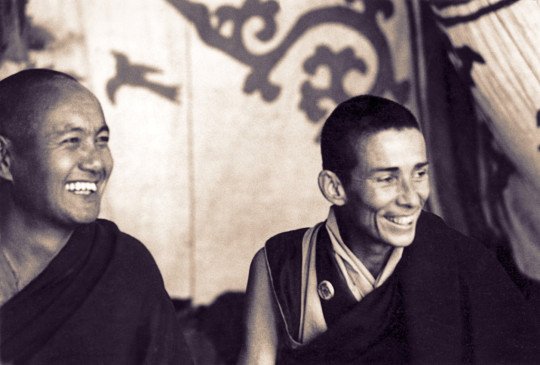
Lama Yeshe with Anila Ann (Ann McNeil), Kopan Monastery, Nepal, 1974. Photo courtesy of the Lama Yeshe Wisdom Archive.
And there they were—Lama Yeshe, Lama Zopa, Zina, Max, and Ann, together in Kathmandu. They were the pioneers establishing the foundation of Kopan and eventually, the entire FPMT organization. Ann, Max, and Zina all took ordination.
For me, the karma that brought that about and all that has followed is nothing short of mind blowing.
The most outstanding quality of Max has always been her unreserved generosity—firstly and foremost toward Lama Yeshe, Lama Zopa, and the Mount Everest Centre (which grew into Kopan Monastery and later, Nunnery as well).
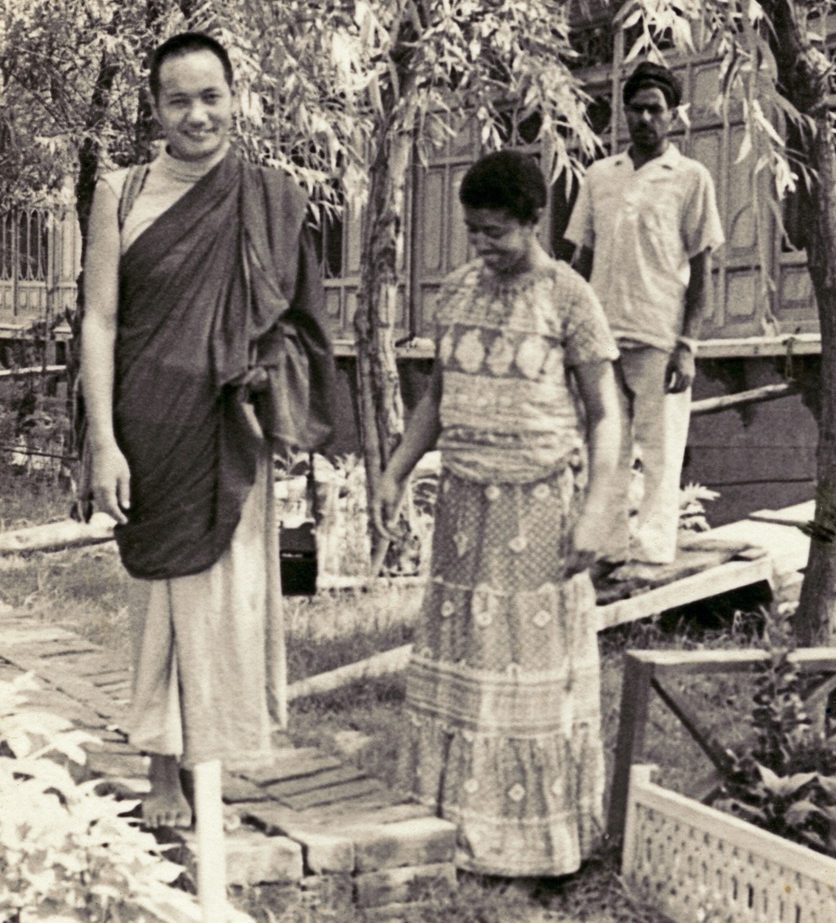
Lama Yeshe on holiday with Max Mathews in Srinagar, Kashmir, 1970. Photo by Domo Geshe Rinpoche who also accompanied them.
Whatever the lamas needed for their well-being and projects, Max did her utmost to fulfill. When Max received her salary check from Lincoln School, she would bring it to Kopan, and give the check to me to take down to Kathmandu and convert it to Nepalese rupees.
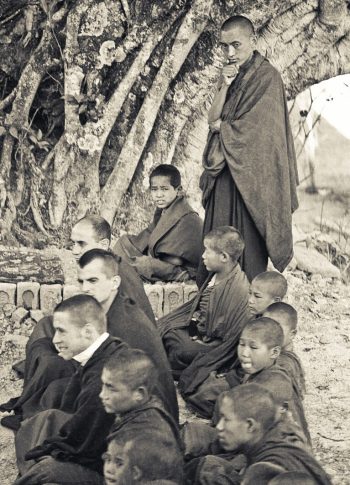
Lama Zopa Rinpoche with Mount Everest Centre boys beside the ancient bodhi tree at Kopan Monastery, Nepal, 1974. Photo by Ursula Bernis.
The rupees would come back up to Kopan and they would be used for whatever Lama Yeshe needed, and now with young Sherpa Mount Everest Centre monks to care for, it meant robes, food, fuel, and accommodations that had to be built as well as a gompa. So Max’s salary also went to buy cement, iron re-bar, sand, bricks, to hire laborers, and pay for trucks to bring all these supplies up to Kopan.
This was Max. Whatever was needed, Max would provide. And not only for the lamas. There was an increasing number of people that Max supported—Tibetans, Nepalese, older monks at Kopan, former monks who had escaped with Lama Yeshe from Tibet, Anila Ann, and other Westerners.
Max became known as, “Mummy Max” as that was the role Max played for so many.
Soon, a teacher’s salary was not enough. Max stopped working at Lincoln School and went headlong into business determined to generate more income.
Max started making garments in Kathmandu and then later in Delhi. Max became so successful she was featured in Time magazine with her fabulous line of sequined dresses, which sold for hundreds of dollars in New York.
Max completely supported Lama. When eventually Lama’s health declined, Max paid doctors’ bills and air tickets. Max flew Lama to Delhi, paid for more specialists and hospitals, flew Lama first class to California, paid for Lama’s treatment at Cedar Sinai Hospital, an air ambulance, and all of Lama’s care. Max offered her credit card and made it completely available to cover the considerable expenses of Lama’s funeral at Vajrapani Institute. This was Max’s utter devotion. Lama and Rinpoche always came first.
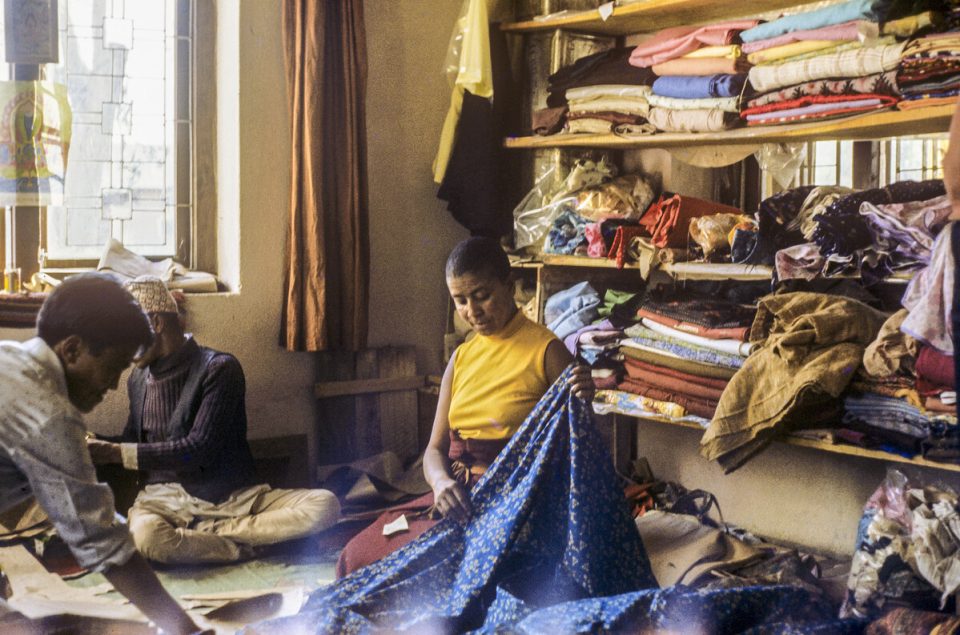
Max Mathews with fabric for her clothing business, New Delhi, 1976. Photo courtesy of LYWA collection.
The last few months of Lama Yeshe’s life took Max ‘s focus away from the business and unfortunately some of her associates took advantage of Max’s absence during those months and the garment business collapsed.
Even after Lama’s passing, Max was determined to generate funds for Rinpoche, Kopan, and the growing sangha.
Max switched from garments to Indian antique furniture which Max exported to the United States. Max took up residence in Colorado and opened a furniture gallery, traveling back and forth to India to buy stock.
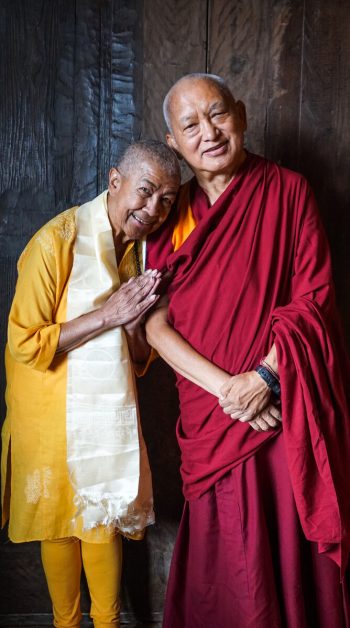
Sister Max and Lama Zopa Rinpoche, United States, August 10, 2017. Photo by Lobsang Sherab.
At almost 80 Max moved into senior housing in Santa Fe and became close with Thubten Norbu Ling, the FPMT center there.
Max never stopped trying to raise money for Rinpoche, the Santa Fe center, and her many other projects. Some of the schemes Max tried were online and unfortunately involved people who took advantage of her trusting nature.
At 88, Max still had a vision of creating, “the most fabulous gallery and restaurant” in the building the center had recently purchased.
Max never sought recognition or thanks. She always downplayed the incredibly significant part she had played in building Kopan, helping Lama and Rinpoche to build FPMT, and as a consequence, helping the spread of Buddha Dharma in the West.
Max’s passing was as close to “textbook” as can be hoped for. Students of the center and visiting geshes kept a prayer vigil. Nursing staff and hospice carers were on hand 24 hours a day and Max passed peacefully at home. The funeral home allowed the body to remain in place packed by dry ice until the consciousness had left.
Of her part in the establishment of Kopan, Max would always say, “I didn’t do anything.” Yet what an incredible life Max packed into her 90 years. What an example of generosity, what an understated contribution Max made to Kopan, and to the life work of Lama Yeshe and Lama Zopa Rinpoche.
Written by Peter Kedge, friend to Max and early FPMT student, former FPMT Inc. board member, and former director and CEO of the Maitreya Project. Please read this 1995 Mandala magazine article about Peter’s own generous contributions to the early activities of FPMT, “Turning Money into Dharma.”
A Very Brief Look at Max’s Many Contributions
This interview with Max Mathews was filmed in July, 2020 in Santa Fe, New Mexico, with images from Big Love: The Life and Teachings of Lama Yeshe. Mummy Max shares her spontaneous and intimate firsthand stories of her timeless relationship with Lama Yeshe and Lama Zopa Rinpoche:
Watch Big Love: An Interview with Max Mathews aka Mummy Max
https://www.youtube.com/watch?v=eQMNDG7-ocE
Adele Hulse writes of Max’s early years in Big Love:
Born in 1933 to a desperately poor black undertaker in Virginia, Max and her siblings had often helped embalm bodies after school. “Embalming was all the go with poor blacks,” she said. Her parents’ marriage broke up when she was around ten years old and she was adopted into a wealthy white family, with a house on the West Coast and an apartment in New York.
Max eventually got a Master’s degree in education from Columbia University in New York, and after graduating she was ready for adventure. Joining the American diplomatic service as a teacher gave her the freedom to travel, the security of American protection and an American salary. Her teaching career took her to Greece, Germany and Moscow. In August 1968, it landed her in Kathmandu.
After receiving her Master’s degree, she was employed by the U.S. Department of Defense, which oversaw the U.S. International Schools network and held postings in Athens, Berlin, Moscow, and Kathmandu since 1958.
In 1960, while working in Greece, Max Mathews met Zina Rachevsky and Ann McNeil, who was originally from Canada. They became good friends. Max spent five years in Greece. She explained, “Of course, we had at least five years in Greece together before the lamas even came, they weren’t even in our knowledge. When we parted, we didn’t know that we had all been students of the lamas before.”
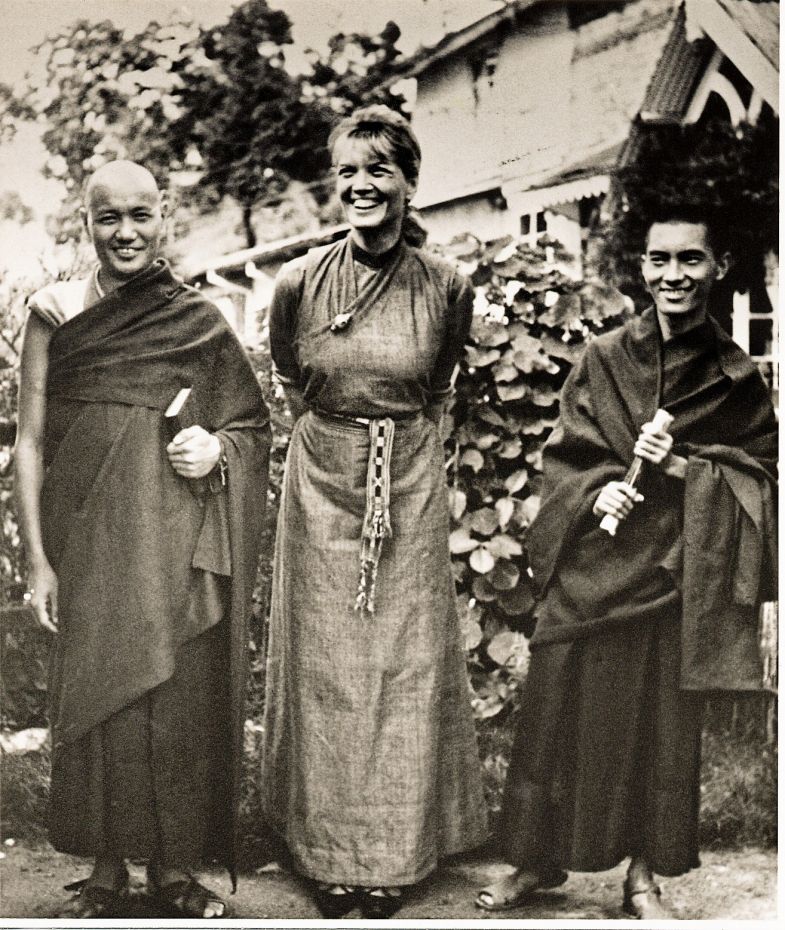
Zina Rachevsky with Lama Yeshe and Lama Zopa Rinpoche, 1967. Photo via Lama Yeshe Wisdom Archive.
In 1968, Max taught at the U.S. International Lincoln School in Kathmandu. She worked there until the early 1970s. She bought works of persecuted Jewish artists in Moscow and brought them to Kathmandu. In Kathmandu, she would purchase Tibetan thangkas and statues from Tibetan refugees. She opened an art gallery in a two-story building at Kantipath across from the American Embassy Consulate office. The gallery also had a café where poets, artists, and writers would meet.
Max developed good relations with King Mahendra as he was happy about her interest in promoting Nepali art. The King even inaugurated some of her exhibitions.
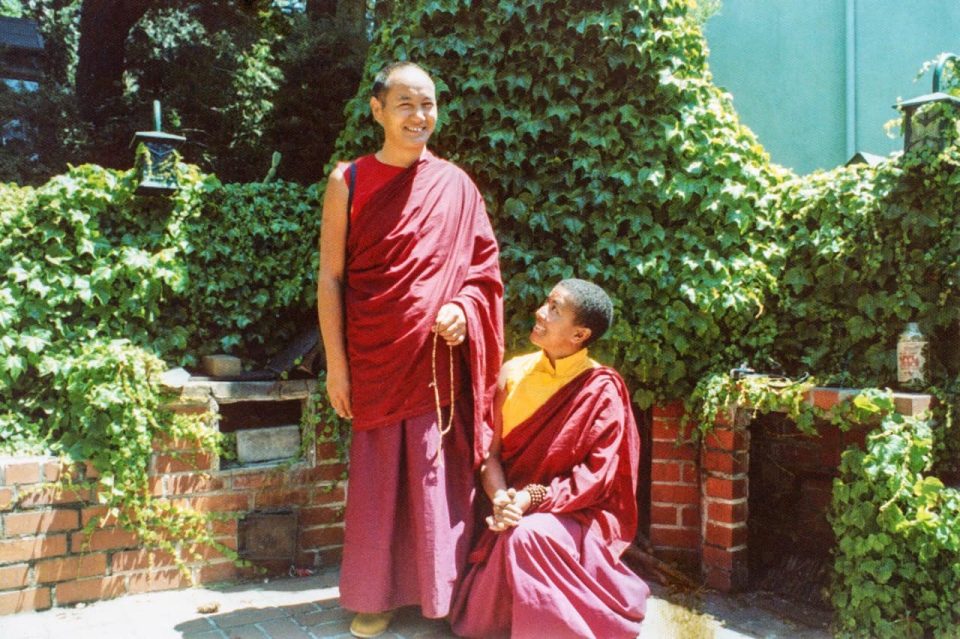
Lama Yeshe and Sister Max in Berkeley, California, 1974. Photo by Judy Weitzner
In 1968, Zina and Max met again in Kathmandu. By that time Zina had become a student of Lama Yeshe and Lama Zopa Rinpoche, traveled with the lamas, and finally settled in Kathmandu where they decided to build a monastery. Zina came to Max’s gallery where Max and her guests were having a Thanksgiving party and begged her to help take care of the lamas.
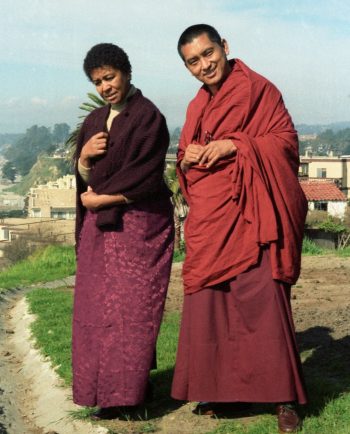
Max Mathews and Lama Zopa Rinpoche, Aptos, California, March, 1984. Photo by Åge Delbanco.
Max tells about her first meeting with Lama Yeshe and Lama Zopa Rinpoche in a 2020 interview:
So, Lama Yeshe was the first one I met, and he opened the door, folded his hands, and bowed to me. And at that time my heart went “Zoom! Open, open, open!” and I was on the floor and in tears. I was crying so hard because whatever he did to me, he put in my heart when he opened it, is still there. And I cried and cried. It was like years, but it was only like five minutes, and Lama Zopa then showed up. And that very moment from the floor, I promised Lama Yeshe because he requested me, and I gave my life, my heart, my body, mind, and soul to him forever, forever. As long as they needed me, I would do whatever I could to help them succeed with their journey. I promised the lamas, when I met them, that I would always be there for them and do and help as much as I could and provide service for them and their journey.
The same year Max visited old friends in Greece and met Marty Widener, who she married in a ceremony led by Lama Zopa Rinpoche and Lama Yeshe in Tinchuli, Bouddha.
Lama Yeshe and Lama Zopa Rinpoche finally found a suitable place for building a monastery. It was a house of an astrologer on Kopan hill. With Max’s financial help, they were able to buy the land. Max would spend her weekdays in the city and the weekends on Kopan hill.
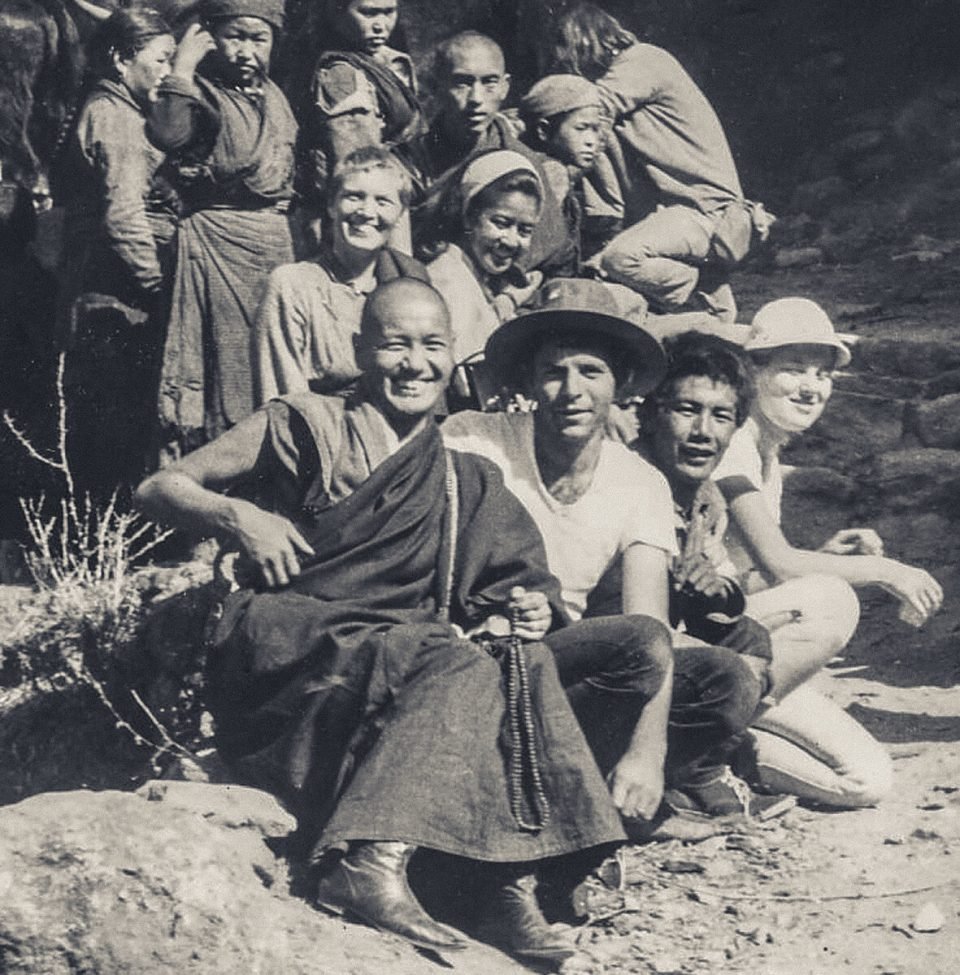
The trekking group to Lawudo, pictured from front: Lama Yeshe, Chip Weitzner, Dorje Sherpa, Judy Weitzner. Above: Zina, Max, and behind Max, Lama Zopa Rinpoche. Photo courtesy of Lama Yeshe Wisdom Archive.
In early 1969, Max, Zina, her film crew, Judy and Chip Weitzner, and the lamas left for Lawudo. Max discussed this trip in an interview from 2020:
We spent maybe a week in Namche. Many of the villagers knew Rinpoche. Lama Zopa was the Lawudo Lama. He had been in Tibet studying at the monastery, and people would come running out with kathas and gifts, just because Rinpoche had not come back since he left Lawudo to go to Tibet to study.
Now was the first time. So at this point he must have been early 20s. I’m guessing. I don’t really know, but the people recognized him and were so happy that he was back. And then everywhere we went, the people would come to Rinpoche, and they would request that he would please set up a traditional monastic school for boys. They begged and pleaded with him to open the school. I don’t remember Rinpoche’s response, but I’m sure he agreed, because first Mount Everest Center for Buddhist Studies was opened with 27 boys at Lawudo, which had become Lama Zopa’s cave.
The lamas decided to start Kopan in Lawudo and accepted the first group of young monks. Mummy Max was the main benefactor supporting the early growth of Kopan Monastery north of Bodhanath. “Max’s entire Lincoln School salary supported not only the early building at Kopan, but the entire education and maintenance of about 50 young Sherpa and Tibetan monks in the Mount Everest Centre school,” recalls Peter Kedge.
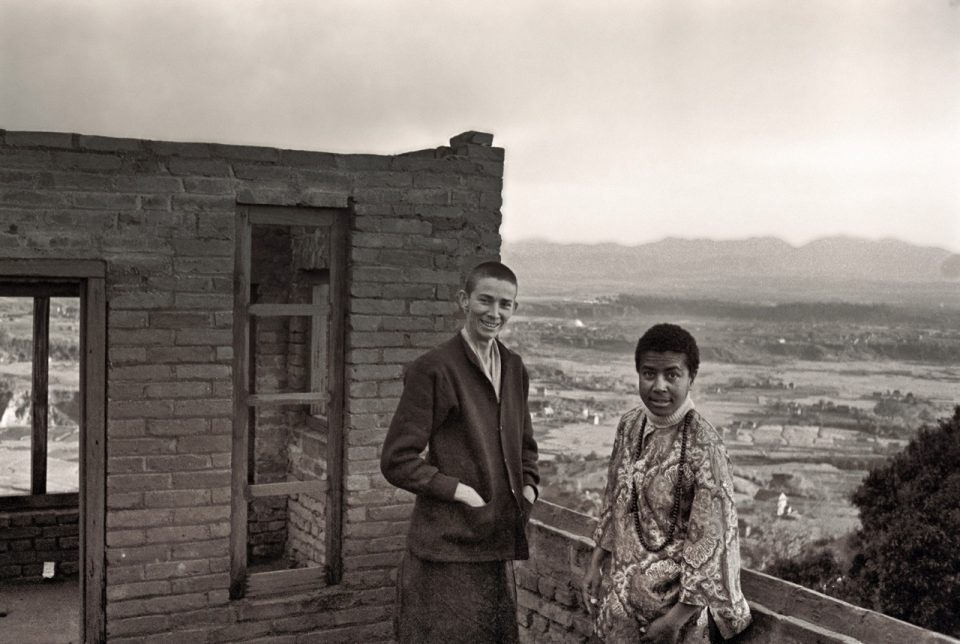
Anila Ann and Max Mathews on the roof of Kopan Monastery as the second floor is in progress, 1972. Photo courtesy of LYWA collection.
After coming back from Lawudo, Lama Yeshe started overseeing the construction works at Kopan hill. “We built resident quarters, kitchen, eating hall, and toilets and water and everything for bathing for the young monks,” Max shared. “And it took most of the ’70 and early ’71. By ’71, we had the first ordination.”
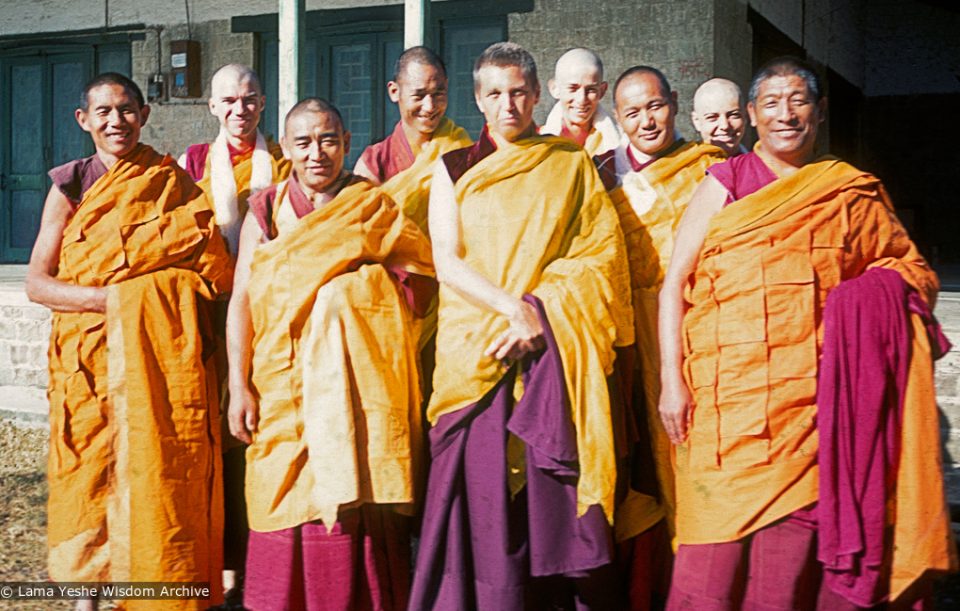
(12509_sl-3.psd) The first ordination of a group of western students, Dharamsala, India, 1970. Zina Rachevsky is in the front row between Gen Jampa Wangdu and Lama Yeshe. Ann McNeil (Anila Ann) is just to the right behind Zina, and Sylvia White is also in the back row to the right of Lama Yeshe. A student named James is second from left in back row, and Max Mathews, who also ordained that day, is curiously absent.
By 1971, there was enough space for small groups of students to come for the meditation course. Max recalled, “Westerners started getting notices to come to Kopan from the city, from everywhere around the world. And so, in ’71 we had the first course. And we had enough built that could take care of the small numbers that came. And then ’72 and ’73 was course two and three and going on.”
As Max was the principal source to support the Mount Everest Centre boys, she was concerned about a more enduring source of income, not just dependent on her personal salary. She decided to start a fashion business in Kathmandu with the first label “Samsara” and later moved her business to Delhi. Max shared, in Big Love:
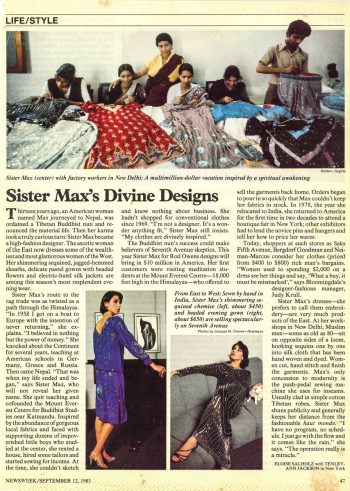
Time Magazine article on Sister Max Mathew’s fashion, September 12, 1983. Photo courtesy of LYWA collection.
Business was gradually getting better. I remember the first time I went back to America for my first show. I went to this huge convention center straight from the airport and didn’t even know how to price things, but everyone was helping me. From this tiny little stand at the show I sold everything I had and got back on the plane with all this money. I would never have had the courage to do that if I hadn’t gone back to the States first with Lama in 1974. I was flying, ten feet off the ground! I knew it was all due to Lama’s blessing. My first label was Samsara, then Yeshe, and then Sister Max, which was the one that succeeded.
Max was also part of the beginnings of what we call Universal Education. She wrote a program for teachers based on many discussions with Lama Yeshe. From Big Love:
Max Mathews stayed on the tour for the duration of her school holiday leave. In Nashville, Indiana, she spent time working on an innovative education project that Lama had discussed with her. Lama had told her he believed Buddhism could be taught all around the world without using any Buddhist terms at all and in such a way that children could learn that life is impermanent, all things are interrelated and the path to life’s fulfillment involves exercising compassion and wisdom and applying appropriate methods. Max thought the first thing to do was to prepare texts in order to be able to train teachers. She wrote out a program, developed concepts and had long discussions with Lama. News of her work elicited offers from two American universities to complete a PhD in educational research but she did not accept. When the lamas left for Wisconsin, Max returned to Nepal and her job at Lincoln School.
“Her diminutive size greatly belies the vastness of her compassionate heart and spirit,” Jan Willis said about Max in 1996 in an article she wrote for Mandala magazine, “Sister Max: Working for Others.”
In Big Love, Peter Kedge explained:
Sister Max unreservedly supported Lama Yeshe financially in whatever he undertook or needed. From the day they met, Max held nothing back, unhesitatingly providing whatever Lama needed. Max offered literally everything she had with a pure heart and never a thought for herself. Every time Max received her salary check from Lincoln School it immediately went for Lama and the Mount Everest Centre one hundred percent. Later, when Max had funds from her business, it was the same. Whatever Lama needed Max provided. Max knew when Lama was exhausted and she took him away and looked after him. Max spent whatever it took, whether for a comfortable place to stay, a nice hotel, a break for retreat, a holiday, a heater, good food, school supplies, building materials, food for the school or whatever. Max was always five hundred percent there for Lama. The way Max took care of Lama was the definitive lesson in generosity and an extraordinary inspiration. No one could have done more, and Kopan would not have existed without her unstinting support.
When Lama Yeshe passed away in 1984, Mummy Max, together with other senior students, sponsored pujas for Lama Yeshe. Ven. Yarphel (John Jackson) recalled in Big Love:
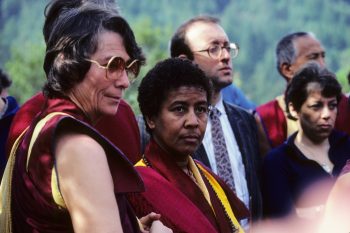
Cremation of Lama Yeshe, Vajrapani Institute, California, March, 1984. Photo includes Anila Ann, Max Mathews, Massimo Corona, Geshe Thinley, and Cecily Drucker. Photo by Ricardo de Aratanha.
It was interesting to see Sister Max’s complete lack of concern for her future. She paid for all the lamas to come here and overall, we had 175 people. Station wagons were hired to pick them up, everybody ate for free during that whole week. Everything was offered. Max and some old students paid for everything. At every puja all the lamas were offered hundreds of dollars in white offering envelopes—not like the usual $20 donations. Zong Rinpoche was offered about $1,000 at each puja and the others about $300 each.
We were making as many offerings as we could. We even drove through Santa Cruz offering money to hungry people on the street. The whole thing was under the advice of Zong Rinpoche and Lama Zopa, who was like his lieutenant. Sister Max eclipsed everybody. I didn’t see what she put through on her credit card, but of the $100,000 or so that I handled, $70,000 came from her. It was Max, of course, who had unhesitatingly paid the $15,000 bill from Cedars-Sinai Hospital.
The Car that Saved Mount Everest Centre
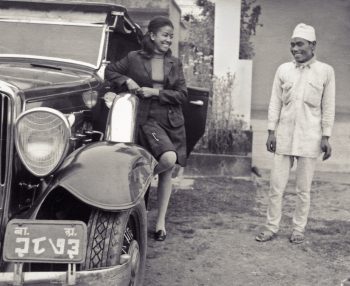
Max with her 1932 Hudson. Photo credit: Chitraker.
Shortly after they were built, two 1932 Hudson Phaeton cars were shipped to Calcutta, then carried by porters over the mountains into Nepal. That was the only way to bring vehicles into Nepal before the Raj Path was built in 1956. One of the vehicles was for the King of Nepal and the other was for the Prime Minister.
The history of at least one of the 1932 Hudson’s is really quite remarkable.
Max Mathews bought one of them from the King’s palace in the late 1960s. She recalled discovering that this car was available for purchase, “Wow, my heart starts racing and I have to get that car. I buy it, and I drive it around Kathmandu on the unpaved roads. There are no roads on Kopan at all, so that’s something we have to deal with.”
The car fell into disrepair and in 1972 Max asked Peter Kedge if he knew anything about cars. Indeed, he did! From age eleven, he had worked for two years in a bicycle shop, then at a garage during every school holiday until he graduated from university ten years later. By that time, he had spent more time working on cars than driving them. She asked whether he could help get the Hudson back into running condition. The car was stored in one of the Rana homes in Tintuli that Max was renting just outside Boudhanath. Peter spent three months at Tintuli with very few tools but did get the car running well again.
In the meantime, Max was the main benefactor supporting the early growth of Kopan Monastery north of Boudhanath. Peter stayed on at Kopan after the second course in 1972. He wanted to help and there was always work to do—either securing supplies for building the gompa, driving supplies to Kopan, managing the laborers, etc.
Max’s entire Lincoln School salary supported not only the early building at Kopan, but the entire education and maintenance of about 50 young Sherpa and Tibetan monks in the Mount Everest Centre School. In the summer months the school was held in Lawudo and in the Winter months the school would come down to Kopan where it was less cold.
In the Summer of 1973 an emergency message came down from Lawudo to Kopan saying that the school had run out of food and money.

The restored 1932 Hudson. Photo courtesy of Calvin Buchanan.
As always, taking full responsibility without any reservation Max immediately said to Peter, “Sell the Hudson.”
Peter placed an advertisement in the Rising Nepal newspaper and a gentleman from the U.S. Embassy responded, viewed the car, and purchased it. The proceeds from the sale of the Hudson saved the school and supported the 50 children and their teachers for quite a while.
The car was shipped through Calcutta to the U.S. and eventually ended up with a Hudson collector in Texas. A few years ago, the car’s owner, a collector who has more than twenty such vehicles, traveled to Santa Fe to meet Max and find out more about the car’s history. Since that time, the car has been completely renovated back to the original factory condition and colors.
Words of Thanks and Reverence for Max Mathews
On hearing the news of Mummy Max’s passing, many old and new friends around the world expressed moving tributes of thanks and reverence for Max. Here we share some of these sentiments:
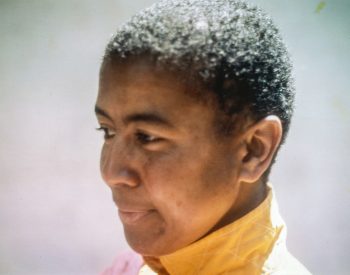
Max Mathews, 1974, Berkeley. Photo by Judy Weitzner.
“We rejoice how Mummy provided unconditional and essential support for the Lamas’ Western Dharma project as envisioned by His Holiness the Dalai Lama and remember how we are dependent upon Mummy Max for her mandala role in bringing the Dharma of Lama Yeshe and Lama Zopa Rinpoche to the West.” —From the Lama Yeshe Wisdom Archive
“Max’s dedication led her to play a crucial role in establishing and funding Kopan Monastery in the 1970s. Her generosity created a haven for spiritual seekers. Her passing marks the loss of a remarkable soul whose philanthropy touched many lives. Tonight, in the presence of Kyabje Khen Rinpoche, all the monks gathered to pray for her to be reborn in a higher realm and eventually attain Nirvana.” —From Kopan Monastery
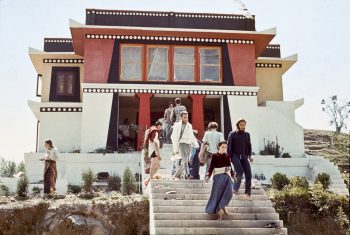
Front view of Kopan Monastery 1972, with students on the steps. Photo courtesy of the Lama Yeshe Wisdom Archive.
“It is impossible to imagine what Kopan (and the FPMT) might have been without her. When I first arrived at Kopan in the fall of 1972, Sister Max was single-handedly supporting the Lamas, thirty or so young Sherpa monks there at the time and the entire monastery infrastructure. She was a teacher at the American Lincoln School in Kathmandu and donated her entire salary to Kopan. Her generosity and devotion to Lama and Rinpoche were exemplary and inspiring and motivated many of us to devote ourselves to trying to emulate her in helping the Lamas in their mission to preserve and spread the Dharma for the enlightenment of all sentient beings. Today we see the incredible results. It would not have happened without her.”—From Nick Ribush
The Final Days: A Peaceful Transition
FPMT center, Thubten Norbu Ling, offered support to Max in her final days. They shared this moving account of her passing.

Max at the end of her life. Photo shared by Losang Dragpa Centre FPMT Facebook page
As Mummy Max celebrated her 90th birthday, little did we know that her journey on this earth was nearing its end. In her final days, the volunteers from The Buddhist Center took turns by her side, reciting Medicine Buddha Puja, The Eight Prayers to Benefit the Dead and Dying, The Vajra Cutter Sutra and many others. Messages, help and encouragement kept coming from around the world, and we spent the days doing practice, playing Lama Zopa’s mantras in the background and showing Mummy Max pictures of the lamas and holy objects.
Although weak, she was clear and attentive, holding our hands and sharing big smiles and hugs, whenever she woke up. She did not display any sign of pain, anxiety, or discomfort until her last breath. Her transition from this world was marked by a profound sense of peace, leaving those by her side feeling connected, uplifted, and inspired.
When Mummy Max stopped breathing, we were prepared. We managed to identify a local funeral home, which respected the Tibetan Buddhist customs. She was able to remain undisturbed in her apartment until she concluded her final meditation. The atmosphere in the room was clear and vivid, and Geshe Tenzin Zopa said that there was no doubt that Mummy Max was in the clear light meditation. At that time, we did practice in her room day and night, dedicating for her most fortunate rebirth. After two days, Geshe la confirmed that Mummy Max’s meditation came to an end.
Geshe la recited the Guhyasamaja Root Text and other prayers recommended before the removal of the deceased person’s body. Before Mummy Max’s worldly remains left the apartment, she was turned 3 times clockwise. Geshe la explained that according to Tibetan customs, sending the body off is like losing a precious gem and turning it three times allows for the precious energy to be preserved in our world system. Geshe la also checked for the best day suitable for cremation, which the funeral home agreed to honor.
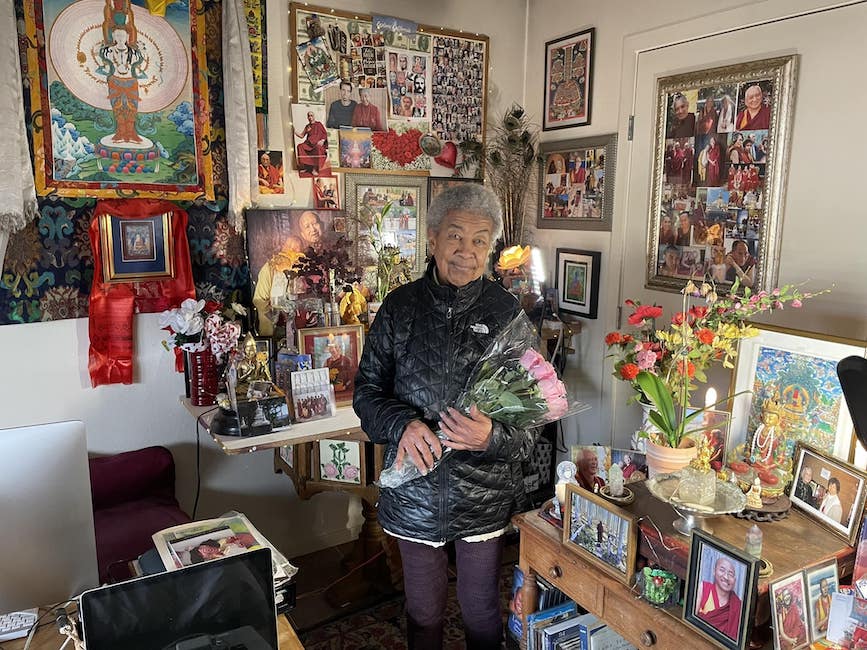
Mummy Max, Santa Fe, New Mexico, 2022. Photo by Steve Nadeau
“Mummy Max’s legacy lives on in our hearts, reminding us that through love, compassion and sincere practice, each of us can transcend the limitations of our human existence. As we reflect on Mummy Max’s life, we extend our deepest gratitude to our resident teacher, Geshe Thubten Sherab, Geshe Tashi Dhondup, Geshe Tenzin Zopa, and all the volunteers and supporters who selflessly dedicated their time and resources to ensure her peaceful and meaningful transition. Their unwavering commitment to her spiritual and physical well-being is a testament to the bonds of family and community that unite us all.” —Thubten Norbu Ling, Santa Fe FPMT Center, from a Facebook message following Max’s passing.
You can learn more about Max’s life in this 2020 interview, where she tells her own story about her relationships with the lamas. You can also read about Mummy Max’s first trip to Lawudo, as told by her old friend Judy Weitzner; find an excerpt about her in Big Love; an article by Jan Willis from Mandala magazine (1996), “Sister Max: Working for Others”; and an article from the Kathmandu Post, “The Enduring Legacy of Sister Max”.
Big Love, written by Adele Hulse, is the official, authorized biography of Lama Yeshe containing personal stories of the lamas and the students who learned, lived and traveled with them, as well as more than 1,500 photos dating back to the 1960s.
Please pray that Mummy Max Mathews may never ever be reborn in the lower realms, may she be immediately born in a pure land where she can be enlightened or to receive a perfect human body, meet the Mahayana teachings and meet a perfectly qualified guru and by only pleasing the guru’s mind, achieve enlightenment as quickly as possible. More advice from Lama Zopa Rinpoche on death and dying is available, see Death and Dying: Practices and Resources (fpmt.org/death/).
- Tagged: big love, fpmt history, mummy max, obituaries, obituary, road to kopan, ven max mathews
16
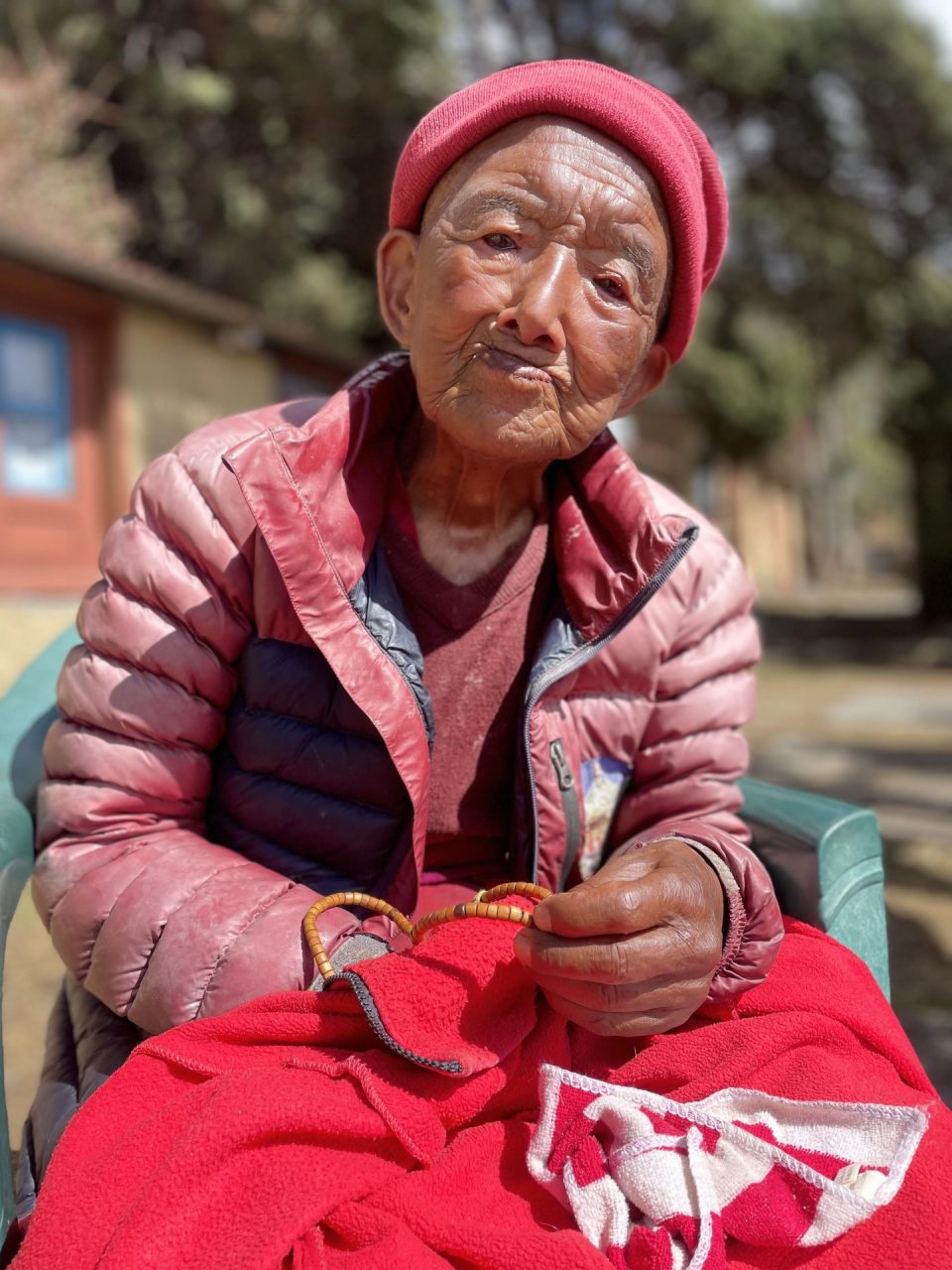
Ven. Ngawang Yonten, “Ashang,” 2023. Photo by Ven. Sarah Thresher.
Lama Zopa Rinpoche’s uncle, Ven. Ngawang Yönten (affectionately known as Ashang, which means, “maternal uncle”) passed away peacefully at Lawudo, Nepal, on the morning of July 7, 2024. He was 98 years old and most likely one of the last of the local Sherpas to have known both Lawudo Lamas. Please read this beautiful account of Ashang’s life, written by Ven. Sarah Thresher with input and details from Anila Ngawang Samten, Gelong Ngawang Nyendak, Jamyang Wangmo (including consultation of The Lawudo Lama), and Ven. Tsultrim,
To visitors at Lawudo, Ashang was a constant presence at the lower retreat huts where he recited mantra continually from morning to night, stopping only to eat, sleep or go to the bathroom. He seemingly had no attachment to worldly things and Rinpoche would often fondly relate stories from his life of practice (see The Lawudo Lama).
Ashang was born in Thame in 1926, the Year of the Tiger. He was the youngest of six children—three girls and three boys—and his father (Rinpoche’s grandfather) died while he was still in the womb. Lama Zopa Rinpoche’s mother, Nyima Yangchen was the eldest child in the family. The family had five yaks and when he was young he would take care of them, bringing them up to Tengbo, and also help Rinpoche’s father with their yaks. When Rinpoche’s father passed away leaving the mother with three small children, he helped as much as he could.
In 1955, when he was in his late 20s, Ashang became very sick and nobody could help. Two years later when Rinpoche’s uncles decided to go to Tibet for pilgrimage, Ashang also came along, bringing their luggage on his five yaks as far as Dingri Ganggar. There he went to see a famous Tibetan doctor, but the doctor couldn’t help him. After visiting another doctor who also couldn’t cure him, he decided to go to Dza Rongphu to see Trulshik Rinpoche. Trulshik Rinpoche advised him that his sickness was due to karmic obscuration and could not be cured by medicines but only through purification practices. Ashang requested to be ordained as a monk and Trulshik Rinpoche advised him to do the preliminary practices first. Ashang stayed six months at Rongphu receiving teachings and then took getsul vows. He returned to Khumbu with his five yaks loaded with salt and decided to sell the animals and devote himself fully to Dharma practice.

Ashang, Amala (Rinpoche’s mother) and Ani Ngawang Samten (Rinpoche’s sister) in 1983.
As the youngest son, Ashang was responsible to take care of his mother (Rinpoche’s grandmother) who was now old and blind and could not be left alone. He obtained permission from Charok Lama Kushog Mende to build a small hut under the cliff at Charok and he moved there with his mother. The hut was very small so Ashang would spend the night in a small square meditation box while his mother slept on a wooden bench next to the fireplace. He did prostrations on a wooden board outside the hut. In addition to his own Dharma practice, he did all the cooking, collected firewood and fetched water because his mother could do nothing except recite mani mantras.
Ashang spent eleven years in that hermitage and completed seven sets of the preliminary practices (prostrations, Vajrasattva, mandala offerings, guru yoga) while caring for his mother. Over the years his health improved so much that he never got sick again. His main teacher at that time was Gelong Ngawang Samten, a very pure practitioner who lived in a cave at Charok a short distance from the hut.
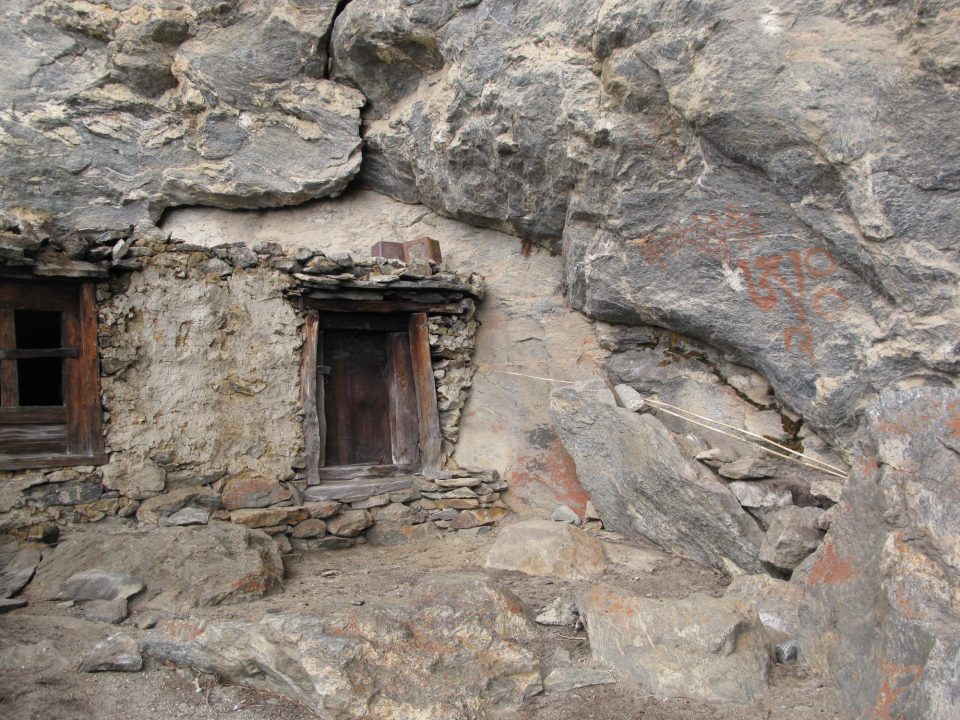
Ngawang Yonten’s hermitage in Charok where he spent many years doing prostrations.
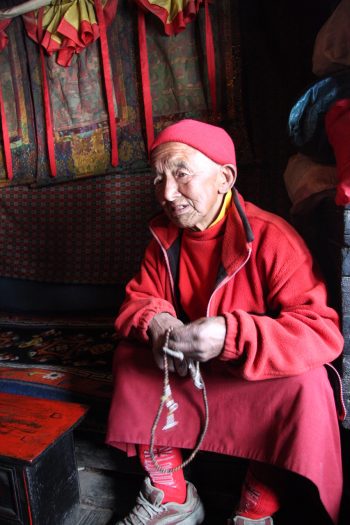
Ashang in his hermitage in Thame gompa, 2013. Photo by Merry Colony.
Later, Ashang bought a house from a nun at Thame gompa which he fixed up and then moved there with his mother till she died.
When Rinpoche returned to Khumbu as the Lawudo Lama, Ashang helped Rinpoche’s mother and sister with the building work and whatever else was needed to establish Lawudo Gompa until Tsultrim Norbu was sent up from Kopan; he also gave his own fields in Mende to Lawudo. Ashang also taught Tibetan to Rinpoche’s sister and brother when they were young, and later to Rinpoche’s niece, who is now a Geshema at Kopan nunnery. Ashang was always helping.
Following the earthquake of 2015, when Ashang’s house was damaged and his health deteriorating, Rinpoche advised him to come to Lawudo and asked Anila Ngawang Samten to take care of him. It’s said that when he left Thame Gompa for Lawudo everyone was crying because they all loved him so much. He was so humble and kind. During a video call in January 2023, Rinpoche told Ashang he had no need to worry at the time of death because he would definitely have a very good rebirth.
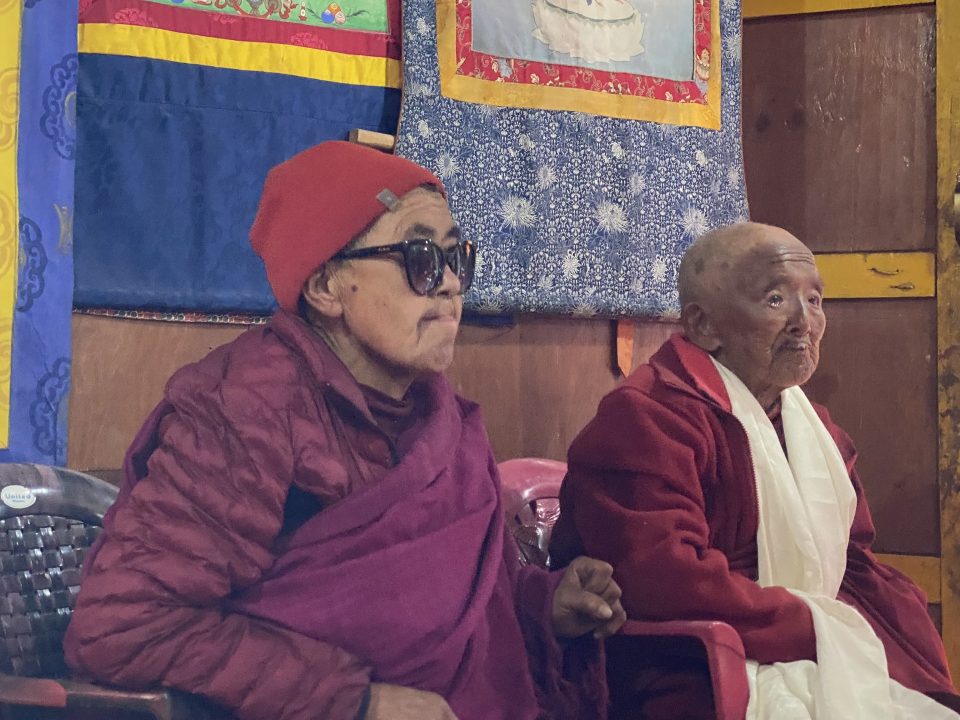
Ashang with Anila Ngawang Samten at a puja immediately after Lama Zopa Rinpoche’s passing, April 2023. Photo Alison Murdoch
At the time of passing, Ashang was very strong and clear in his mind and the next day, Ngawang Nyendak came to recite the prayers for him. The Thame monks along with Charok Lama performed the fire offering rituals with full respect, dressing Ashang in the attire of the Sambogakaya, honoring him as the most senior Thame monk and for his lifetime of practice. It was a very moving ceremony and many locals came from around the valley to help and pay respects. Pujas were also sponsored for Ashang at Kopan and Thubten Choling
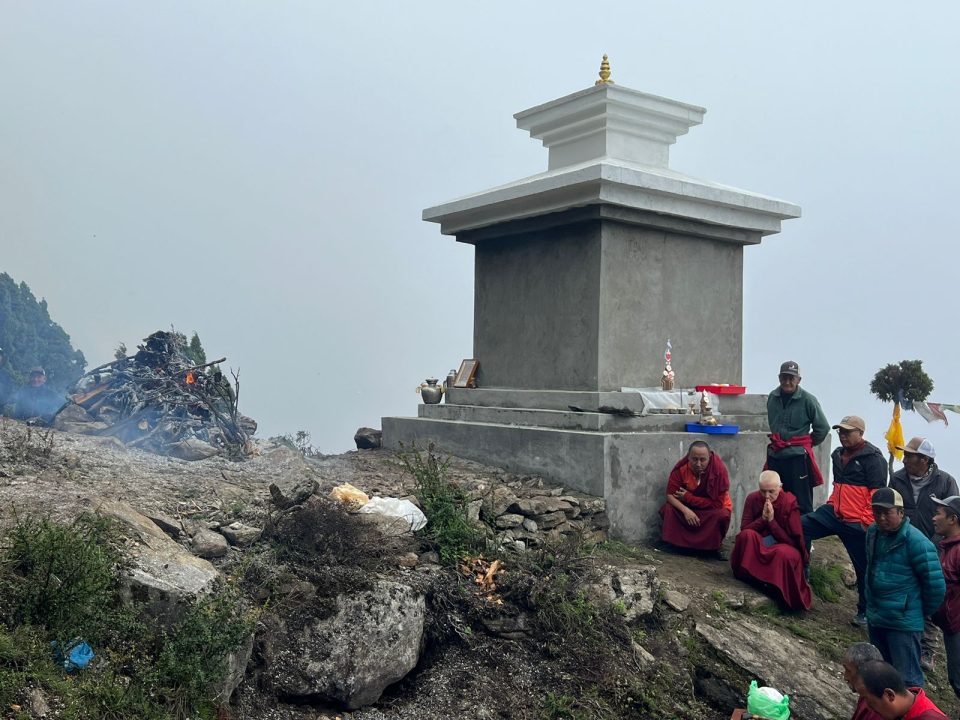
Cremation of Ven. Ngawang Yonten at Lawudo, July 9, 2024.
You can watch a playlist of short video clips of Ashang’s cremation, which occurred on Chokhor Duchen, July 9, 2024.
With tremendous thanks to Anila Ngawang Samten, Gelong Ngawang Nyendak, Jamyang Wangmo, Ven. Tsultrim, Merry Colony, and Alison Murdoch for their contributions and photos.
Please pray that Ven. Ngawang Yonten may never ever be reborn in the lower realms, may he be immediately born in a pure land where he can be enlightened or to receive a perfect human body, meet the Mahayana teachings and meet a perfectly qualified guru and by only pleasing the guru’s mind, achieve enlightenment as quickly as possible. More advice from Lama Zopa Rinpoche on death and dying is available, see Death and Dying: Practices and Resources (fpmt.org/death/).
To read more obituaries from the international FPMT mandala, and to find information on submission guidelines, please visit our new Obituaries page (fpmt.org/media/obituaries/).
- Tagged: obituaries, obituary
3
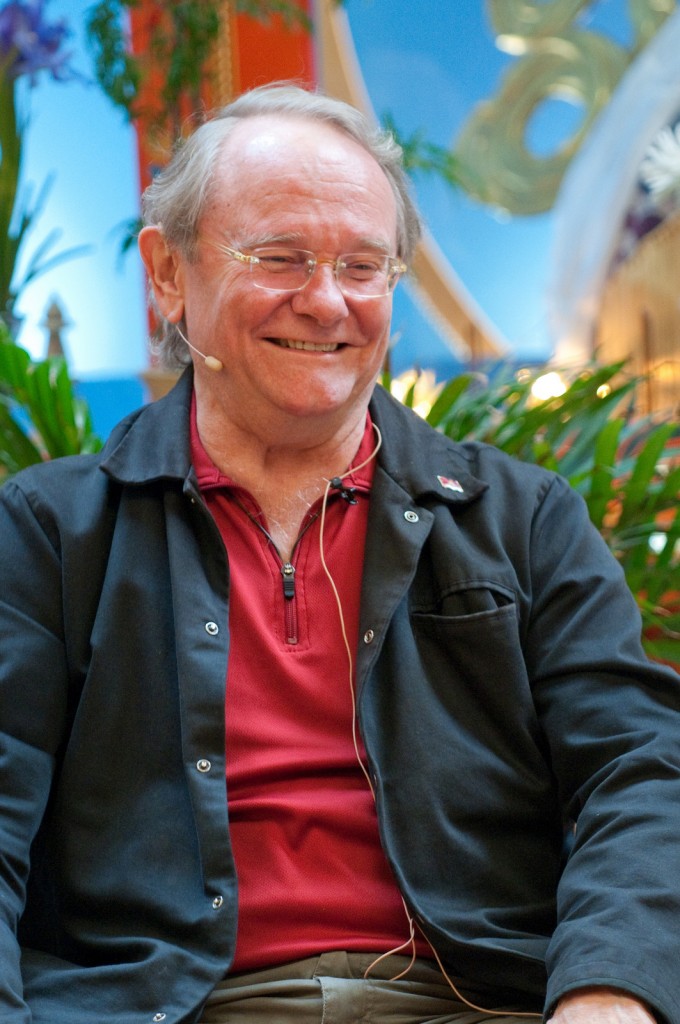
Dr. Jeffrey Hopkins, Maitripa College, Portland, Oregon, United States, September 2011. Photo by Marc Sakamoto.
Beloved Buddhist scholar Dr. Jeffrey Hopkins passed away on July 1, 2024 in Vancouver, Canada, aged 83.
Dr. Hopkins published dozens of books, acted as His Holiness the Dalai Lama’s translator, and had a long academic career during which he trained many prominent Tibetan Buddhist scholars and translators. He was remarkably open in public about a wide range of matters, such as his initial lack of faith in His Holiness, past-life memories, a near-death experience, his youthful delinquency, his sexuality, and so on. Dr. Hopkins was known for his frank and honest style of discussing all matters, even those considered controversial or taboo. He was also an FPMT Registered Teacher in the category “Senior Teachers of the Tibetan Buddhist Tradition.”
He was interviewed in 2014 by Mandala Publications, and we share that interview below.
Dr. Hopkins, what is the source of your frankness? Why are you so open?
I was born in 1940 in Barrington, Rhode Island, and I was in my teens in the 1950s. There was a group of us who were disgusted by the aims that were being presented to us: merely making money and so forth. There was a lot of rebellion that was focused against the dishonesty of society, which gradually in my own mind became a matter of seeking my own integrity. My own integrity meant a great deal to me.
I was part of a juvenile gang that got into difficulty with the law, in the sense of increasingly violent pranks, drinking and so forth. It was a relief when I went to a liberal prep school where students were given a great deal of responsibility for their own governance. Despite all my acting out at my public school, I responded very well in that kind of environment, and got excellent grades, because we were respected as people, which is something I had lacked prior to that. Then, in my first year at Harvard, I read Walden by Henry David Thoreau and I was inspired to leave Harvard for the woods of Vermont. I stayed in a small one-room cabin and read, wrote poetry, walked a lot, dreamt out my recurrent trapped dreams, and I believe at that point, began finding my own integrity. And I kept returning to that kind of life.
I was inspired by Herman Melville’s novel Typee, which is set in the Marquesas, north of Tahiti near the equator, and Somerset Maugham’s The Moon and Sixpence about the artist Paul Gauguin, who painted in the South Seas. It was 1960 and when Vermont got too cold for the wood heater, I went to the woods in Rhode Island. When that got too cold, I shipped out of New York as a passenger on a freighter to Tahiti. I had gotten used to meditating in Vermont on the lake that was down below, and by gazing off into space. On the freighter I would lie on my back and stare upward, filling my mind with the blueness of the sky. The Pacific Ocean was clean and tremendously calm and I filled my mind with that. I didn’t have a visa for Tahiti and after a while some official noticed this and asked me to leave. I used all but my last $15 to take a seaplane to Hawaii. It was nuts, but it was a search for my own integrity.
You were among the earliest scholars to show respect for Eastern scholars, and acknowledge what you learned from them, rather than claiming that you knew more than your “native informants.” Where did your intellectual honesty come from?
This was related to my attitude of searching. Why would I pretend that what l learned from a Tibetan scholar was something I put together myself? Why would I treat these people as somehow different from myself? I thought it was very important, extremely important, to treat every Tibetan scholar fairly, to give them credit for their part in producing any book. I was criticized for this by other professors in my own field. But it just made more sense to have, say, Lati Rinpoche, be a co-author, than to footnote everything he said. In time, people came to understand what collaboration meant. The old saying of “East is East and West is West” doesn’t carry over to how you treat people on the title page of a book.
By making clear what came from others, you revealed that the Western scholar wasn’t always the final expert. Did other academics criticize you for that?
Yes, they did, and I just chose to ignore it. I spoke recently at the Tsadra Translation & Transmission Conference about singing my own song, and what I meant is that certain priorities needed to be righted, and we would right them by how we acted and what we did. It means acknowledging the help you receive and the roles others play, and if those roles are prominent enough, then the person deserves equal billing as the author or the translator. If I couldn’t have understood the text without somebody informing me of its meaning, then that person has played an equal role in its translation even if they don’t know English, because I couldn’t have translated it otherwise. Not to mention the person’s contribution to the footnotes or the explanation that goes along with the translation. This approach has come to be generally accepted. And then also I wanted to point out that many of the academic concerns that Tibetan and Mongolian scholars have are similar to ours. Both sides can learn from the other, though I don’t like talking about sides. I think we are all more or less in the same soup.
Sometimes in Dharma centers people avoid sharing their real views or feelings. This helps maintain harmony, but at a price. It makes me wonder about the balance between building community and nourishing the individual.
I would compare it to when I started in academia. At that time, there was a lot of shouting among scholars. I thought it had a lot to do with how little we knew about the subjects we were talking about. And I had to admit that of myself also. I was so egregiously, embarrassingly ignorant on many of these topics. I could see how I could stumble into trying to cover up my ignorance by shouting or making a big fuss over something I knew that somebody else didn’t know. And then I tried very hard to avoid doing that, and to create an atmosphere in which I was not doing this. I think as this profession and its members have become more educated, there’s been less need to yell at each other, and this may be true in Dharma centers also. I’ve found in the two translation conferences I’ve been to, and many of these translators are members of Dharma communities, that we have no need at all to shout at each other or show off what we know because we are deeply impressed by what we don’t know. We are really happy to hear about these topics from our colleagues and friends who do know something about them. Then it’s easy to get along.
A community’s insistence on people toeing a line may have a lot to do with being neophytes. And the number of times that neophytes repeat the name of their organization or their lama really strikes me as a sign of weakness. Let’s just stop doing that. Still, within the monastic community, there are rules. Outside of the community, you don’t say nasty things about the community, because that disrupts the image of the community, and spreads gossip and so forth. But that implies that there can be criticism within the community. You’ve got to air differences and so forth. You should. But you can’t be arguing all the time, or sharing everything you think. Nevertheless, a healthy community has to have some way of airing what’s going on. You can’t be covering up all the time because it will explode, and the disharmony that will result from that is not going to be helpful.
On a personal level, I try to make the chance of hypocrisy less by admitting in public some of the things that I’m up to. For example, I gave a talk in a city recently and I was really surprised when the people there gave me some money, in envelopes, afterwards. But then also, at the same time, I was very greedy about that money. I kept wondering how much was in each envelope. And I was very careful to put those envelopes down beside me (laughs) so that nobody would walk off with any of them. And I mentioned it to my host afterwards, admitting how greedy I was about it. I try to make this a habit. I don’t make up stuff to disclose, because there’s plenty of it without making anything up. I may not disclose everything, but at least a whole lot of it. Disclosing it relieves tension, whereas hiding is really counter-productive, because when you hide, you have to simulate the opposite – and, wow, you just get into trouble. I get into trouble!
Is this an aspect of the path? Does not being open reduce energy available for practice?
I think that’s very, very true. Energy is wasted by hiding, and what you are hiding gets worse and worse the more you hide it. It’s self-destructive. You know, sometimes when I talk about morality, I’ll just say, “I’m embarrassed about what I am saying, but in any case, I’m trying to present what the books teach as it’s written, and I’m not claiming that I can actually enact this, I want to be clear.” That makes it a lot easier to talk about it. If it’s compassion and the fact that I get angry in certain situations, then it’s easy for me to talk about what I get angry at and use that as an example. Being frank about myself undermines my own negative reactions.
But we have to be judicious about what we say. We can’t be stupidly open. It’s not easy.
Buddhadharma focused its Winter 2014 issue on abuses of power in Dharma communities. One theme was “no more secrets,” because abuses flourish when people deny, cover up, or ostracize those who speak out. What are your thoughts on this?
I’m not an active member of any group. I’m a member of groups, but from a distance, which gives me a certain safety valve. I don’t give any quarter to lamas and so forth who act contrary to moral codes. To me that’s simply improper. If I’m asked about that person, I just say what I’ve heard, I don’t cover up, or at least I hope I don’t. I’m open about what I’ve heard and I’ll say, “Beware.” Covering up or pretending that seemingly ill behavior is the way great lamas behave – I’m just not going to say that. I think that’s simply wrong.
You have mentioned that your relationship with His Holiness the Dalai Lama is very frank. How open should we be with our lamas?
It depends on what the lama can stand! The lama may not want to hear about it. And then what can you do? You may have to go find some other lama, if that’s what you need. Like with anyone, your friends for example, there are certain subjects that some people don’t want to hear about. Even your closest friend may not want to hear about your stomach troubles. So you don’t talk about it. And how much can anyone stand to hear about your sex life? Or your health problems? Even if you’re at death’s door, five minutes is the max. It’s a bore. You shouldn’t expect more than that.
Westerners seem to value openness more than Tibetans. Is there a cultural difference?
I don’t think Tibetans are different from us. Maybe they are getting away with being secretive about how they are running things here (laughs). They are just getting away with pretending that this is the way that they do it. Tibetans among themselves give each other a hard time. They hold each other to account. Whereas some of them come over here and act as if they are kings or queens. They’ll do whatever they can get away with. You don’t have to let them.
Some Westerners, like you, say they have past life memories. While this may come from a desire to be special, there must be some who really were practitioners in the past. Should people be open about memories if they have them? What about the narcissism factor?
I was faced with this during the five years I was at Geshe Wangyal’s monastery in New Jersey in the early 1960s. People would come to visit and talk about their past lives. They were usually princes and princesses. I was looking forward to the day when someone would come and say they were a garbage collector. It’s something that kept me from telling my own story because I didn’t want to be put in the category that I was putting these people in, which has to do with their own aggrandizing imaginations. With myself, I felt what memories I had were rather ordinary. I had to inspect those few memories to figure out what my so-called status was. I didn’t feel glorious. I had to deduce from a few pieces of information what my status might have been. It took a long time for that to come through. I’m suspicious of people who remember themselves as having been very glorious.
Still, I stay neutral on whether people should talk about memories. Although I’m suspicious, I’m not going to put it down. I know in my case that these are actual memories, so I know that does occur. But I wouldn’t blame anyone for being highly suspicious if I told my own story in any detail. They might think, “The guy’s a nut!” I’ve had that kind of thought with respect to others. But some people have related their stories to me, and their memories are not self-glorifying. I don’t have any reason to question them. I do accept for sure that people remember.
Dr. Ian Stevenson of the University of Virginia looked into a lot of reincarnation stories, and checked some against facts he could track down. One of the points that he made was that quite a number of people remembered their past lives because they died in the midst of violence. It was quite often not a case of great spiritual attainment, but that there was some violence that impressed on them what was going on, and that caused the memory.
Canadian tulku Elijah Ary has been open since childhood about his past life memories and went through a lot of difficulties.
I know Elijah Ary. I find his story quite poignant. He and I had quite opposite trails. He has been open throughout and I’ve been closed throughout. I actually forgot it for quite a while and then even after I remembered, it was decades later that I was willing to talk about it at all except with a couple of people. It’s been quite a journey for him, and I really respect what he’s had to go through to be this open. He paid a huge price. For me, coming out as gay was a big step at the time I did it, but coming out as remembering your past life, as far as I’m concerned, is much larger than that.
What does it really tell us if someone has past life memories? Does that make them special now?
I think that Dr. Ian Stevenson’s story about people remembering because they died in the midst of violence indicates that it doesn’t automatically make you special. What will make you special is what you do in this lifetime. If you think about it, that is true of anybody, recognized or not.
Liushar Thupten Tharpa, who was the equivalent of foreign minister in the old government of Tibet, went out to greet His Holiness the Dalai Lama when he first came to Lhasa; Liushar told me he was watching the little child to see if this was the right one. But he didn’t come to any conclusion then whether this was the right or the wrong child. Later he was this Dalai Lama’s representative in New York, after which he came to our monastery in New Jersey, and then stayed on in the USA as a permanent resident. Then the Dalai Lama called him back to Dharamsala. There were a number of years during which Liushar had not seen this Dalai Lama in action on the home front, although he had visited India for important events. Anyway, after he went back to India, I saw him. He said, “Do you know what he is doing?” and he recounted to me how busy this Dalai Lama was conducting ordination ceremonies, teaching, giving initiations, all of the many things he was doing. And he said, “Now we can say he is the incarnation of Avalokiteshvara.” You see? By way of his actions! That question about whether there were signs that he was the last Dalai Lama was totally wiped out. It didn’t matter. His Holiness’ actions were sufficient. Whether he was or not didn’t make any difference because in his waking day he was endlessly performing these actions.
While you are open about many things, you also choose to keep certain things private, such as your own attainments, and ways you’ve helped others – for example, with their books or academic work.
There’s a tradition about not being open about your own attainments and your own deeper experiences, and I don’t even tell my friends. It’s out of the question, I feel, that I’m going to talk about these things. As for helping others, it’s important to do – and keep quiet.
Any final thoughts on honesty?
If honesty became one’s only watchword, one could become a pain in the ass, and narcissistic, and a total bore. I hope by giving an interview like this, pretending to be honest, I don’t create a trap for myself! That I would become infatuated with this – really. And start deliberately acting this way, thinking, “I’ve got to be honest! I’ve got to find something to be honest about!” And turning myself into not just a 25- or 50-percent jerk but a 75- or 90-percent jerk (laughs). Warn me if I do. Tap me on the shoulder and say, “Hey Jeffrey, you are turning into a 100-percent jerk.”
We are basically incapable of saying who we are, and when we start doing that, we really have to be careful, because we aren’t going to be right. There may be some grain of truth – but also some grain of foppishness. I’m trying. I’m still trying to find my own integrity.
Previously published as an online feature of Mandala Publications, “Jeffrey Hopkins’ Transmission of Honesty,” an interview conducted by Donna Brown, January 2015.
You can listen to Dr. Hopkins in a lively conversation about his life with Wisdom publisher Daniel Aitken in the Wisdom podcast, “Jeffrey Hopkins: The Life of a Buddhist Scholar: wisdomexperience.org/wisdom-podcast/jeffrey-hopkins/
Please also see Tricycle magazine’s obituary of Dr. Hopkins: tricycle.org/article/jeffrey-hopkins-obituary
Please pray that Dr. Jeffrey Hopkins may never ever be reborn in the lower realms, may he be immediately born in a pure land where he can be enlightened or to receive a perfect human body, meet the Mahayana teachings and meet a perfectly qualified guru and by only pleasing the guru’s mind, achieve enlightenment as quickly as possible. More advice from Lama Zopa Rinpoche on death and dying is available, see Death and Dying: Practices and Resources (fpmt.org/death/).
To read more obituaries from the international FPMT mandala, and to find information on submission guidelines, please visit our new Obituaries page (fpmt.org/media/obituaries/).
- Tagged: jeffrey hopkins, obituaries, obituary
19
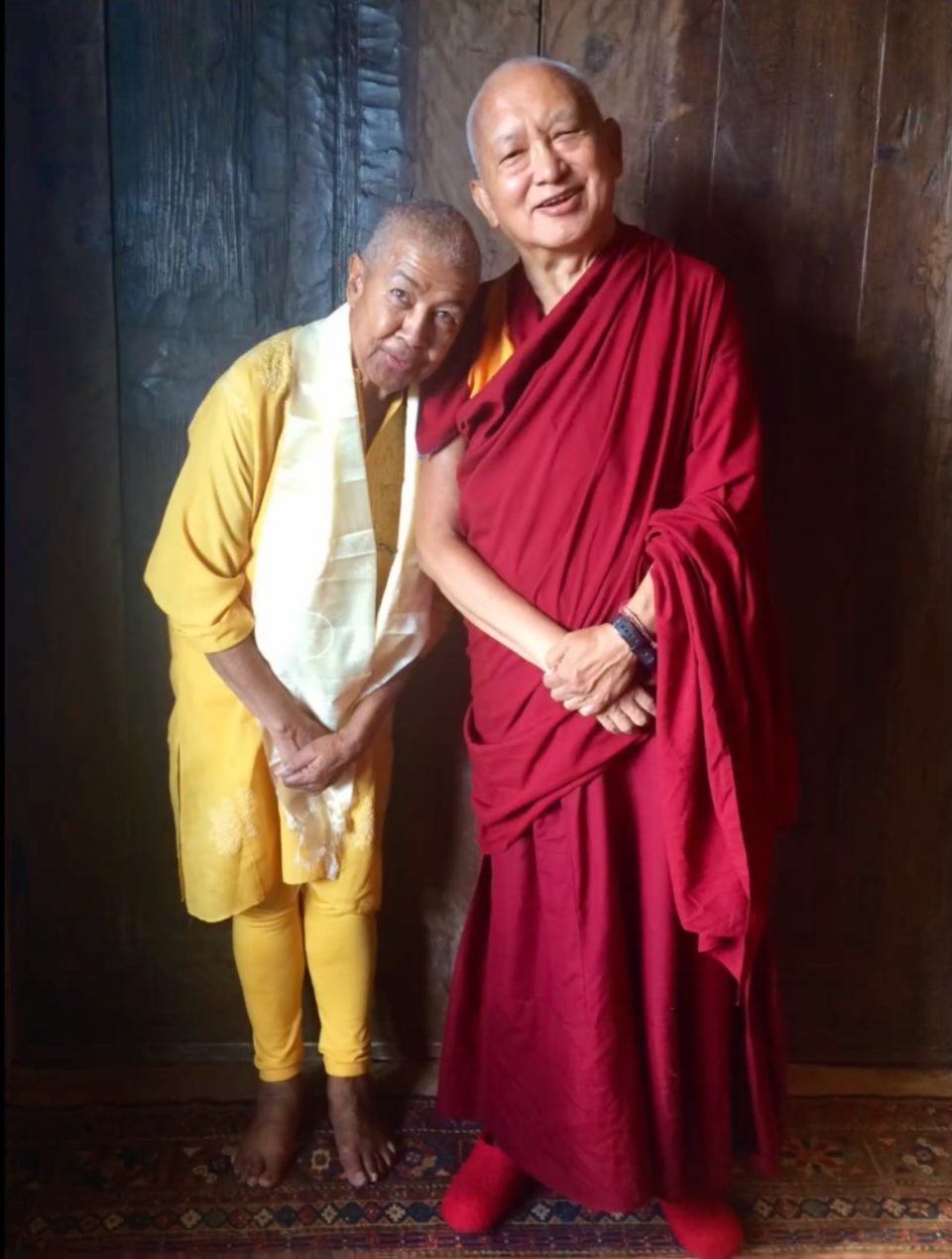
Mummy Max Mathews with Lama Zopa Rinpoche. Photo by Steve Nadeau, courtesy of the Lama Yeshe Wisdom Archive.
The entire FPMT community shares the loss of one of FPMT’s precious pioneers, “Mummy” Max Mathews (also known as Sister Max), who passed away on February 16, 2024. We also share a sense of rejoicing in the kindness and generosity she offered in her life, to which the entire FPMT organization owes immeasurable thanks.
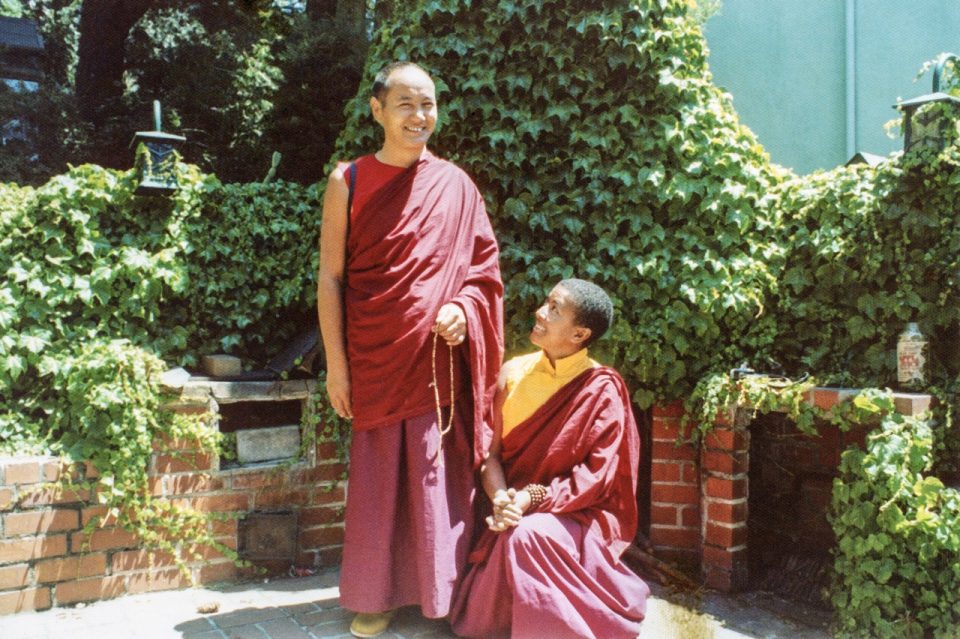
Lama Yeshe and Mummy Max in Berkeley, California, 1974. Photo courtesy of the Lama Yeshe Wisdom Archive.
Mummy Max contributed greatly and financially assisted Lama Yeshe and Lama Zopa Rinpoche in establishing Kopan Monastery and the FPMT organization.
As we put together a tribute honoring her life, we invite you to watch this interview from 2020, in which she shares spontaneous and intimate stories of her timeless relationship with Lama Yeshe and Lama Zopa Rinpoche and how she provided unconditional and essential support for the lamas’ projects as envisioned by His Holiness the Dalai Lama. This interview was filmed in July, 2020 in Santa Fe, New Mexico with images from Big Love: The Life and Teachings of Lama Yeshe.
Mummy Max explains in Volume One of Big Love: “I felt I had come home and that Lama Yeshe was my guru. He just opened me up completely. I felt balanced and whole, like I was walking on air. I also felt committed. There was no going back.”
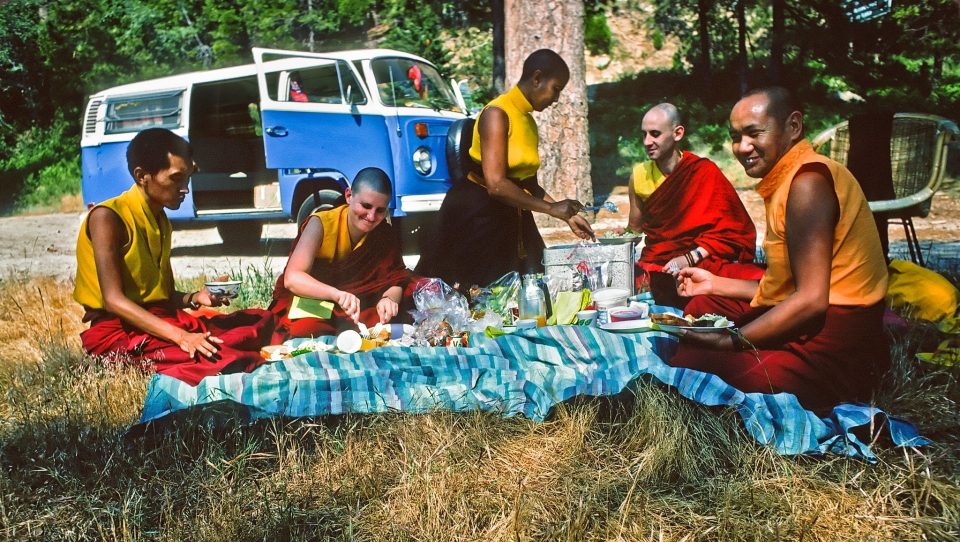
Mummy Max Mathews (center kneeling) with Lama Zopa Rinpoche, Thubten Wongmo, Nick Ribush, and Lama Yeshe, enjoying a picnic in Lake Arrowhead, California, 1975. Photo courtesy of the Lama Yeshe Wisdom Archive.
At the end of this inspiring video, Mummy Max shared: “The lamas gave me a reason to be. And it’s been my whole life. It’s the only thing that has made meaning in my life. It’s what the lamas have given me and tried to instill in me. It’s unreal. It’s unbelievable how much love and compassion they have. And I hope my life has been worth meaning for them. I tried, but I had such a long way to go. … I’m so grateful. I owe everything to the Tibetans. And anyone who gets a chance, if you pass it up, you’ll miss the greatest opportunity you’ll ever have. Thank you.”
Please pray that Mummy (Sister) Max Mathews may never ever be reborn in the lower realms, may she be immediately born in a pure land where she can be enlightened or to receive a perfect human body, meet the Mahayana teachings and meet a perfectly qualified guru and by only pleasing the guru’s mind, achieve enlightenment as quickly as possible. More advice from Lama Zopa Rinpoche on death and dying is available, see Death and Dying: Practices and Resources (fpmt.org/death/).
To read more obituaries from the international FPMT mandala, and to find information on submission guidelines, please visit our new Obituaries page (fpmt.org/media/obituaries/).
- Tagged: mummy max, obituaries, ven max mathews
2
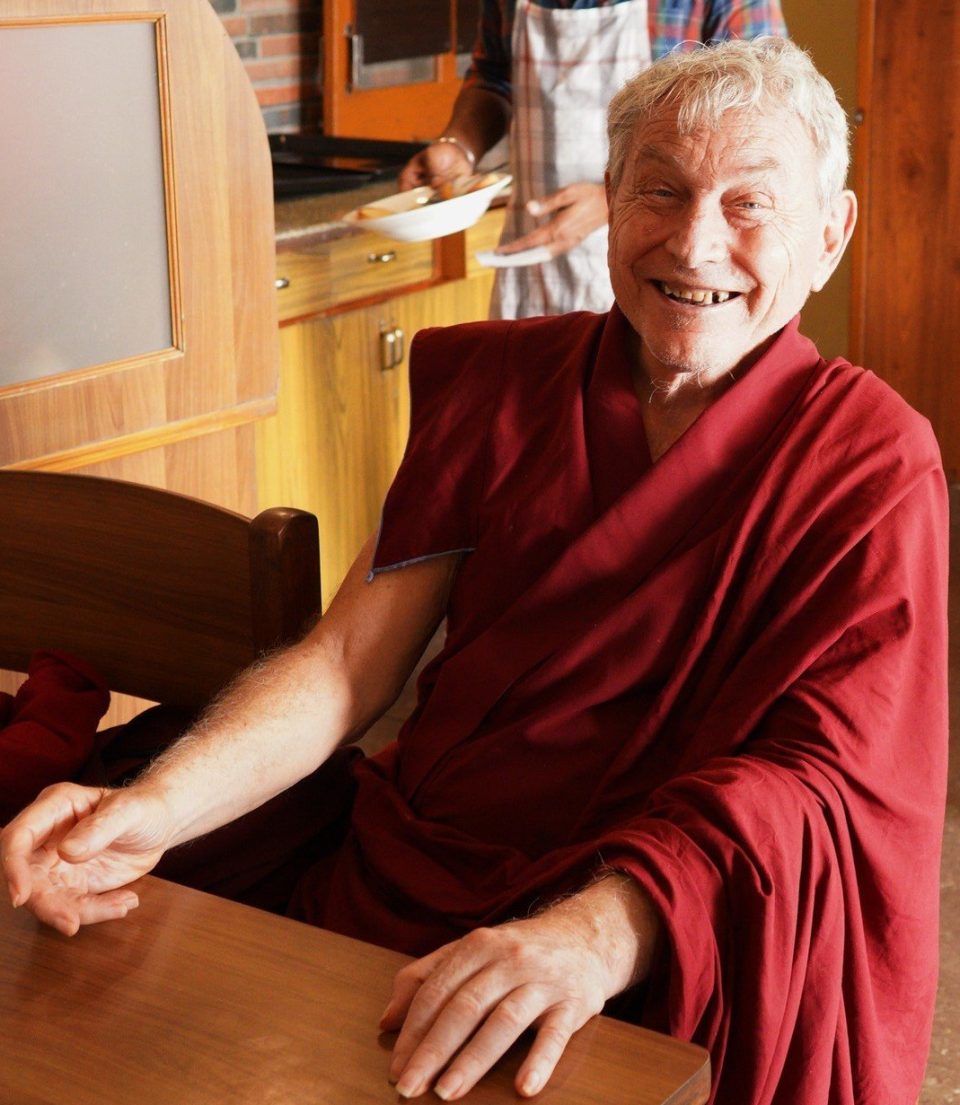
Ven. Thubten Gelek (Max Redlich) in Dharamsala, 2022. Photo courtesy of Tara Institute Facebook page.
Venerable Thubten Gelek (Max Redlich) passed away on November 26, 2023 in New Delhi, India.
Venerable Gelek, born July 13, 1944, was an IMI sangha member who offered many decades of service to the Dharma, starting in the early years of the FPMT organization. Below we share words from friends, and passages from Big Love: The Life & Teachings of Lama Yeshe, to celebrate Ven. Gelek’s devoted service to Lama Yeshe, Lama Zopa Rinpoche, and the FPMT mandala.
An excerpt from the Tara Newsletter by Pete Giuliano gives praise to Ven. Gelek’s contributions to Tara Institute in Melbourne, Australia:
“Max was instrumental in the founding of Tara Institute in the early formative days of the center. He had been Co-Director of Tara House with Uldis Balodis in Kew up to 1982 . At the completion of his service, Lama Yeshe apologized for having pushed him too hard. Max did a lot of the work in finding 3 Crimea Street and famously predicted we would outgrow it within five years. We moved to Mavis Avenue in 1987, where he stayed with us over several different periods. He has been based in India for many years but would often return to Melbourne.
Adele Hulse, the author of Big Love shares about Ven. Gelek:
“His father was from a family of successful Jewish butchers and Redlich Butchers is still trading. His mother was a non-Jewish woman from Vienna, a model who once had to pose for Hitler. Max got into the meat trade. He wore white boning-room clothes and white boning-room boots and had a car and a driver because he was so busy and so successful. Then he heard Lama Yeshe speak in Melbourne and realized he had to change his entire life.”
More from Adele on her memories of Ven. Gelek:
“I had a very young child who was in and out of hospital when Max asked me if I would run a fashion business, importing from Ven. Marcel in Kathmandu and from the Delhi Centre. I had no business experience whatsoever. A week later $150,000 worth of baled stock arrived at my house and I ordered racks and got a secretary. Max arrived early every morning for a week, bearing beautiful fruit and cakes from Acland Street and made me breakfast while lecturing me about business. He started at the beginning and ended by telling me how you close a business. Everything happened just as he said it would. Three years later it was time to shut the business down because the purpose had been served – to create a profile to convince a bank to give a loan – and we were not in the fashion business. Max was unfailingly kind and patient and wrote me long letters about business.
I still have them.”

Max Redlich, Dharamsala, 1978. Photo courtesy of Nick Ribush.
Longtime Lama Yeshe Wisdom Archive director, Nick Ribush, recounts Ven. Gelek meeting the Dharma:
“I knew Max in Melbourne in the 60’s, several years before either of us had even heard the word ‘Dharma.’ I didn’t know him well, but he did seem to live the fast, high life of someone with plenty of money. Then, after I had left Australia in 1972 and finished up at Kopan, I didn’t hear of or from him until 1977, when I was giving a ten-day meditation course near Melbourne and he came up to see me there. He looked very cool, with long red hair down to his waist and a beautiful svelte girl on his arm, wondering what it was that I and, by now, many of his friends had gotten into. He wasn’t about to stay for any of the course, so I told him that if he really wanted to know he’d have to go to Kopan for the November course and hear it directly from the Lamas themselves. He did, and the rest is history.”
A excerpt from Big Love shares this first experience at Kopan in Ven. Gelek’s own words:
Many of his friends had become Lama’s students, but he found their devotion ridiculous. “[Lama Yeshe] was talking about emptiness and this guy asked if you would lose your personality if you realized emptiness. Lama said, ‘No!’ and shrieked with laughter. The guy was ready with more questions, but Lama was just bursting with laughter and I think that’s when he got me.”
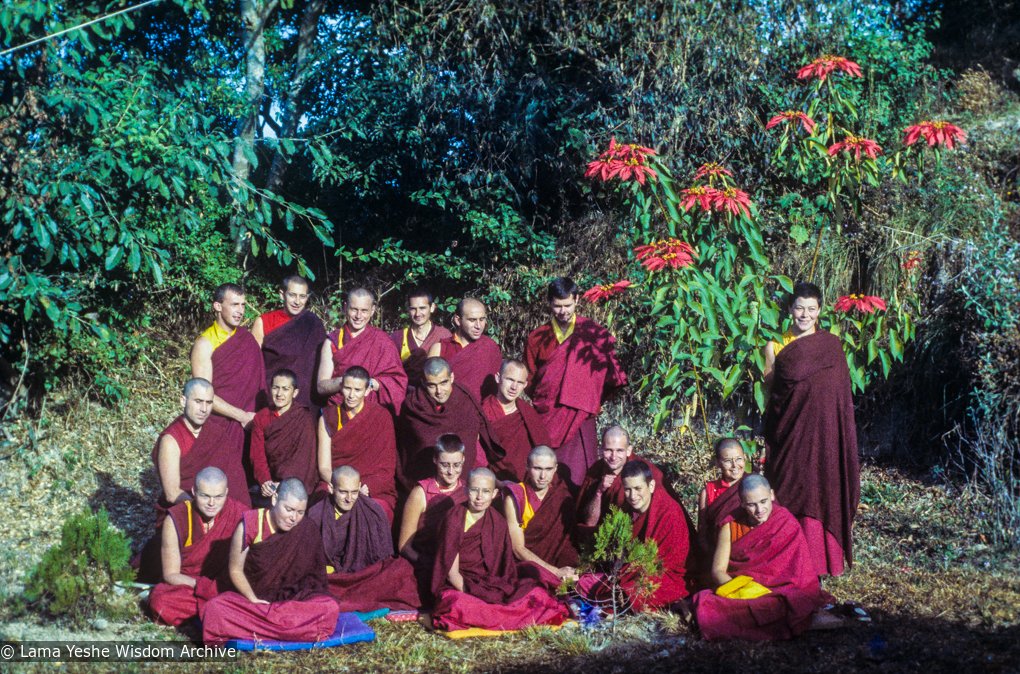
Ordination group with IMI sangha at Kopan Monastery, Nepal, January 1979. Ven. Max is pictured back row, third from left. Photo Courtesy LYWA.
More from Big Love on Ven. Gelek’s early connection and service to Lama Yeshe:
At first skeptical of the level of devotion evident among so many of his friends, Max had changed after watching his father die. He became super-devoted and ran around trying to do good in any way he could. Lama called him “Max Relics” and found plenty for him to do. There was no end to Lama’s orders and Max tried to do it all.
“One day I was tearing around trying to do everything as usual and a drop of rain fell,” Max recalled. “So I raced around, found an umbrella and came back only to tear off to do something else. I was erratic and overly busy. Lama just gave me this disparaging look, shook his head and said, ‘Jewish army!’ I’d been in the Israeli army during the Six-Day War in 1967, so Lama was indicating I was anything but disciplined. Whenever we were looking for praise, he made sure we didn’t get it.”
… Max was asked to help Lama Yeshe pack. “I gathered it was a big deal to be asked to do this, but I had no idea what to do. I was just standing there waiting for instructions when Lama asked me to sit on the bed. I had a hunch he was about to play a trick on me and sure enough, a rubber spider suddenly appeared. He thought it was so funny when I instinctively moved out of its way. I stood up and Lama actually picked me up and walked with me around the room, carrying me. Lama Zopa Rinpoche was there too. I just didn’t know what to think,” Max recalled.
“[1978] Then it was time to go. Lama sat in a rocking chair in this big sitting room at the back of Manjushri Institute and about a hundred people lined up to say goodbye to him. They came in the door and bent low as they gave him a khata. The warmth and love between them each time was palpable. He treated each individual student as if they were the only one in the whole world, even though they were with him for just sixty seconds. It actually gave me some idea of what he meant when he said, ‘Communicating, dear? You communicating?’ Lama definitely communicated.
“I assumed it was Nick who had arranged for me to become Lama’s lay attendant that time. He knew I had made quite a lot of money from my business in Melbourne and probably thought that if I had the privilege of carrying Lama Yeshe’s bags to London I would become more interested in the Dharma. Then they could get some money out of me.” Max had made his fortune in the meat trade. Lama Yeshe got him to set up a number of businesses associated with Dharma centers to “purify” the money, but not all were successful.
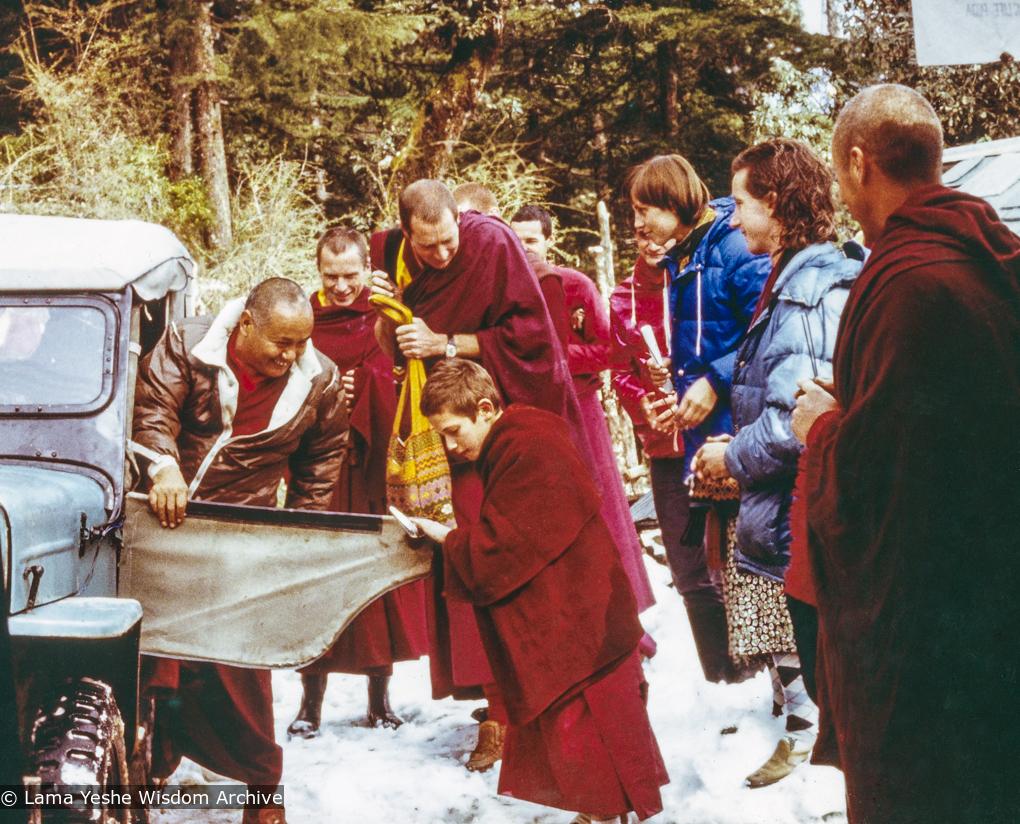
Lama Yeshe, left with Ven. Max Redlich (Thubten Gelek) back left, Ven. Thubten Gyatso, and Ven. Thubten Wangchuk, during the First Enlightenment Experience Celebration at Tushita Meditation Centre, Dharamsala, India, 1982. Photo courtesy LYWA.
Peter Kedge, a longtime FPMT student and former member of the FPMT Inc. Board of Directors, offered the following words when hearing of Ven. Gelek’s passing:
“Max was always so kind and helpful. I traveled with Lama and Rinpoche and organized their world teaching tours from 1976 to 1979. There was no money apart from that which centers sent in advance and some couldn’t manage that. We had to use cash and traveler’s cheques which made travel quite difficult. Max was a serial entrepreneur and ran a successful business in Melbourne.
“He asked how he could help with the tours and when I explained, he immediately arranged a Diners Club card which we could use and then reimburse Max when the bills were due. That was a huge help and one of many ways Max helped Lama and Rinpoche develop FPMT.
“He was always thinking of ways to make money for FPMT. When we were first trying to establish business in Hong Kong, Max opened an electronics store in Melbourne so we could ship electronic goods to him.
“Later after Lama Yeshe had passed, Rinpoche wanted to ask Osel some important question. Rinpoche asked Max to personally represent him and ask Osel. Rinpoche’s reason to ask Max was that Max had had a very pure relationship with Lama Yeshe and so was the right person to approach Osel on Rinpoche’s behalf.
“Max served and contributed in many often unseen and unsung ways.”
John Douthitt (Pelgye) recounts Ven. Gelek’s role in his taking ordination and some stories Ven. Gelek shared with him:
“In 1977 Max and I sat our first Kopan course together and quickly became friends. I arrived determined to be a monk, I would have taken robes the day I arrived had that been an option. Max spent the entire month coming up with one reason after another why I should NOT take ordination. I did take ordination after the course and then heard that someone had anonymously offered a generous yearly donation to cover my needs. I didn’t know anyone who had spare money except Max so I asked him and yes, it was him. I said, ‘But you’ve been trying to convince me to NOT take ordination.’ He told me he had wanted me to be sure it was what I really really wanted because it was too important of a decision to make without fully thinking it through.
He was, back then, wealthy. He’d figured out how to take the unwanted scraps of meat production and make them into something which WAS wanted. He told me stories about buying a Bentley solely on the basis that it was the only car he could find which was more expensive than a Rolls Royce and he had one of the 3-4 cellphones in the whole of Australia at the time in his Bentley; another of those cellphones in his other car.
He told me that he lived in a simple one bedroom apartment but, since he could, he figured he ought to buy a bluestone, one of the most expensive houses he could buy. After rattling about in that big house for a spell, he put in a ramp so he could drive his motorcycle up into the front room but eventually that lost its luster, too, and he realized that he was not occupying hardly any more space in the house than he had in the one bedroom apartment so he sold he house and moved back to a small apartment.
From longtime IMI sangha member, Wongmo,
“Max and I were quite close friends when we lived at Tushita Retreat Center, as it was known in those days…late 70’s-mid 80’s. He was an interesting character, having had an energetic youth and then Dharma practitioner. He’d tell me colorful stories of being in the family abattoir business in Australia.
“Max was known for his penchant to forever be searching for mystic, psychic observations. He’d carry around his I Ching book that was so well used that its pages were torn and dirty. Goodness only knows what questions he had for people he found for mos, predictions, and so on. He even traveled all the way to Land of Medicine Buddha in California to be near Pemo, to ask her for mirror readings.
“Our dear Max suffered from strong rlung (Tib.; Sanskrit: prana), and would often hold his hand to his heart area while speaking with you.
“He was so enthusiastic about the teachings, lamrim and so on, and well spoken, that I’d beg him to teach courses at Tushita but all he ever agreed to do was lead group discussions, which people so enjoyed. Then he served as director of Tushita for a couple of years.
“After Lama Yeshe’s passing, Rinpoche asked Max to oversee the building of Lama’s stupa at Tushita. Max did complete that project, but with great difficulty trying to organize the local Indian builders and so on. After that Max wanted to do some retreats but Rinpoche asked him to oversee the building of Gen Jampa Wangdu’s stupa.
“There was something about Max that made it just so interesting and nice to be around him.”
After hearing news of Ven. Max’s passing, Geshe Kelsang Wangmo put in prayer requests for Ven. Gelek at a number of monasteries in India, and Tushita Meditation Centre in Dharamsala requested prayers from His Holiness the Dalai Lama and many other high lamas. Its was reported that His Holiness made prayers holding a photo of Ven. Gelek at his heart. Chokyi Nyima Rinpoche offered prayers in front of relics of the Buddha while in Vietnam. Tushita also made generous offerings on Ven. Gelek’s behalf to the many meditators surrounding Trijang Rinpoche’s stupa in Dharamsala on Lama Tsongkhapa Day, December 8, 2023.
Ven. Gelek was cremated in Delhi, India on December 2, 2023. Kabir Saxena, spiritual program coordinator of Tushita Meditation Centre in Delhi and longtime friend of Ven. Gelek, asked Ajeer Vidya, who was born in the same village as the renowned Kunu Lama Rinpoche (who gave teachings to His Holiness the Dalai Lama on Shantideva’s famous text), to oversee the cremation and immersion of Ven. Gelek’s ashes in Delhi. Ajeer met Ven. Gelek some years ago and respected him. Following the cremation, Ven. Gelek’s ashes were immersed into the Yamuna River, which flows through Delhi and meets the Ganga,(Ganges), before the latter reaches Benares (Varanasi).

The body of Ven. Gelek being prepped for cremation.
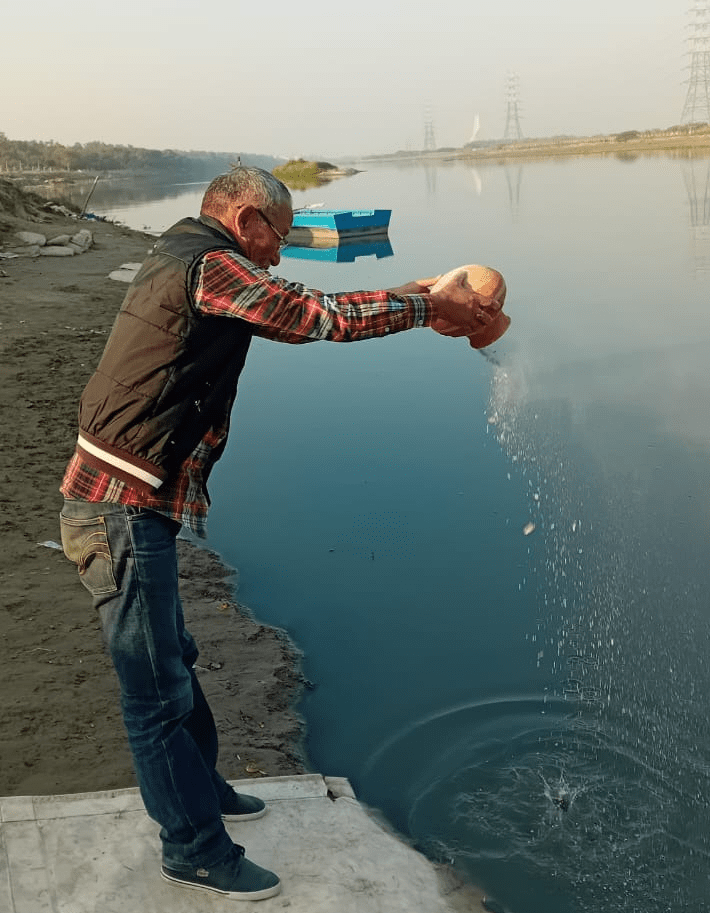
Ajeer Vidya immersing Ven. Gelek’s ashes into the Yamuna River, which flows through Delhi and meet the Ganga,(Ganges), before the latter reaches Benares (Varanasi).
Please pray that Ven. Gelek may never ever be reborn in the lower realms, may he be immediately born in a pure land where he can be enlightened or to receive a perfect human body, meet the Mahayana teachings and meet a perfectly qualified guru and by only pleasing the guru’s mind, achieve enlightenment as quickly as possible. More advice from Lama Zopa Rinpoche on death and dying is available, see Death and Dying: Practices and Resources (fpmt.org/death/).
To read more obituaries from the international FPMT mandala, and to find information on submission guidelines, please visit our new Obituaries page (fpmt.org/media/obituaries/).
- Tagged: obituaries, obituary
19
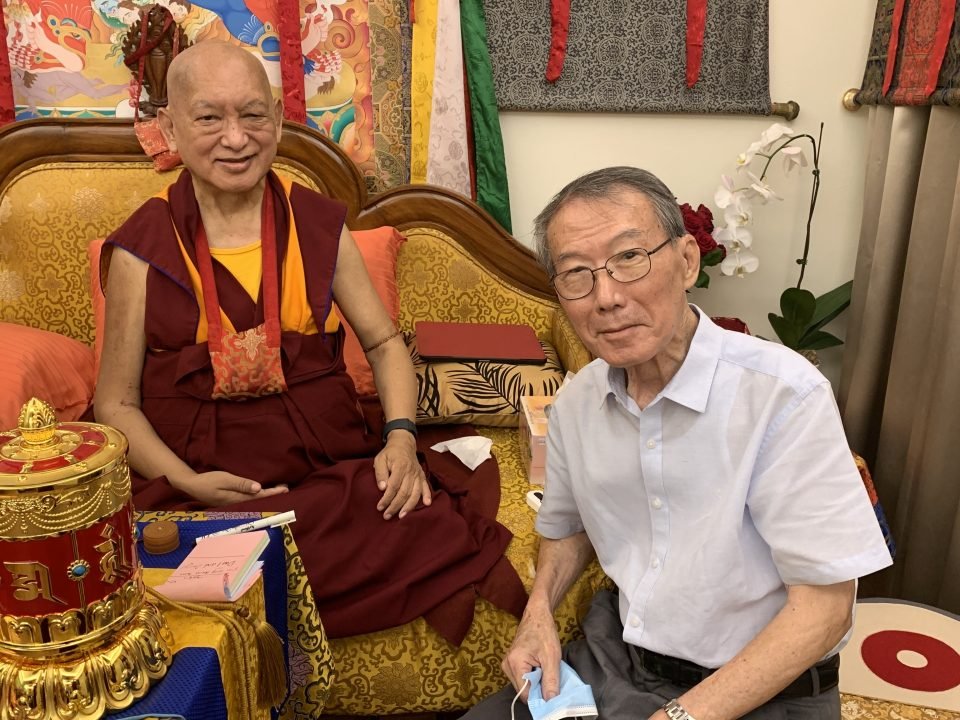
Lama Zopa Rinpoche with Sim Hong Boon, August 2022. Photo by Ven. Holly Ansett.
Sim Hong Boon passed away of cancer on August 13, 2023 at age 76 in Singapore.
Sim Hong Boon was a longtime member of the FPMT Inc. Board of Directors and helped the Maitreya Project.
He was an ardent supporter of Amitabha Buddhist Centre in Singapore, since its founding in 1989. ABC Director, Hup Cheng, shares some details about Mr. Sim’s contributions.
Sim Hong Boon has contributed substantially to the growth of the Amitabha Buddhist Centre. He was appointed by Kyabje Lama Zopa Rinpoche to oversee the construction of the new building at 44 Lorong 25A, Geylang. Mr. Sim, an architect by profession, drew up the plans for the new building, submitted to the authorities for approval, and put it out to tender for the construction. He did this all by himself, to save costs, and he even waived his professional fees. We are deeply deeply grateful to Mr. Sim for this monumental task of completing the new building for ABC.
Mr. Sim was appointed by Rinpoche to be a trustee of ABC’s Board of Trustees, in 2005. The trustees are appointed to hold the fixed assets of the center.
In 2018, when the ABC childcare center needed to be expanded, he again offered his services to build an additional wing so we could accommodate more pre school children.
Mr. Sim has been a pillar of strength behind ABC’s growth in the last 35 years. His contribution has been outstanding. We would not have come this far without the enormous effort put in over the years. We will miss Mr. Sim’s presence, but he has left behind an enduring legacy, that will benefit many future generations.

FPMT Board of Directors Meeting, Land of Medicine Buddha, California, USA, May 17, 2004. Photo by Ven. Roger Kunsang. Sim Hong Boon is top row, far right.
Please pray that Sim Hong Boon may never ever be reborn in the lower realms, may he be immediately born in a pure land where he can be enlightened or to receive a perfect human body, meet the Mahayana teachings and meet a perfectly qualified guru and by only pleasing the guru’s mind, achieve enlightenment as quickly as possible. More advice from Lama Zopa Rinpoche on death and dying is available, see Death and Dying: Practices and Resources (fpmt.org/death/).
To read more obituaries from the international FPMT mandala, and to find information on submission guidelines, please visit our new Obituaries page (fpmt.org/media/obituaries/).
- Tagged: obituaries, obituary
- Home
- News/Media
- Study & Practice
- About FPMT Education Services
- Latest News
- Programs
- New to Buddhism?
- Buddhist Mind Science: Activating Your Potential
- Heart Advice for Death and Dying
- Discovering Buddhism
- Living in the Path
- Exploring Buddhism
- FPMT Basic Program
- FPMT Masters Program
- FPMT In-Depth Meditation Training
- Maitripa College
- Lotsawa Rinchen Zangpo Translator Program
- Universal Education for Compassion & Wisdom
- Online Learning Center
- Prayers & Practice Materials
- Overview of Prayers & Practices
- Full Catalogue of Prayers & Practice Materials
- Explore Popular Topics
- Benefiting Animals
- Chenrezig Resources
- Death & Dying Resources
- Lama Chopa (Guru Puja)
- Lama Zopa Rinpoche: Compendium of Precious Instructions
- Lama Zopa Rinpoche: Life Practice Advice
- Lama Zopa Rinpoche Practice Series
- Lamrim Resources
- Mantras
- Prayer Book Updates
- Purification Practices
- Sutras
- Thought Transformation (Lojong)
- Audio Materials
- Dharma Dates – Tibetan Calendar
- Translation Services
- Publishing Services
- Teachings and Advice
- Find Teachings and Advice
- Lama Zopa Rinpoche Advice Page
- Lama Zopa Rinpoche: Compendium of Precious Instructions
- Lama Zopa Rinpoche Video Teachings
- ༧སྐྱབས་རྗེ་བཟོད་པ་རིན་པོ་ཆེ་མཆོག་ནས་སྩལ་བའི་བཀའ་སློབ་བརྙན་འཕྲིན།
- Podcasts
- Lama Yeshe Wisdom Archive
- Buddhism FAQ
- Dharma for Young People
- Resources on Holy Objects
- Ways to Offer Support
- Centers
- Affiliates Area
- Teachers
- Projects
- Charitable Projects
- Make a Donation
- Applying for Grants
- News about Projects
- Other Projects within FPMT
- Support International Office
- Projects Photo Galleries
- Give Where Most Needed
- FPMT
- Shop
Translate*
*powered by Google TranslateTranslation of pages on fpmt.org is performed by Google Translate, a third party service which FPMT has no control over. The service provides automated computer translations that are only an approximation of the websites' original content. The translations should not be considered exact and only used as a rough guide.To put an end to our samsaric suffering, we must do two things: One is to purify the negative actions we’ve done every day of our lives and in our infinite previous lives as well. We also have to change our minds and actions and abstain from creating further negativities.







